Early Views of Westwood
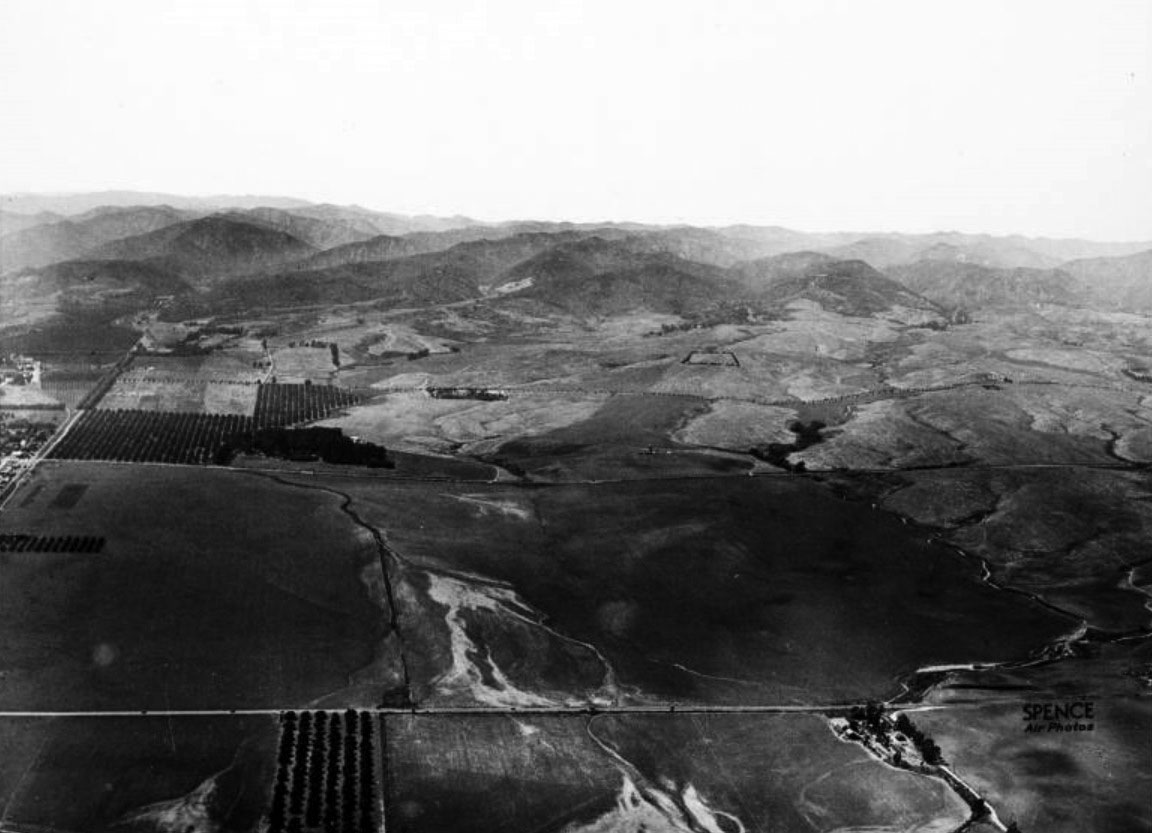 |
|
| (1922)* - Aerial view looking north showing Westwood, in West Los Angeles, with Pico Boulevard running from left to right in the foreground. Santa Monica Blvd runs horizontally across the center of photo with Wilshire Blvd being the next horizontal road to the north. Part of the Wolfskill Ranch house can just barely be seen at the center-right edge of photo, just north of Wilshire Blvd. Sepulveda Boulevard is seen on the left running up to the Sepulveda Pass. |
Historical Notes Westwood was developed on the lands of the historic 'Wolfskill Ranch', a 3,000-acre parcel that was purchased by Arthur Letts, the successful founder of the Broadway, and Bullock's department stores, in 1919. Upon Arthur Lett's death, his son-in-law, Harold Janss, vice president of Janss Investment Company, inherited the land and started to develop the area in 1922. |
.jpg) |
|
| (1922)* - Aerial view of Westwood and surrounding area looking north. Santa Monica Boulevard runs horizontally at bottom of photo while a tree-lined Wilshire Boulevard runs from left to right at center. Beverly Glen, not yet constructed here, will run from lower-left, under Santa Monica Boulevard bridge, up north to the Wolfskill ranch house (seen at center-left) on Wilshire Boulevard. |
Historical Notes The view above, from about the time of the Letts purchase, shows the land with the Wolfskill Ranch house (center left), located on what is today the northwest corner of Wilshire Boulevard and Beverly Glen. |
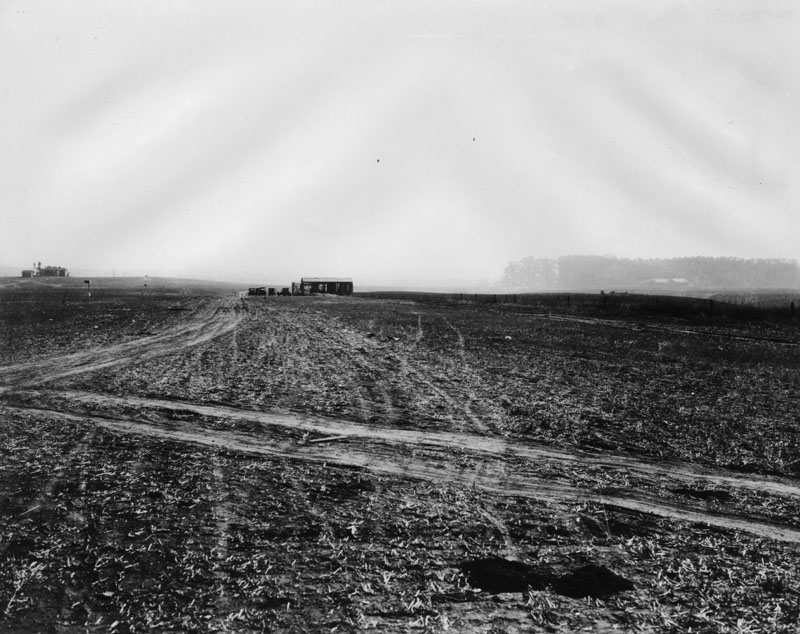 |
|
| (ca. 1924)* - View of part of the old Wolfskill Ranch, also known as the Rancho San Jose de Buenos Aires. The house, shown here on the extreme left, occupied the present corner of Wilshire Boulevard and Beverly Glen, and UCLA and Westwood occupy part of the rancho. |
 |
|
| (1924)* - The old John Wolfskill home, also known as the Rancho San Jose de Buenos Aires. The house was located at the present corner of Wilshire Boulevard and Beverly Glen. |
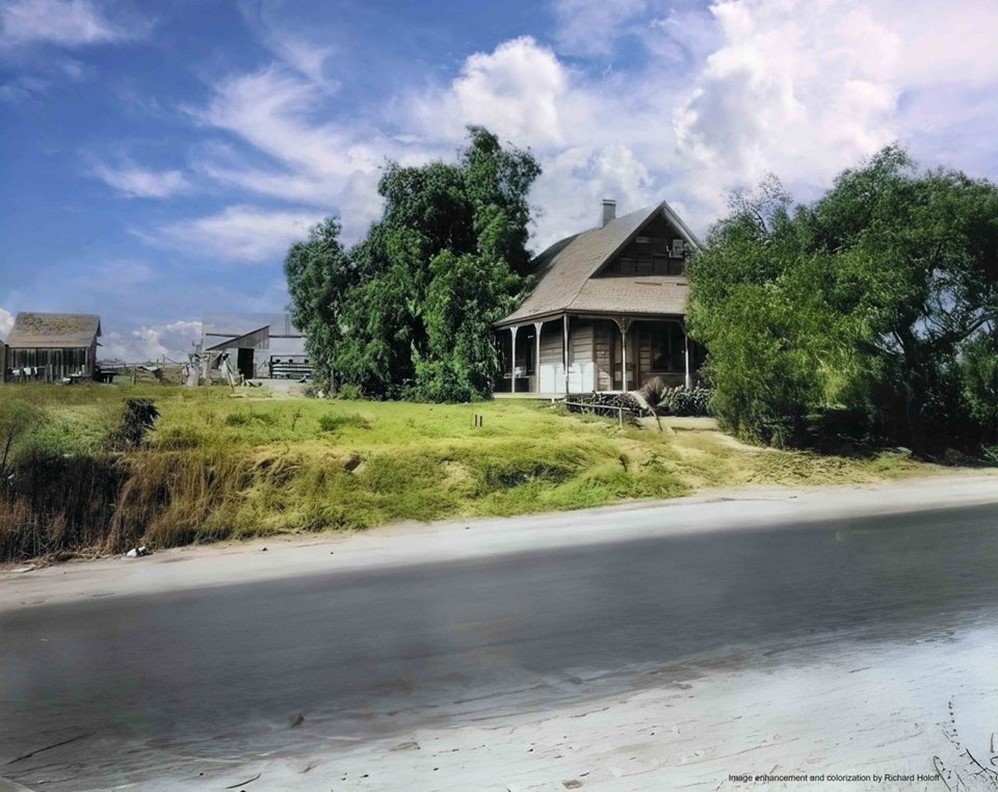 |
|
| (1924)* - The old John Wolfskill home, also known as the Rancho San Jose de Buenos Aires. The house was located at the present corner of Wilshire Boulevard and Beverly Glen. Image enhancement and colorization by Richard Holoff. |
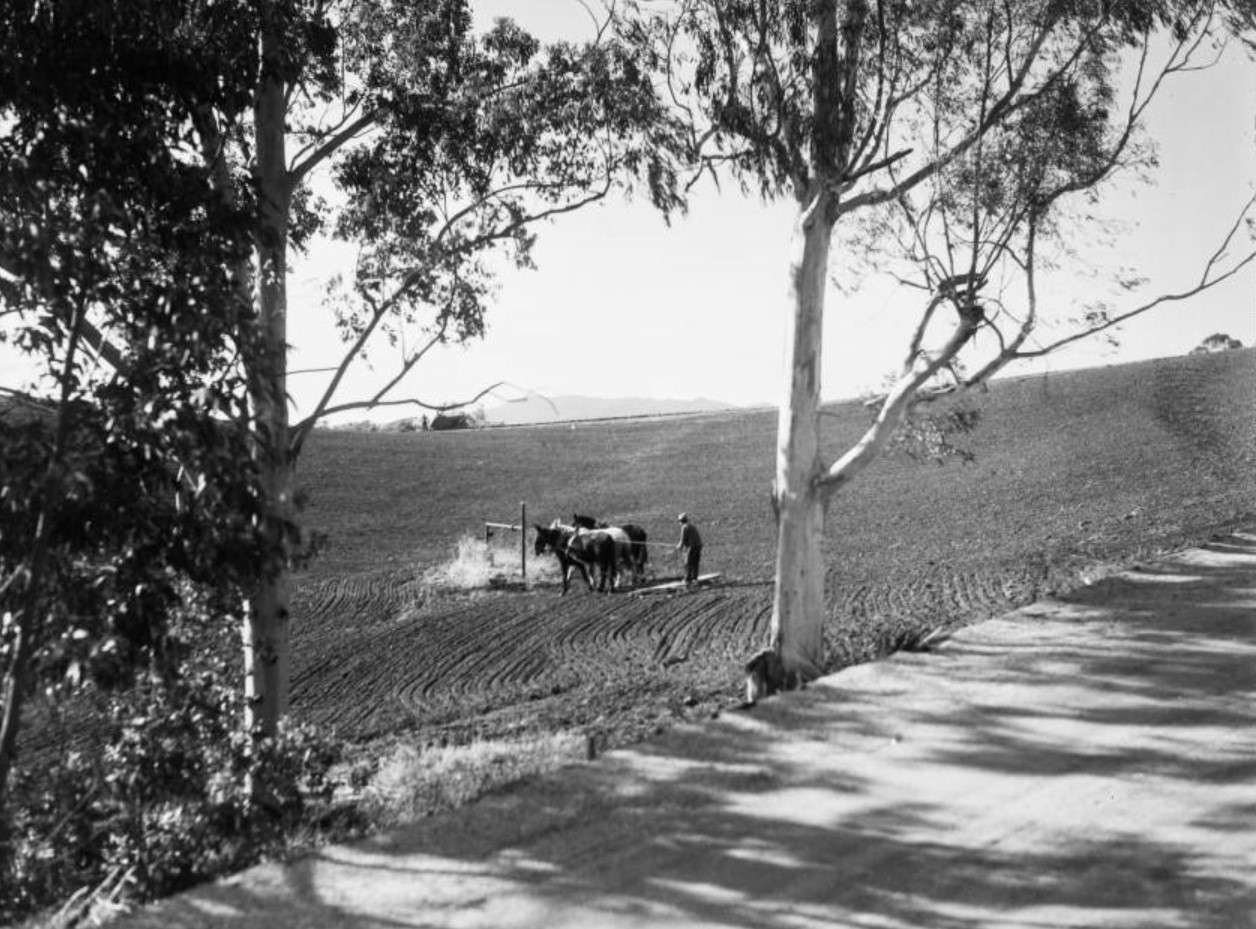 |
|
| (1920s)* - A man stands on a plow being pulled by mules, preparing soil for farming on land that would become Westwood. |
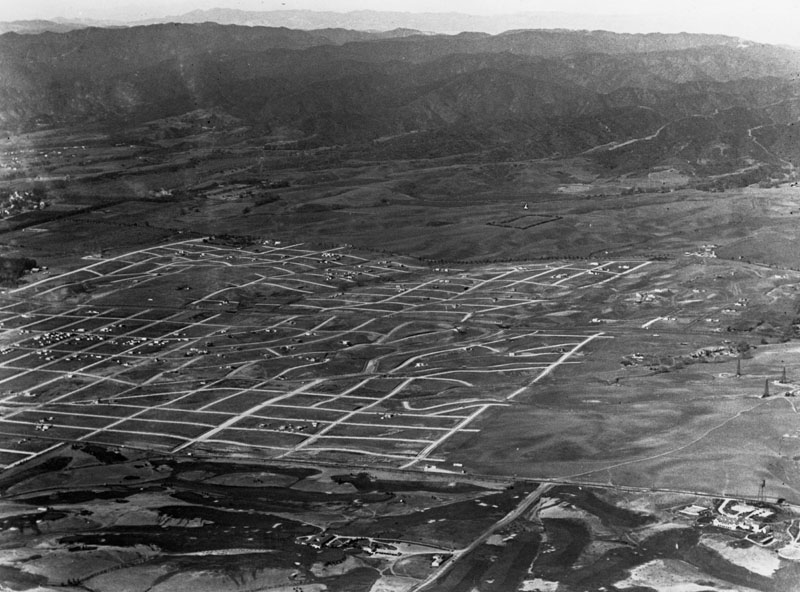 |
|
| (1924)* - Aerial view of new subdivision tracts stretching from Wilshire Boulevard on the north to Pico Boulevard on the south, and from Westwood Boulevard on the west to Fox Hills Drive on the east. A smaller section extends southwest from Patricia and Pico. |
Historical Notes The large open parcel at upper left is the Wolfskill Ranch House site, situated on the Pacific Electric right-of-way at the T-junction with Overland Avenue. This 25-acre property remained intact while the surrounding land was subdivided. Shortly after this photo was taken, comedian Harold Lloyd purchased the land for his motion picture studio ranch. In the early 1930s, the northern portion was sold for the construction of St. Paul the Apostle Catholic Church and School. By 1937, Lloyd’s declining fortunes led him to sell the remainder to the LDS Temple, which built the Los Angeles Temple there in 1956. |
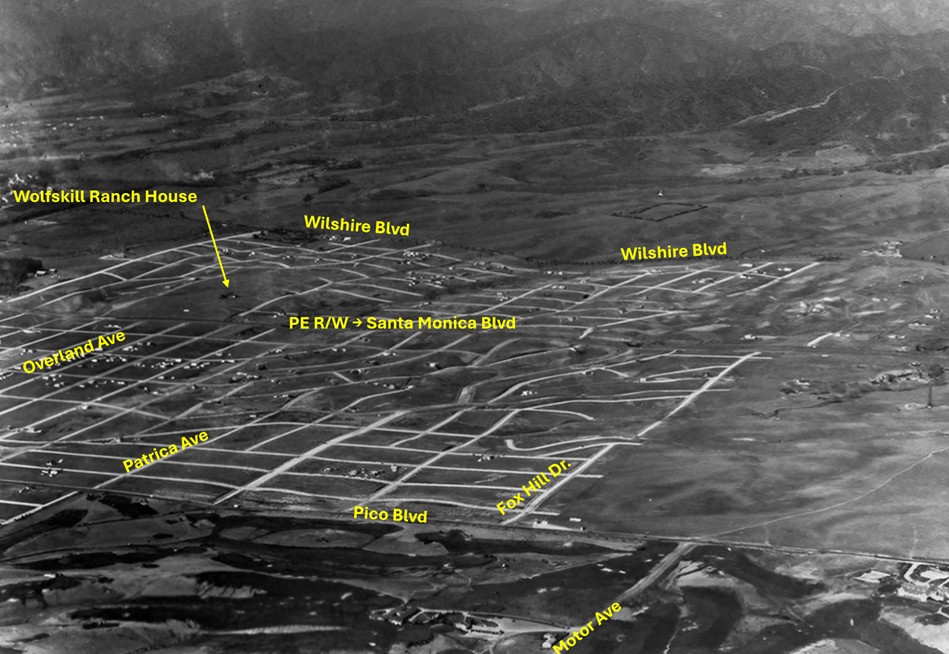 |
|
| (1924)* - Annotated aerial view of future Westwood showing the platted street grid, the Pacific Electric right-of-way (later Santa Monica Boulevard), Overland Avenue, and the Wolfskill Ranch House. Annotated by Jack Feldman. |
Historical Notes The annotations highlight how the Pacific Electric right-of-way would become Santa Monica Boulevard, with Overland Avenue forming a T-junction at the Wolfskill Ranch parcel. This land later evolved from a private ranch to Harold Lloyd’s studio ranch, and finally into a landmark religious site with the construction of the LDS Temple in the 1950s. |
Then and Now
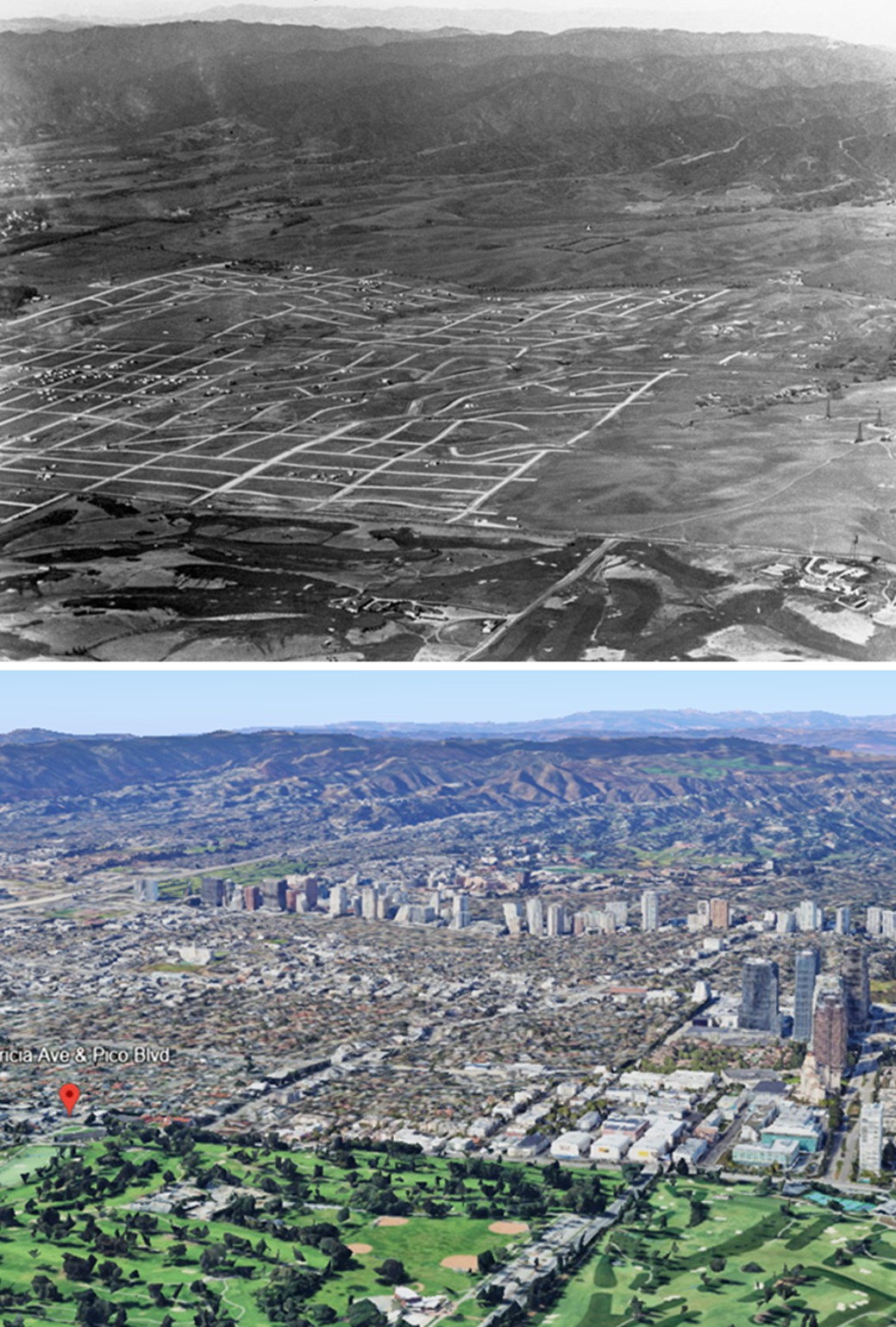 |
|
| (1924 vs 2024)* - A “Then and Now” comparison of Westwood, showing the transformation from open ranch land and new subdivisions into a dense urban neighborhood. The Wolfskill Ranch parcel, once isolated at the T-junction of Overland Avenue and the Pacific Electric right-of-way (later Santa Monica Boulevard), is today the site of the Los Angeles LDS Temple. Photo comparison by Jack Feldman. |
Historical Notes The 1924 aerial shows Westwood at the very beginning of its suburban development, with newly platted streets stretching between Wilshire and Pico Boulevards. At upper left, the Wolfskill Ranch still occupied 25 acres, standing apart from the surrounding subdivision. By the mid-20th century, this parcel had passed from Harold Lloyd’s motion picture ranch to St. Paul the Apostle Church and School, and finally to the LDS Church, which completed the Los Angeles Temple there in 1956. The modern view reveals the full build-out of Westwood, where once-empty tracts are now filled with homes, institutions, and major boulevards. |
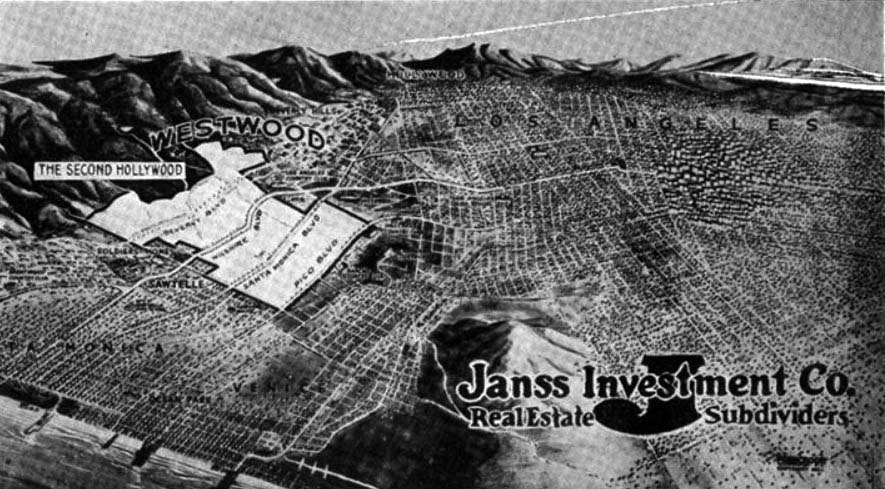 |
|
| (ca. 1925)* – Photo of the Janss Real Estate map for its new westside subdivision. The Westwood development area was billed as “The Second Hollywood”. |
Historical Notes In 1925, in a deal to get the University of California, Los Angeles built, the Janss Investment Company sold 375 acres to the cities of Los Angeles, Santa Monica and Beverly Hills at the bargain price of $1.2 million — about a quarter of its value. The cities, whose voters had passed bond issues to pay for the site, turned around and donated it to the state. While the UCLA campus was being built, Janss Investment Company went to work developing the Westwood Village commercial area and surrounding residential neighborhoods. |
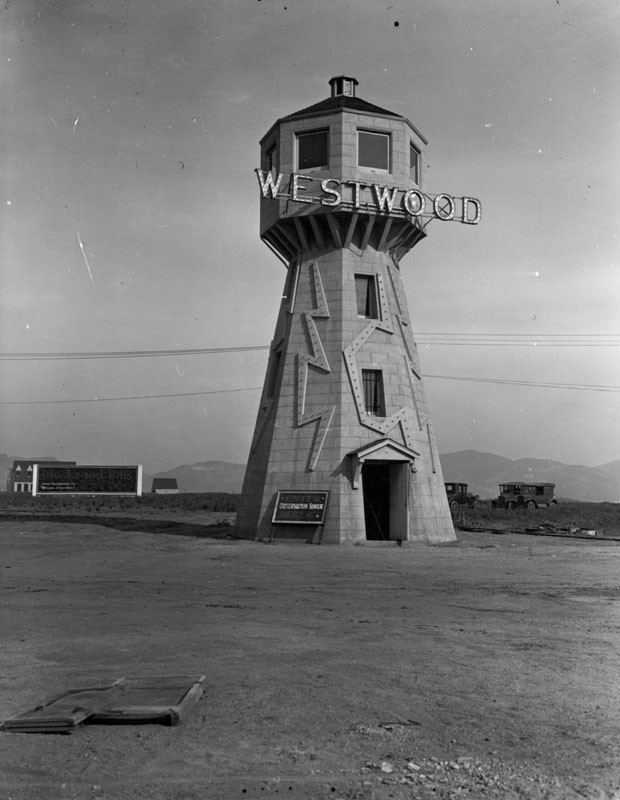 |
|
| (ca. 1924)* - View showing an observation tower in Westwood at Beverly Glen and Wilshire Boulevards. It has a sign, "Westwood" with lightbulbs, and little else surrounds it. |
Historical Notes Built by the Janss Investment Corporation in the 1920s, this oddly shaped tower was located on the northeast corner of Wilshire and Beverly Glen Boulevards. It stood at 420 feet above sea level, making it the highest point on Wilshire Boulevard at the time and was used primarily as a landmark advertisement. At night, the lightning bolts along the sides and the 'WESTWOOD' sign would light up and be seen for miles. Potential home owners were allowed to climb the tower to get a better view of the new community and identify the lot they would like to purchase. |
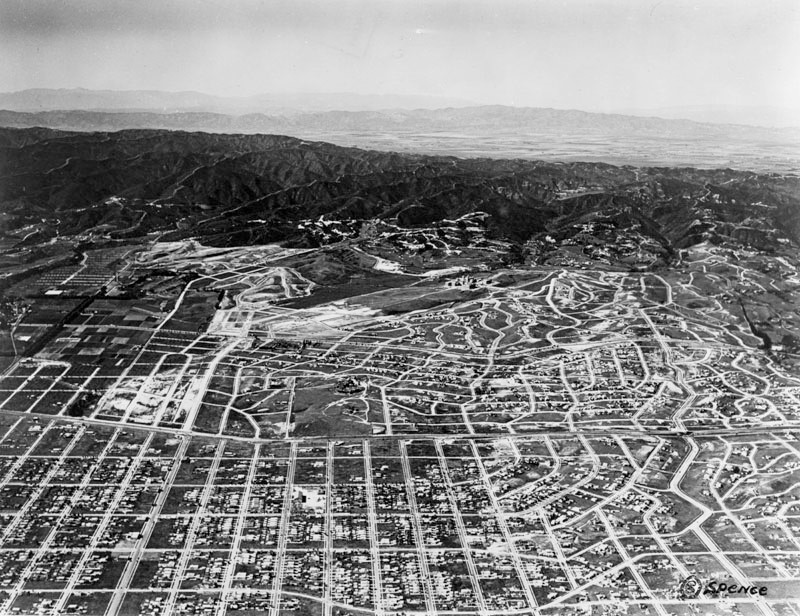 |
|
| (1929)* - Aerial view of Westwood north of Pico Boulevard. The first group of buildings of UCLA are in place, and the streets and blocks of the village are laid out. |
Historical Notes Westwood and UCLA were developed on the lands of the historic 'Wolfskill Ranch', a 3,000-acre parcel that was purchased by Arthur Letts, the successful founder of the Broadway, and Bullock's department stores, in 1919. |
* * * * * |
Westwood Village
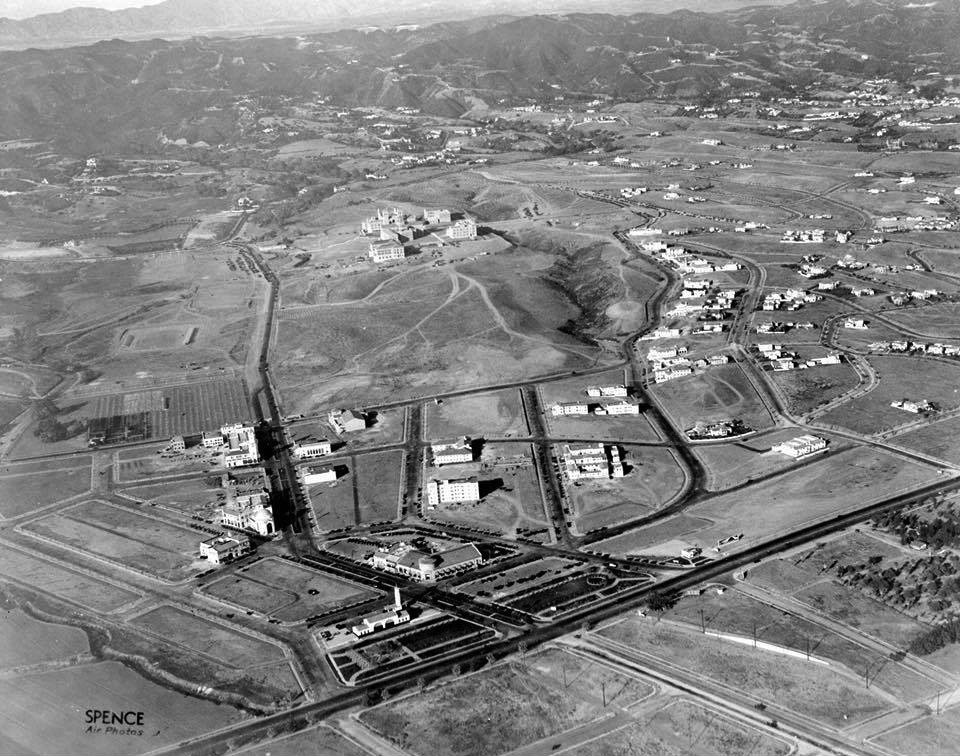 |
|
| (1929)* – Aerial view showing the newly built Westwood Village with the original UCLA buildings seen in the background. |
Historical Notes Westwood Village was created in the late 1920s by the Janss Investment Company as a planned commercial district to serve the new UCLA campus and surrounding neighborhoods. The area was originally part of the historic Wolfskill Ranch, purchased by Arthur Letts in 1919, and later developed by his family. |
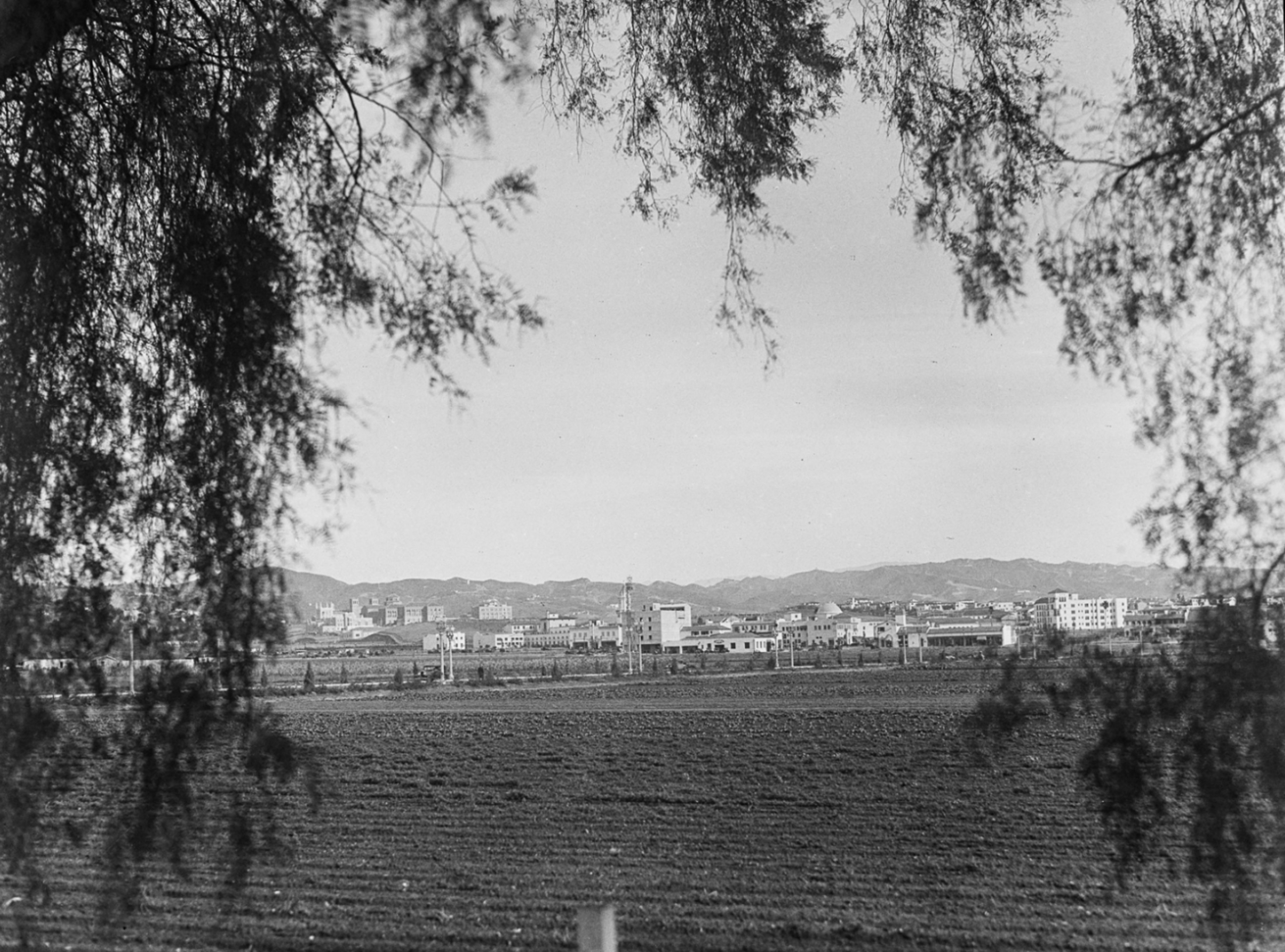 |
|
| (ca. 1929)* – A tranquil landscape view of early Westwood Village, framed by pepper trees and agricultural fields in the foreground. At left on the distant hillside rise the first permanent buildings of the new University of California, Los Angeles (UCLA), which had just opened its Westwood campus in 1929. The developing village center, with its Mediterranean-style architecture and landmark Fox Theater tower, is visible beyond the farmland, capturing a rare transitional moment before suburban growth overtook the open fields. Photo from the Ernest Marquez Collection. |
Historical Notes Westwood Village would contain a unique blend of pedestrian and automobile-oriented development. Wide sidewalks and landscaping were priorities. Corner buildings would be accessible from both streets and interior courtyards. |
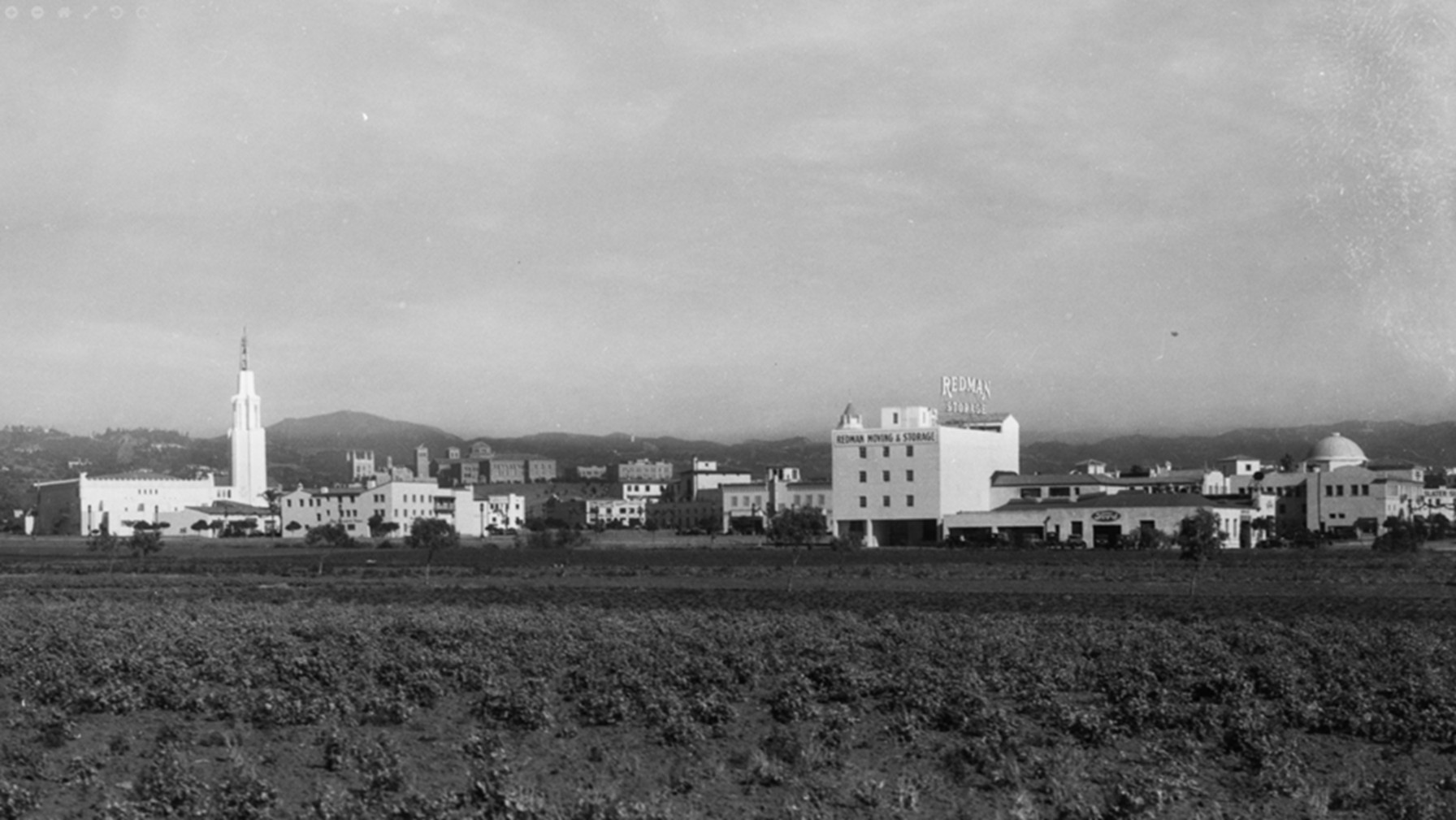 |
|
| (1929* – A closer view of newly developed Westwood Village, with rows of agricultural crops still dominating the foreground. At center left stands the iconic Fox Westwood Village Theatre tower, one of the earliest major landmarks of the area. Just beyond it, UCLA’s original campus buildings are visible on the distant hill. The clean lines of the Redman Moving & Storage building (with its rooftop sign clearly legible) and the Mediterranean and Spanish Colonial Revival architecture of nearby storefronts reflect the carefully planned, unified style of the Janss Investment Company’s vision for the commercial village serving the newly relocated university. |
Historical Notes When UCLA chose Westwood as its new location in 1926, the Village was designed with a Mediterranean architectural style and a layout that welcomed both pedestrians and cars. Early landmarks like the Janss Dome and Fox Westwood Theatre quickly became iconic features, and the Village was marketed as a unique shopping and entertainment destination. |
 |
|
| (1929)* – Aerial view looking east showing the newly constructed Westwood Village with street names annotated. Wilshire runs away from the camera at far right. |
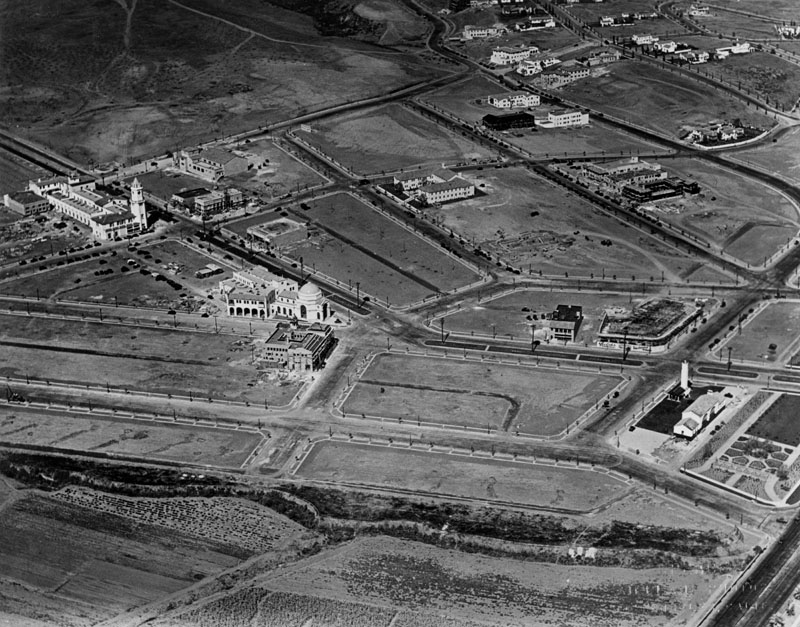 |
|
| (1929)* - Aerial close-up view of Westwood Village, showing the beginning of development but a great deal of open space still. Janss Dome can be seen at center-left. Wilshire is at lower-right. |
Historical Notes Westwood Village was created by the Janss Investment Company, run by Harold and Edwin Janss and their father, Peter, in the late 1920s as an autonomous shopping district and headquarters of the Janss Company. Its boom was complemented by the boom of UCLA (which selected the Westwood Hills as its new home in 1926), developed as a shopping district not just for the residents of Westwood but also for the university. |
.jpg) |
|
| (1929)* - View showing Westwood Village under construction. The Janss Dome seen above was the first building to be constructed. When completed in 1930 it would house the headquarters of the Janss Investment Company |
Historical Notes In 1911 Harold Janss married Arthur Letts' daughter Gladys. In 1923 after Arthur Letts, Sr. died, leaving control of the 3,300-acre William Wolfskill ranch on Rancho San Jose de Buenos Ayres to Harold and Gladys Janss. Through a three-way deal with the State of California and the cities of Los Angeles, Santa Monica, and Beverly Hills, the UCLA campus was built. Janss Investment Company went to work in parallel developing the Westwood Village commercial area and surrounding residential neighborhoods. |
 |
|
| (1929)* - A panoramic view of Westwood. The area in the foreground is mostly open fields, but beyond that Westwood Village is under construction. There are several tree-lined streets laid out, but only a few large buildings are under construction. There are numerous houses in the distance beyond that, and the beginnings of the University of California, Los Angeles, campus in the distance on the left. |
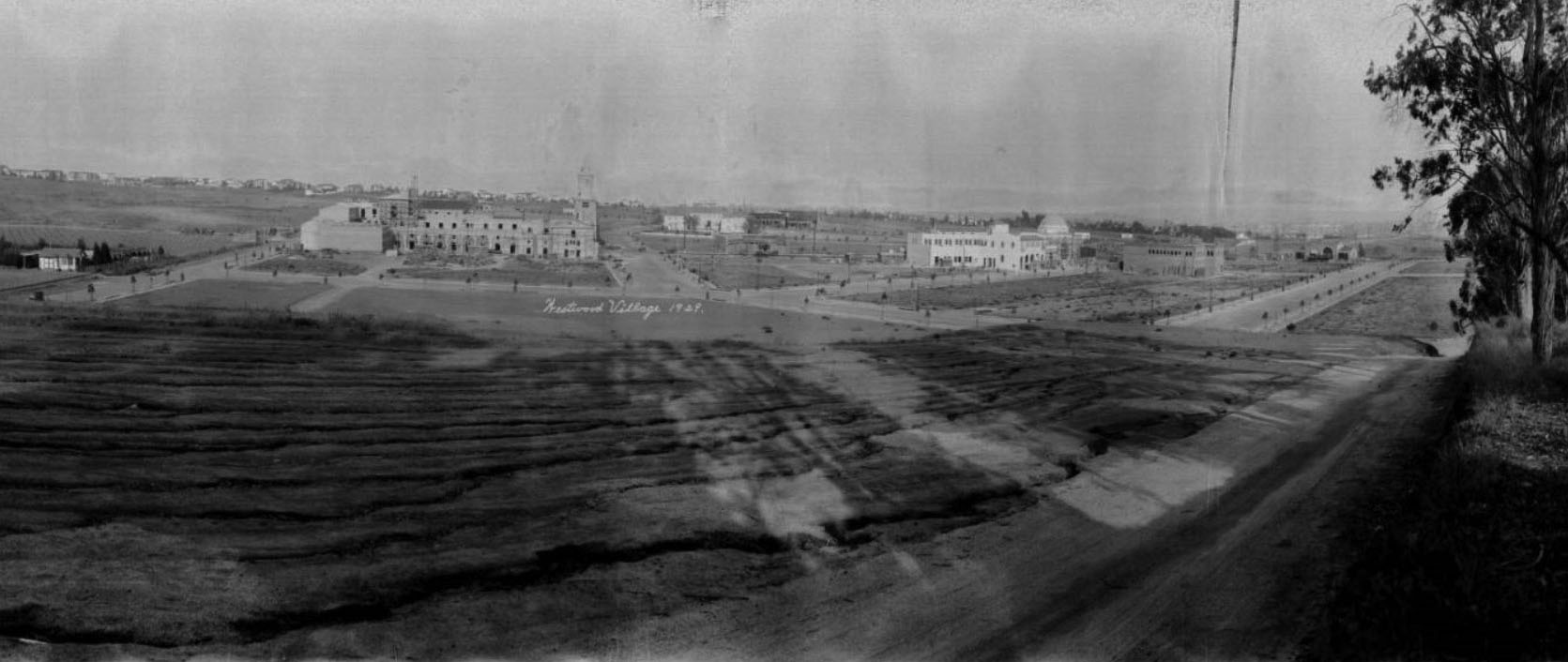 |
|
| (1929)* - Panoramic view showing Westwood Village under construction. Note the open fields surrounding the development. |
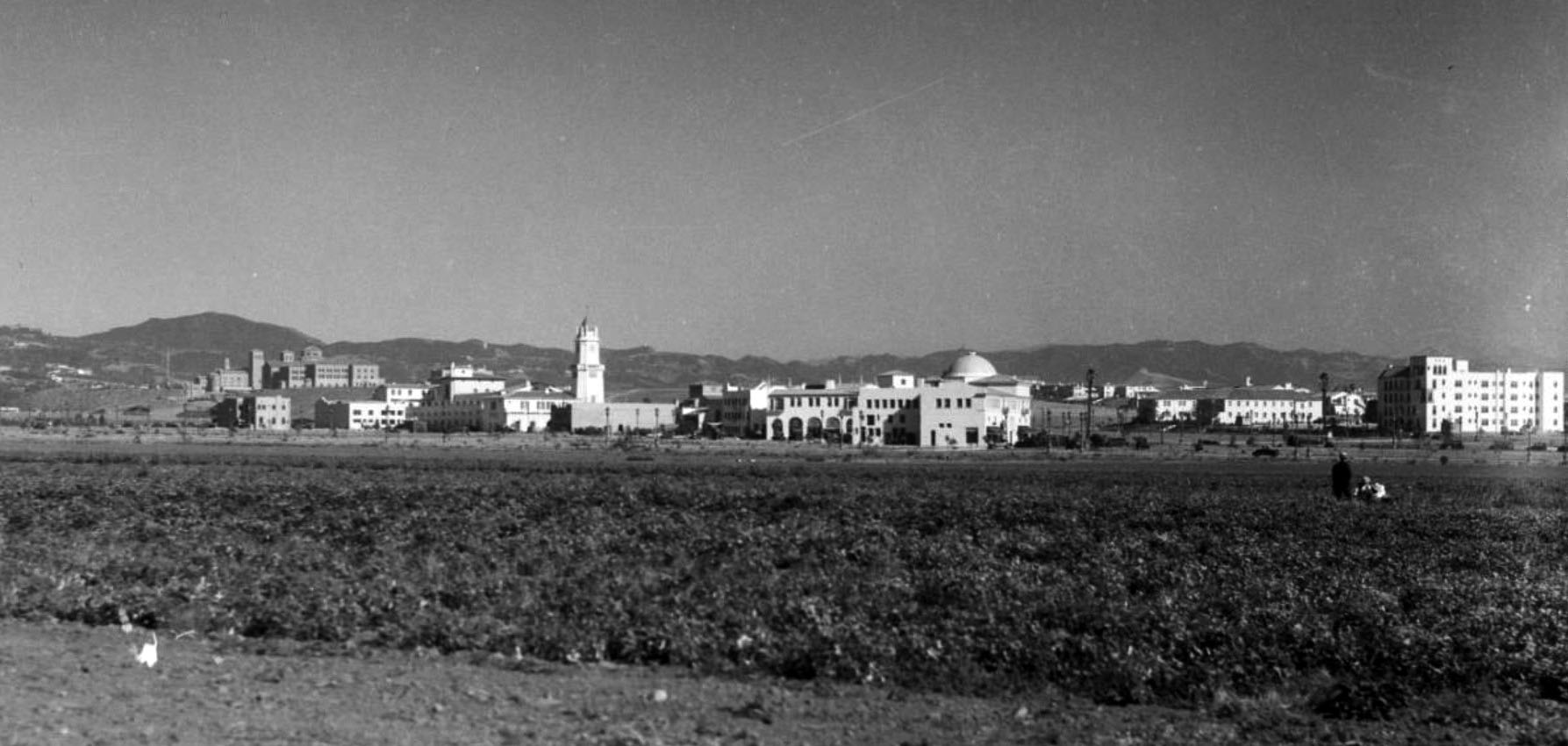 |
|
| (ca. 1930)* - View of Westwood Village looking northeast, showing agricultural crops in the foreground, and people standing at right. The buildings of the new UCLA campus can be seen on the hill in the distance at left. |
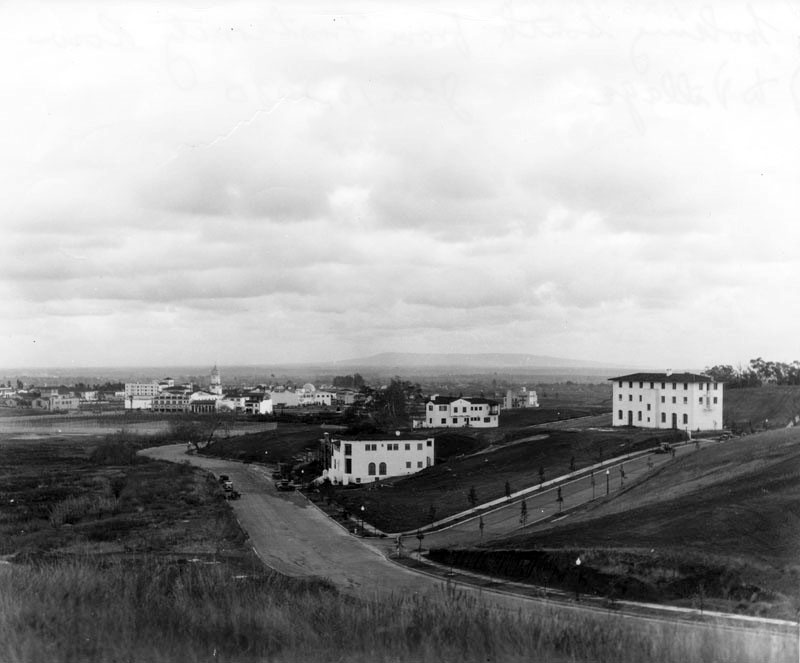 |
|
| (1930)* - View of Westwood Village on January 10, 1930, looking south from UCLA's Fraternity Row. |
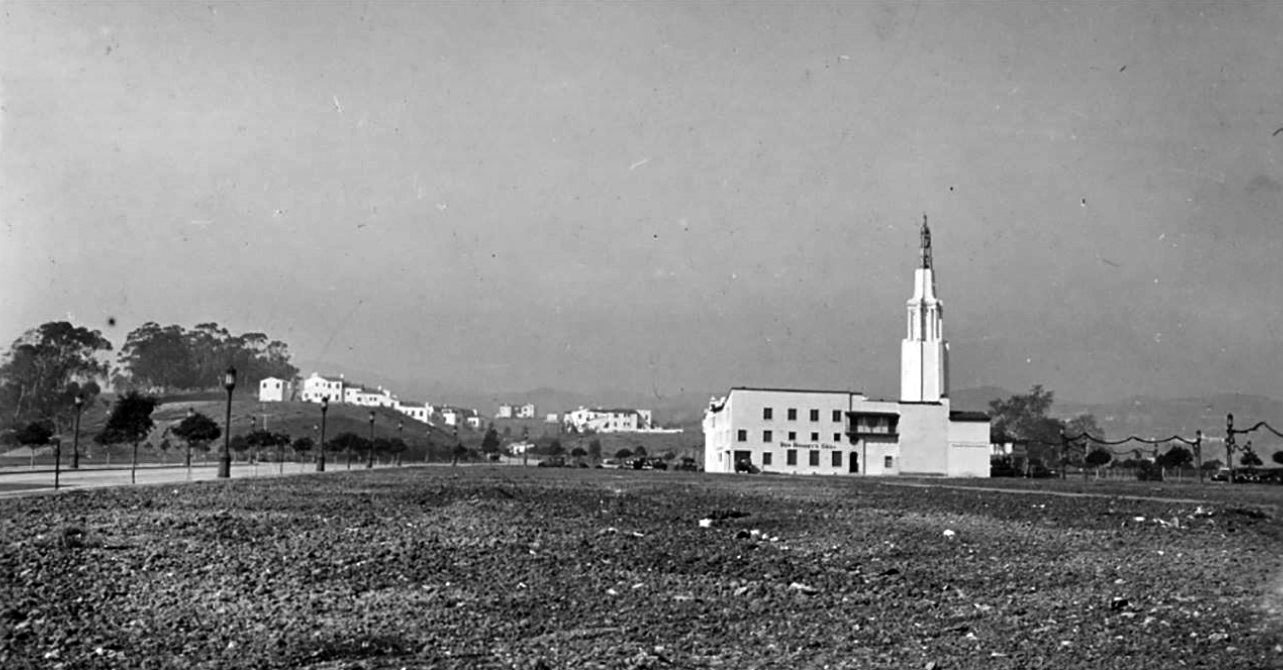 |
|
| (1932)* – Panoramic view looking north toward the Westwood Fox Theatre (built in 1931) with UCLA’s Fraternity Row on the hill in the background. Gayley Avenue is seen at left. Note the amount of undeveloped land in the foreground. |
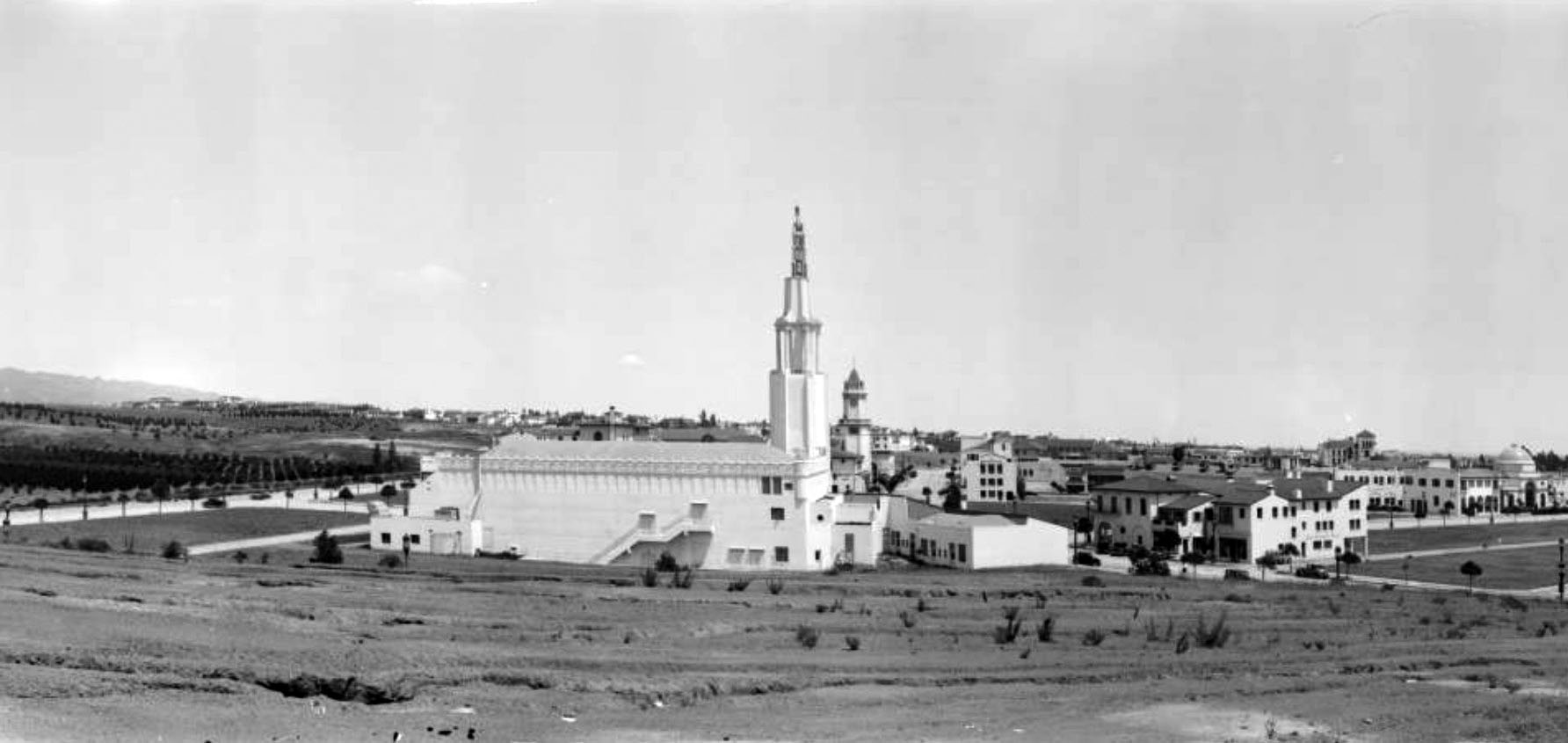 |
|
| (1933)* – Panoramic view looking east of the Fox Theatre in Westwood Village. There is a large stretch of open space in the foreground, then the theater with its tall tower. The area to the right of the theater is mostly commercial, with stores like Ralphs, while to the left of the theater there is an orchard, and in the distance (out of view) the University of California, Los Angeles, campus. |
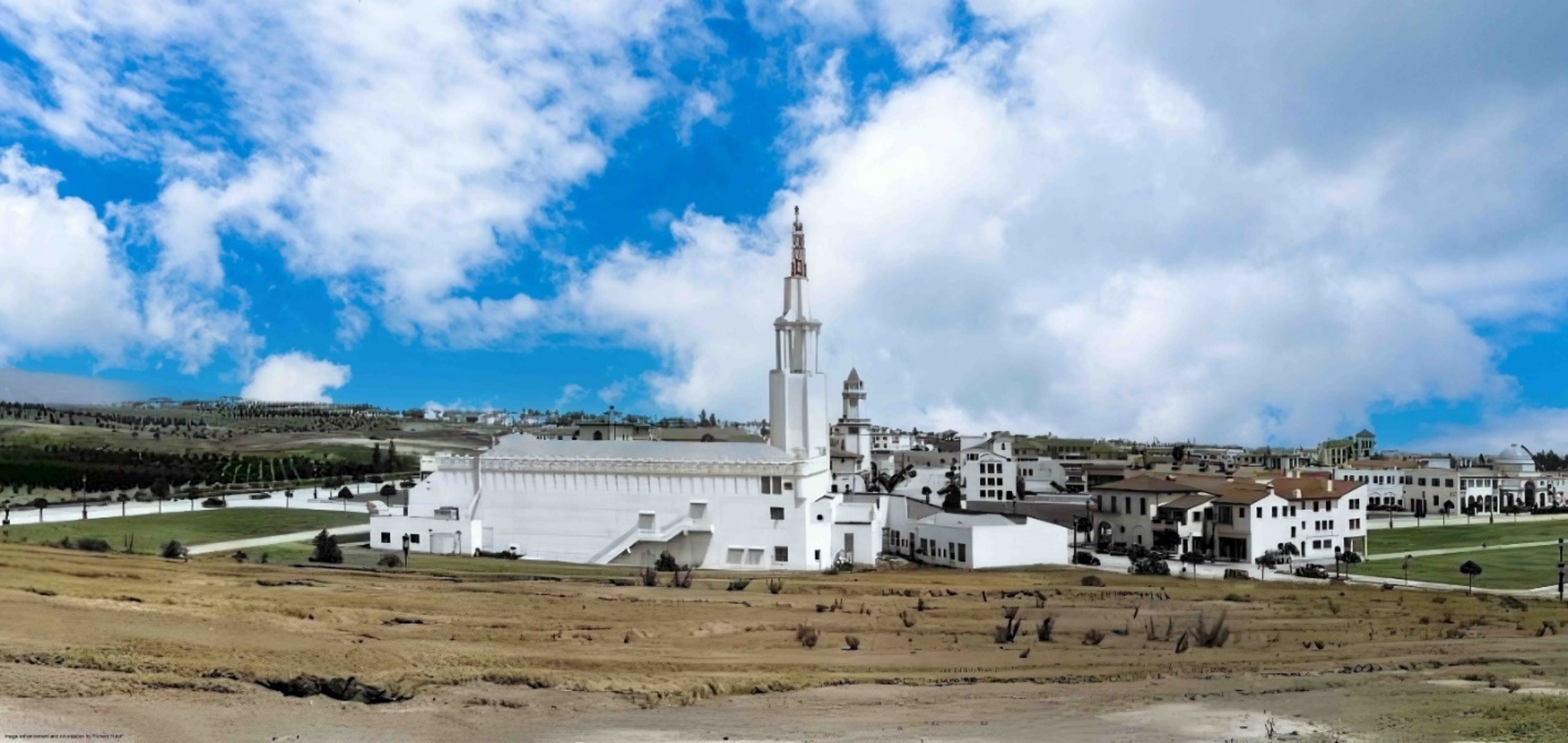 |
|
| (1933)* – Panoramic view looking east of the Fox Theatre in Westwood Village. There is a large stretch of open space in the foreground, then the theater with its tall tower. The area to the right of the theater is mostly commercial, with stores like Ralphs, while to the left of the theater there is an orchard, and in the distance (out of view) the University of California, Los Angeles, campus. Image enhancement and colorization by Richard Holoff. |
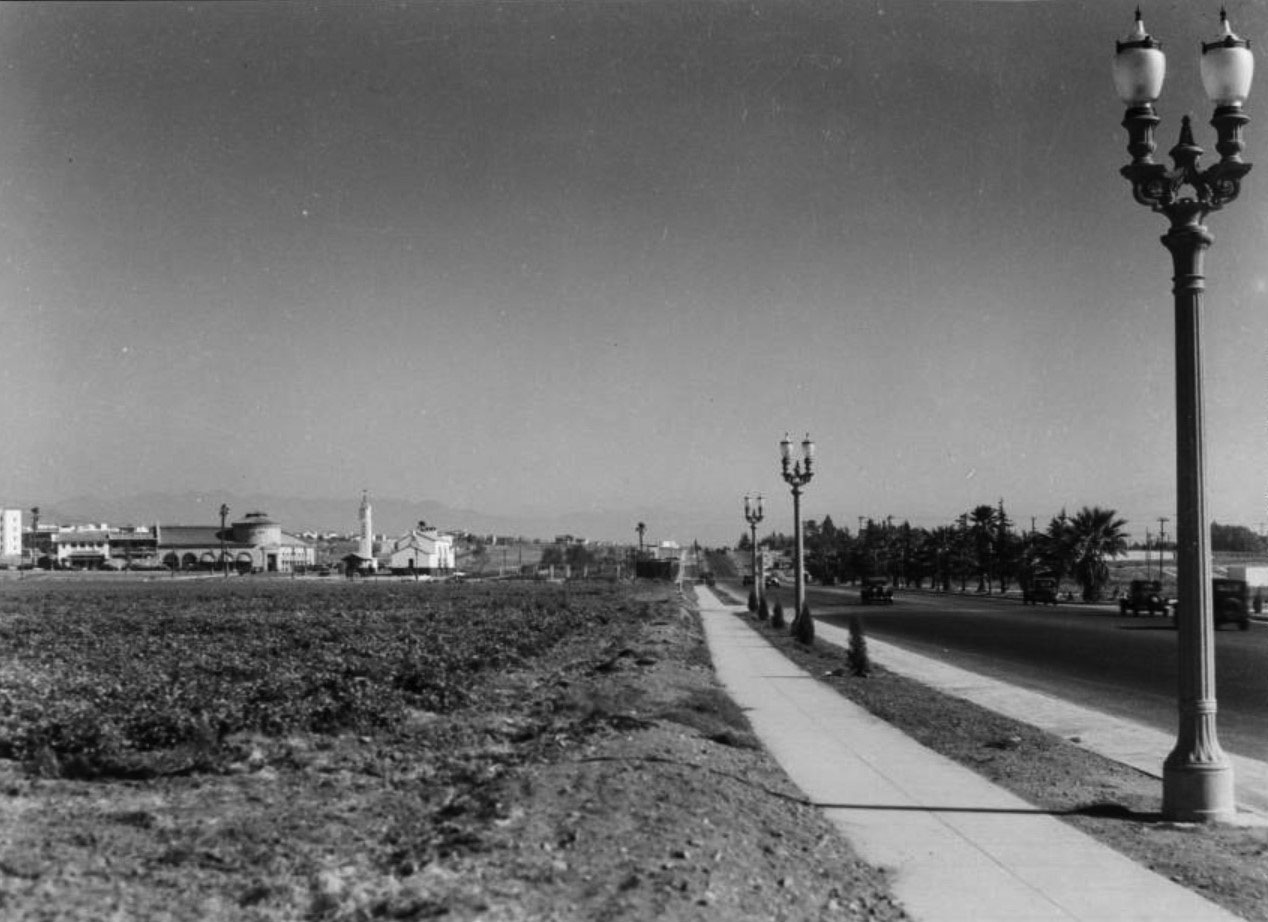 |
|
| (ca. 1930)* - View looking east along the sidewalk adjacent to Wilshire Boulevard towards the new Westwood Village development. To the left can be seen the new Ralphs Market with its prominent rotunda. Note the ornate streetlamps running down Wilshire Blvd. Click HERE to see more Early LA Streetlights. |
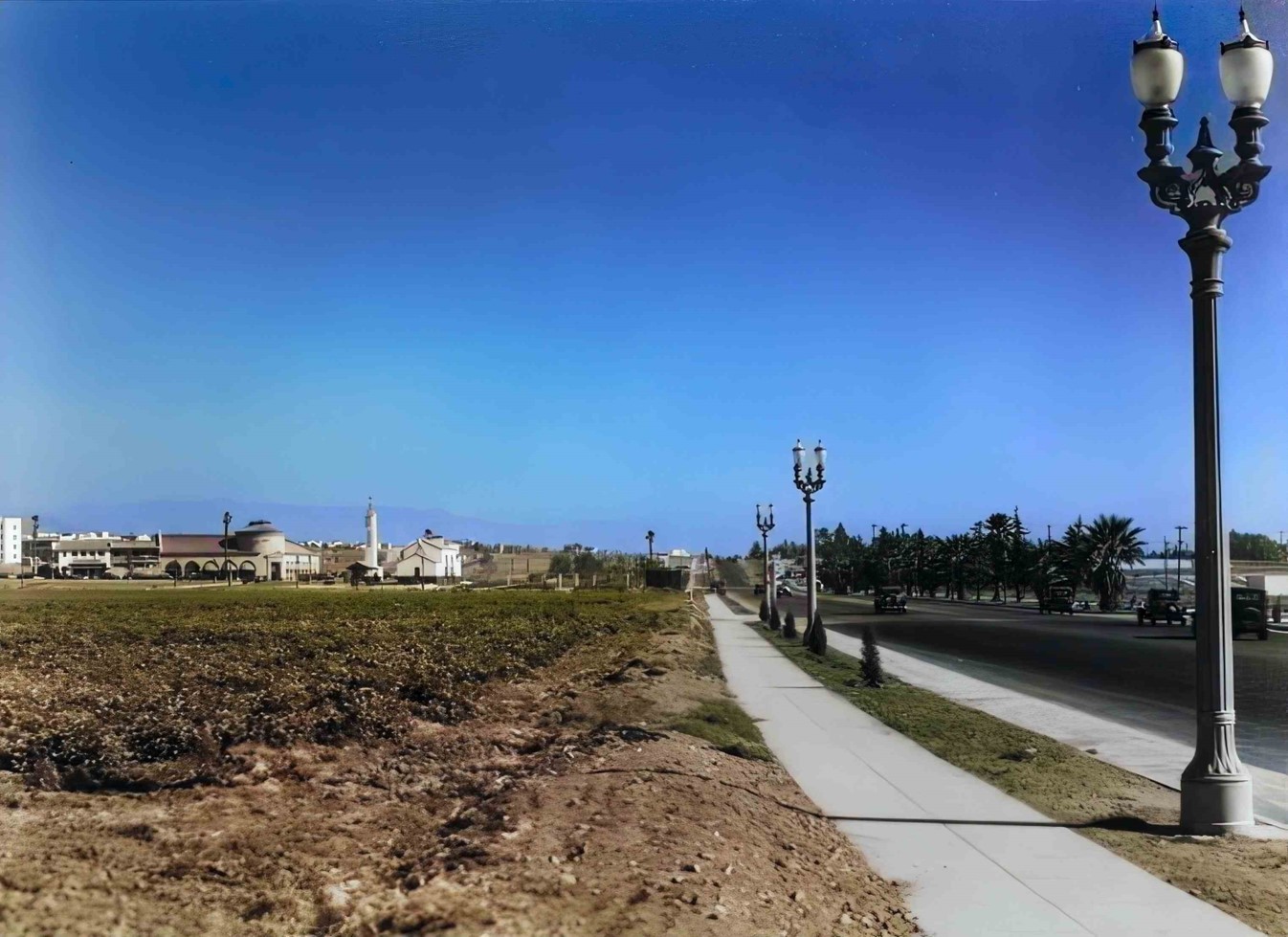 |
|
| (ca. 1930)* - Looking east along sidewalk adjacent to Wilshire Boulevard towards the new Westwood Village development. To the left can be seen the new Ralphs Market with its prominent rotunda. Note the ornate streetlamps. Photo Source: Huntington Library, Ernest Marquez Collection; AI enhancement and colorization by Richard Holoff |
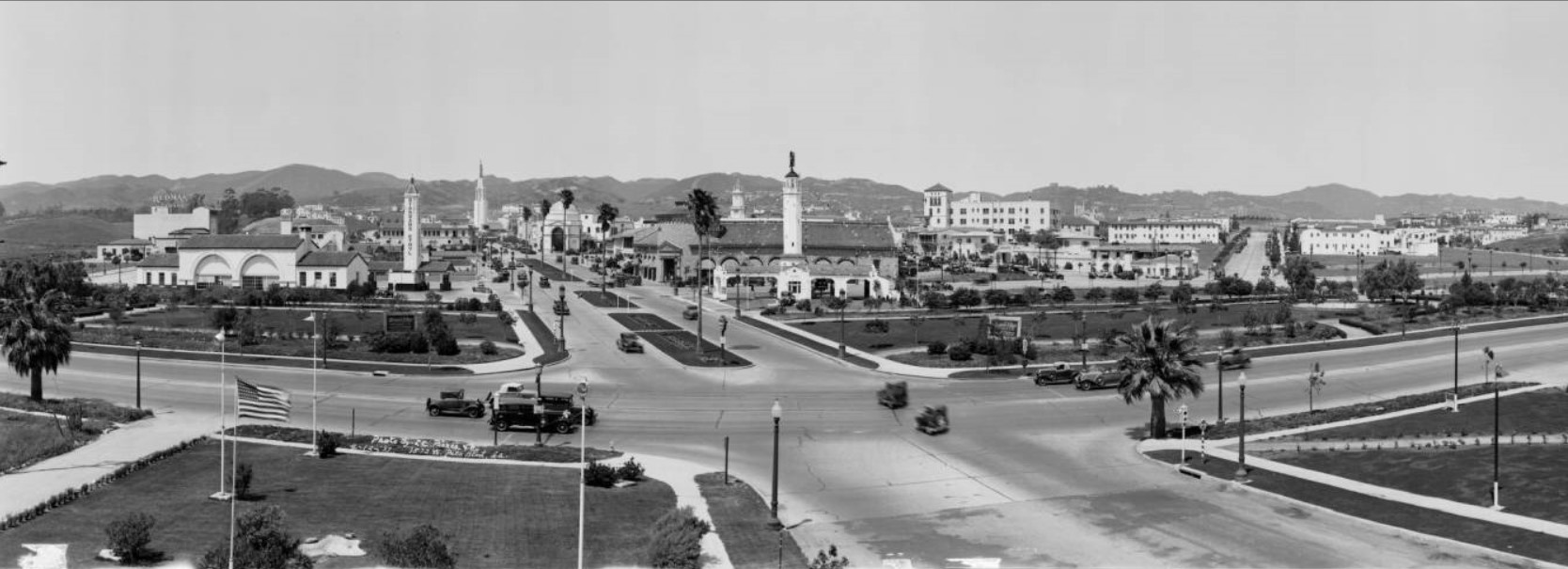 |
|
| (1932)* - Panoramic view of Westwood facing north at the intersection of Wilshire and Westwood. Wilshire runs the width of the image, in the foreground. Westwood, with palm trees planted in the dividers, goes into the distance, past a variety of stores, including a Ralphs, gas stations, and Janss Dome. |
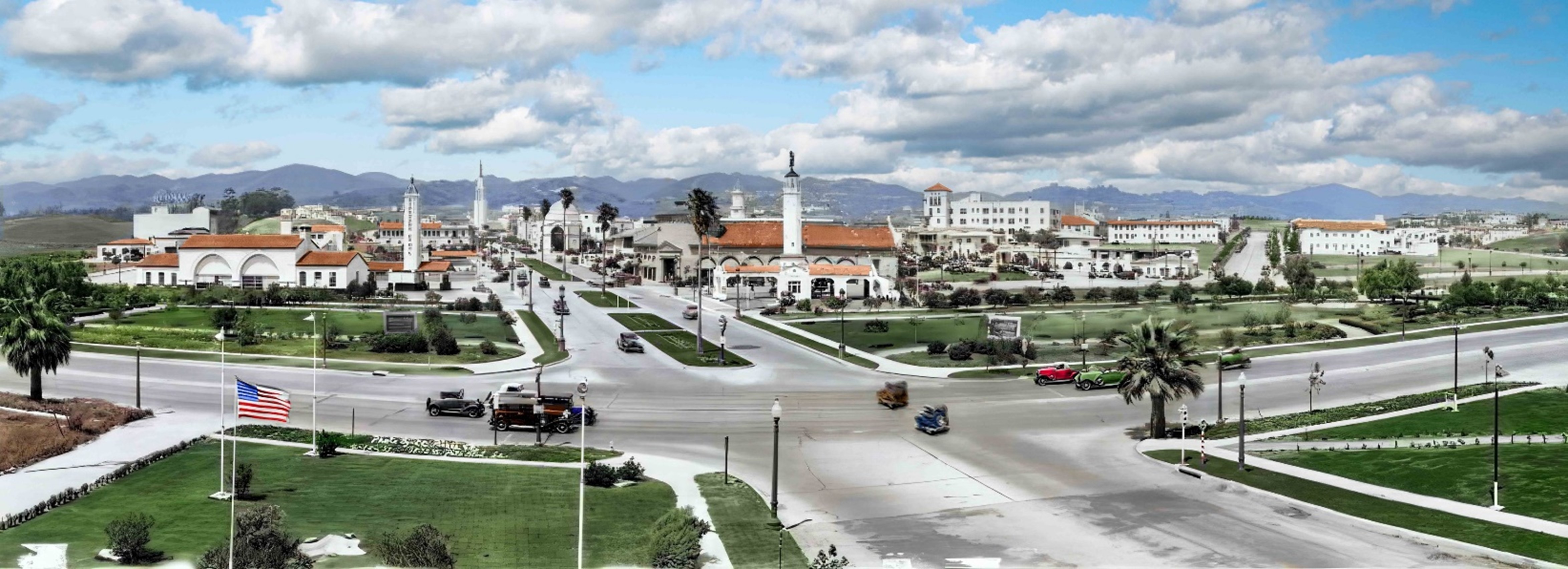 |
|
| (1932)* - Panoramic view of Westwood facing north at the intersection of Wilshire and Westwood. Wilshire runs the width of the image, in the foreground. Westwood, with palm trees planted in the dividers, goes into the distance, past a variety of stores, including a Ralphs, gas stations, and Janss Dome. Image enhancement and colorization by Richard Holoff. |
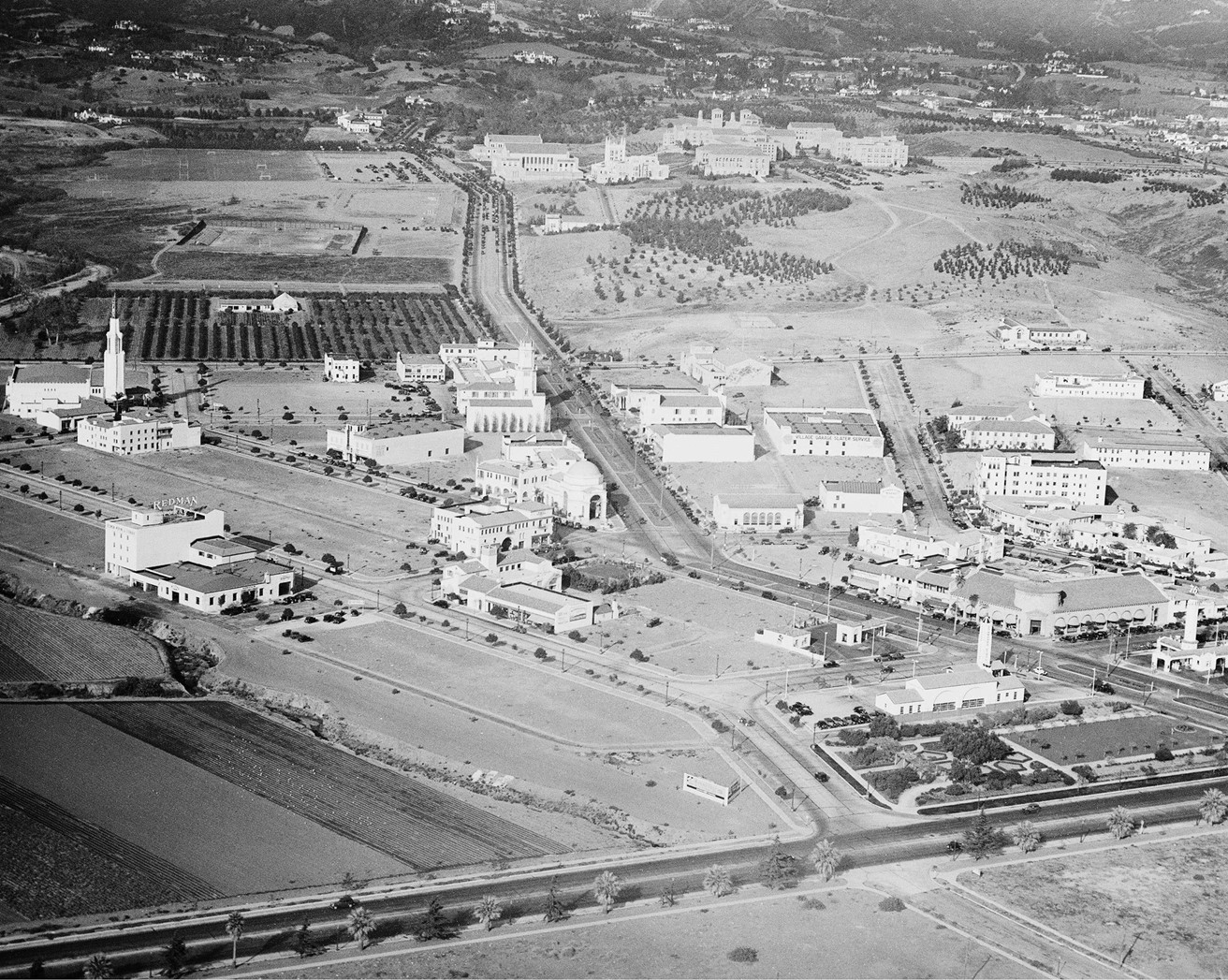 |
|
| (ca. 1933)* - Aerial view of Westwood and the UCLA campus. |
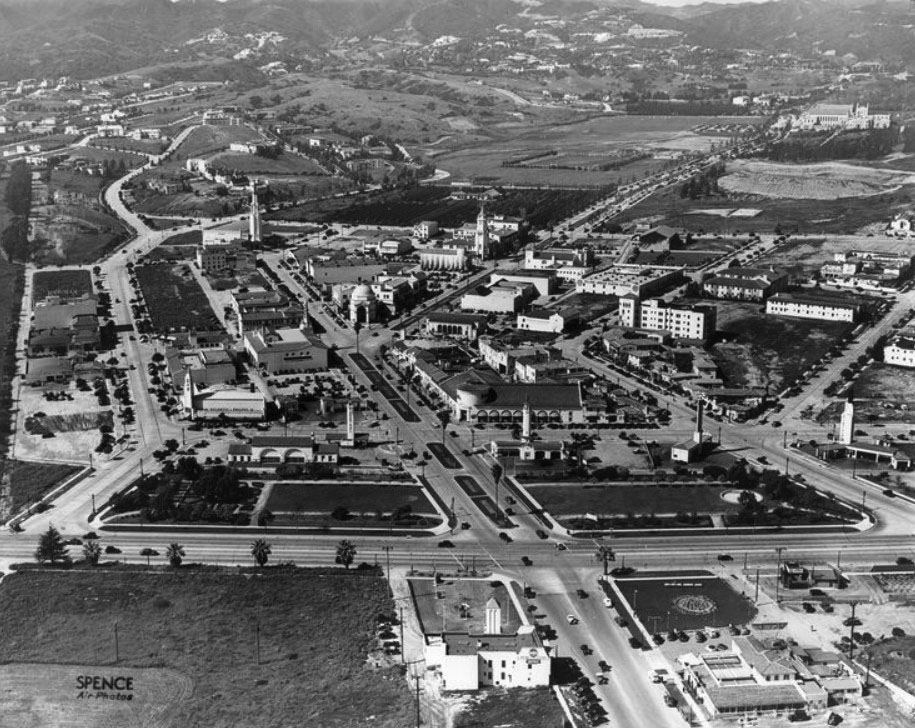 |
|
| (ca. 1936)* – Aerial view looking north showing Westwood Village with the intersection of Westwood and Wilshire boulevards seen in the foreground. |
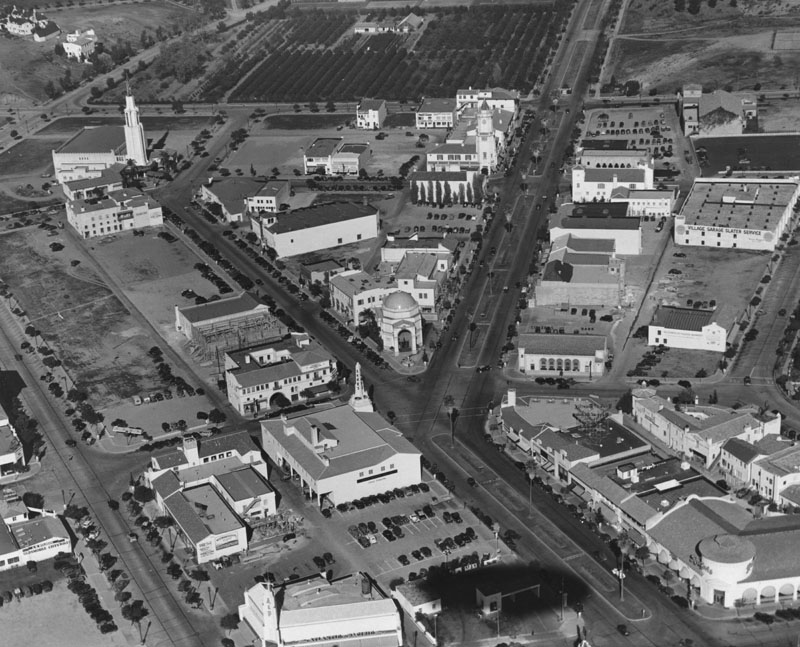 |
|
| (1936)* - Aerial view of Westwood Village from a blimp (note the shadow in the foreground). The Fox Theater is on the upper left, Ralphs lower right. At upper center is the Holmby Building with its clock tower. At center of photo, where Westwood Boulevard intersects Broxton Avenue, sits the Janss Dome Building, built in 1929. |
* * * * * |
Broxton Avenue
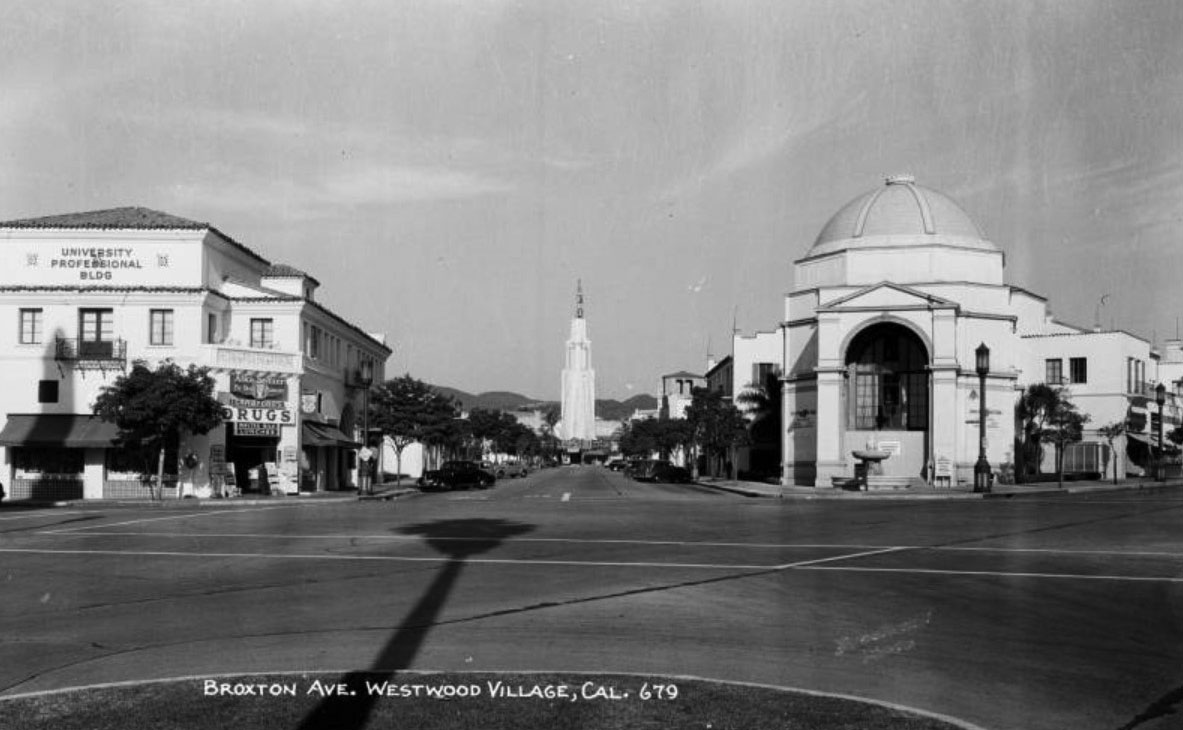 |
|
| (1930s)* – Postcard street view looking northwest showing the buildings at the intersection of Westwood Boulevard, Kinross Avenue, and Broxton Avenue in Westwood Village. At right is the Janss Dome building; at center in distance is the Fox Theater spire and marquee, and the University Professional Building with Crawford's Drug store. Signs on the drug store read "malted milk lunches" and "Alka-Seltzer - be wise alkalize." |
Historical Notes Broxton Avenue has been a defining feature of Westwood Village since its inception in the late 1920s. Developed by the Janss Investment Company as part of a Mediterranean-themed commercial district to serve UCLA, the street was anchored by the Janss Dome (1929)—a Spanish Colonial Revival building with a distinctive terra-cotta dome—and the Fox Theatre’s iconic spire. The avenue originally featured wide sidewalks, courtyards, and locally owned businesses like Crawford’s Drug Store, designed to complement UCLA’s campus aesthetics by architects Allison & Allison. |
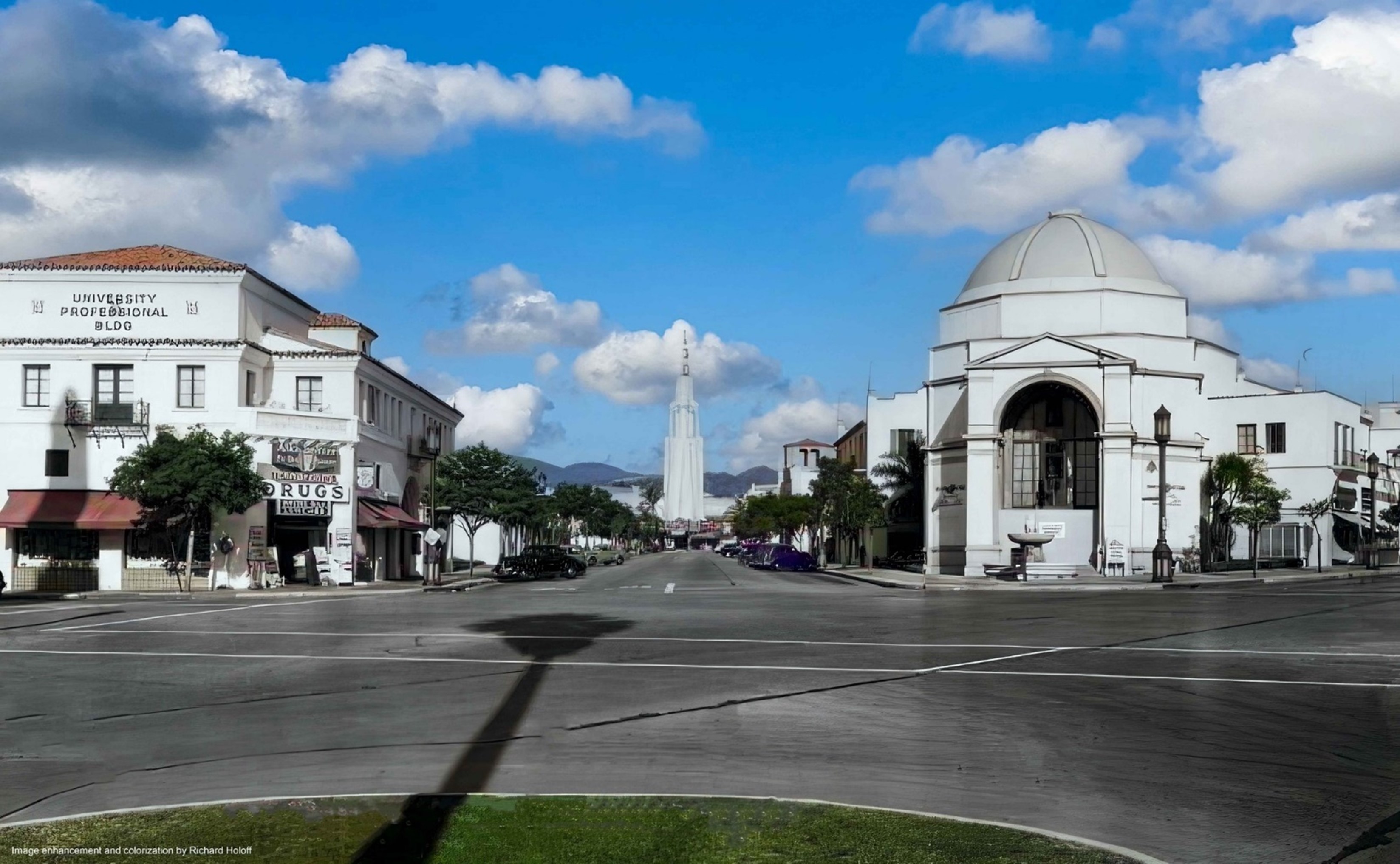 |
|
| (1930s)* – Postcard street view looking northwest showing the buildings at the intersection of Westwood Boulevard, Kinross Avenue, and Broxton Avenue in Westwood Village. At right is the Janss Dome building; at center in distance is the Fox Theater spire and marquee, and the University Professional Building with Crawford's Drug store. Signs on the drug store read "malted milk lunches" and "Alka-Seltzer - be wise alkalize." Image enhancement and colorization by Richard Holoff. |
Historical Notes In the 1930s, the intersection of Broxton, Kinross, and Westwood Boulevard was the heart of Westwood Village, a Mediterranean-inspired commercial district developed by the Janss Investment Company. Dominated by the Janss Dome—a Moorish-style landmark with an aqua-and-white zigzag dome—the area featured wide sidewalks, courtyards, and iconic structures like the Fox Theatre’s spire and Crawford’s Drug Store. Designed by Allison & Allison (who also shaped UCLA’s early campus), the Janss Dome housed the company’s headquarters and served as UCLA’s first male dormitory. The intersection buzzed with locally owned shops, theaters, and pedestrian-friendly spaces, reflecting the Janss brothers’ vision of a cohesive university-adjacent hub. |
 |
|
| (2019)* – Looking northwest on Broxton Avenue from the intersection with Westwood Boulevard and Kinross Avenue. The spire of the Fox Theater rises in the distance at the end of Kinross, while the Janss Dome building appears on the right, now home to Broxton Brewery & Public House. |
Historical Notes Today, the intersection retains its historic bones but has adapted to modern urban life. The Janss Dome, now a Los Angeles Historic-Cultural Monument, houses Broxton Brewery, blending its 1929 architecture with contemporary use. While the Fox Theatre’s spire remains visible, Broxton Avenue has shifted toward pedestrianization, emphasizing event spaces and dining over early retail. The area’s Mediterranean aesthetic persists, though chain stores and updated infrastructure reflect broader changes in Westwood Village’s commercial and cultural identity. |
Then and Now
 |
|
| (1930s vs. 2019)* – A ‘Then and Now’ comparison looking northwest on Broxton Avenue from the corner of Westwood Boulevard and Kinross Avenue. The spire of the Fox Theater remains visible at the end of Kinross, and the Janss Dome building is still standing on the right—now home to Broxton Brewery & Public House. In the modern view, palm trees line the street, adding a bit more of that laid-back Southern California vibe. Photo comparison by Jack Feldman. |
* * * * * |
Janss Dome
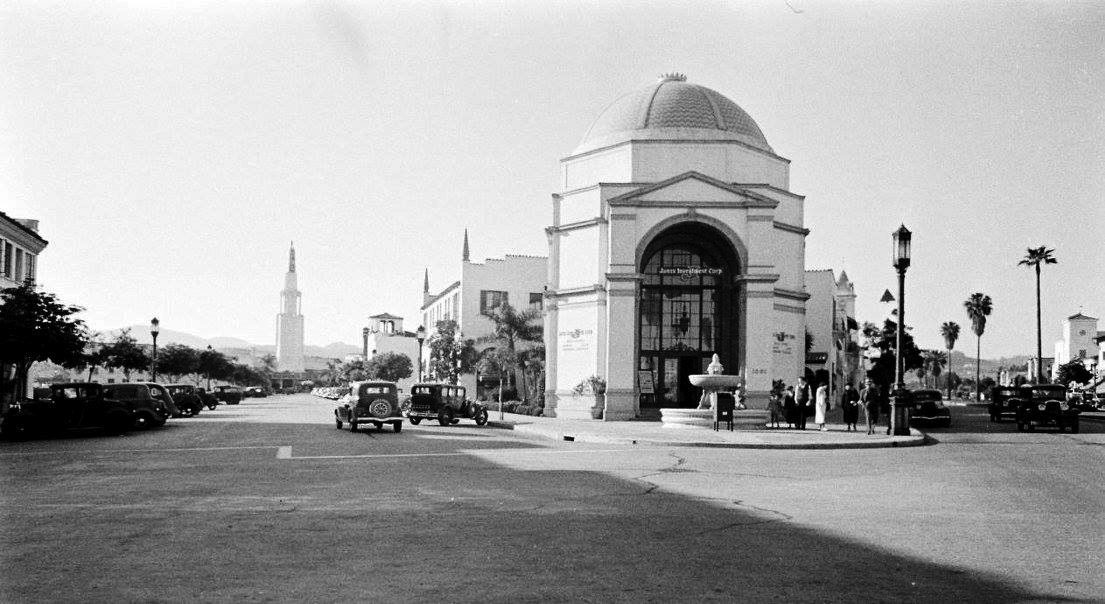 |
|
| (1930s)* – Panoramic view showing the beautiful Bank of America Building (aka Janss Dome) at the intersection of Broxton Ave (left) and Westwood Boulevard (right). The iconic tower of the Fox Theatre can be seen at the end of Broxton Ave. |
Historical Notes In 1929 the Janss Dome was the first building erected in the Mediterranean-themed Westwood Village. It housed the headquarters of the Janss Investment Company run by the Janss brothers, Edwin and Harold Janss, who were the developers of the village. The village was built as a shopping and cinema precinct to serve the adjacent University of California, Los Angeles (UCLA). The second floor of the Janss building was the first male dormitory for UCLA students. |
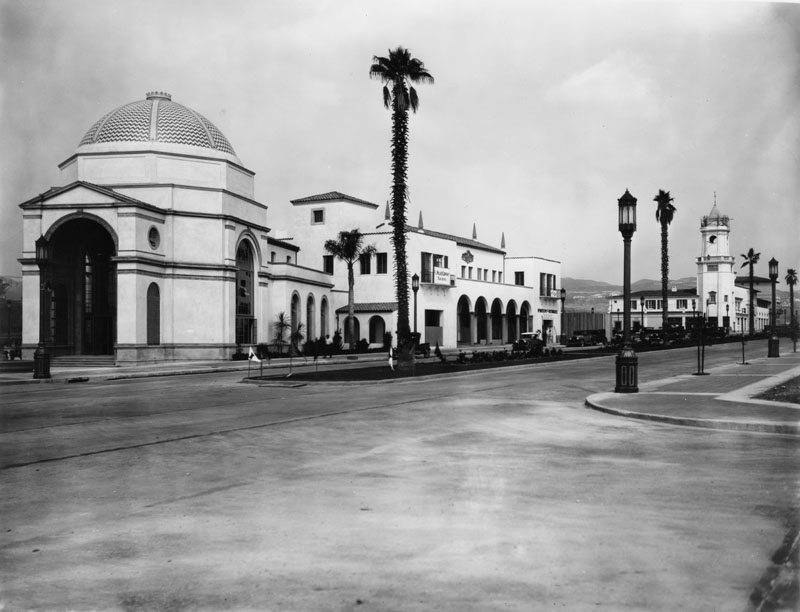 |
|
| (ca. 1930)* - A view of Westwood Boulevard's Bank of America building (also Janss Dome), P. J. Walker Company and Phelps Terkel. |
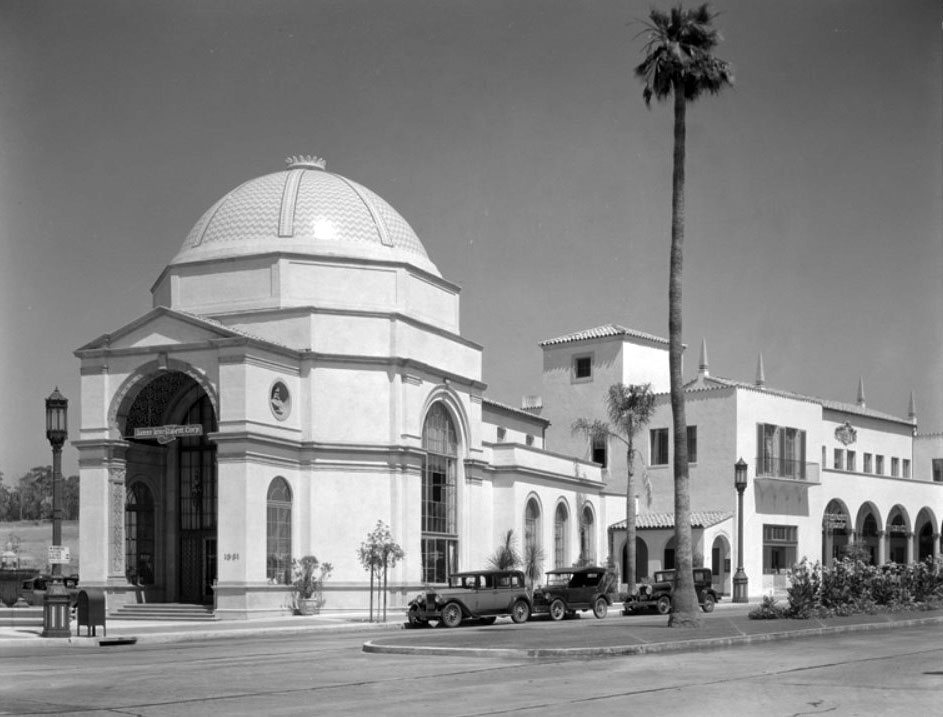 |
|
| (ca. 1930s)* - Closer view of the Janss Dome located at the intersection of Westwood Boulevard and Broxton Ave. |
Historical Notes The Janss Brothers' headquarters in Westwood Village, the Janss Investment Company Building or Janss Dome, was opened in 1929. The Dome stands today as one of the iconic buildings of Westwood Village. The firm's Janss Investment Co. "stamps" embellish sidewalks in many Westside residential neighborhoods. |
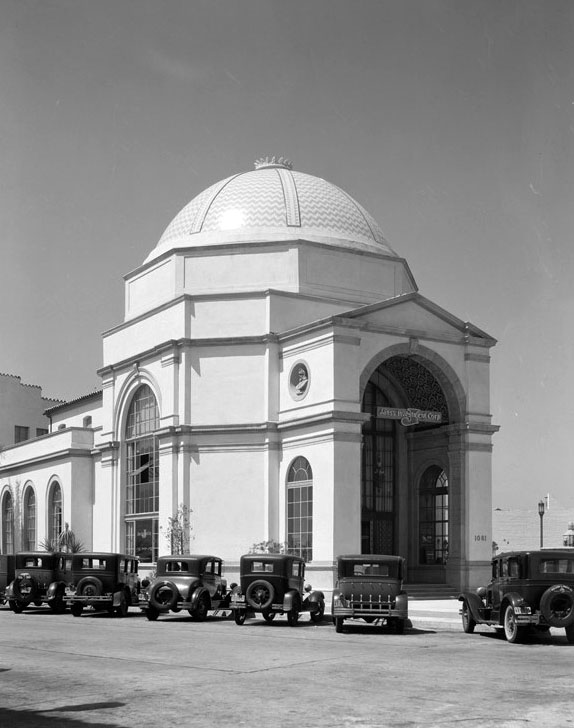 |
|
| (ca. 1930s)* - View showing the front entrance to the Janss Dome. Sign near the top of the arch reads Janss Investment Comp. with a large letter "J" overlapping it. |
Historical Notes In 1988, the Janss Investment Company Building (Janss Dome) was dedicated as a Los Angeles Historic-Cultural Monument No. 364 (Click HERE to see complete listing). It is also listed in the U.S. National Register of Historic Places. |
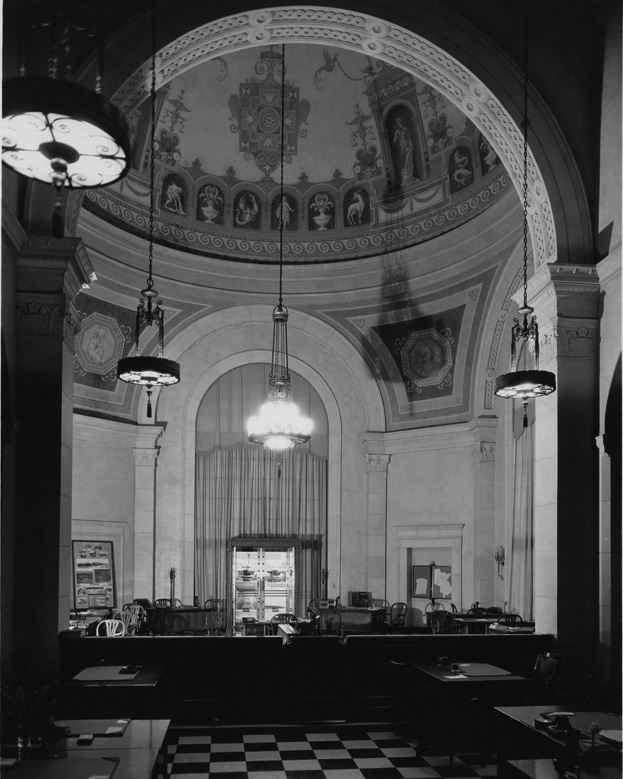 |
|
| (ca. 1930s)* - Interior view of the ornately designed Janss Dome circa 1930s. |
Historical Notes The Janss Dome was designed by the architectural firm of Allison & Allison who also designed UCLA’s Royce Hall and Kerckhoff Hall. Architectural features of the building include a high portico and arched windows with the main part of the building having an octagonal shape and being surmounted by its signature dome with its Moorish style aqua and white zig-zag pattern and gold leafing. Atop the dome is a cupola. |
 |
|
| (ca. 1930s)* - Looking up at the beautiful rotunda ceiling of the Janns Dome Building. |
Historical Notes Around the beginning of the 1990s renowned architectural firm Morphosis adapted the Dome for use as a clothing store by Contempo Casuals, and later it was occupied by a Wherehouse Music store. In 1998 restaurateur Michael Chow remodelled the interior for a Eurochow restaurant but had the time-honored aqua and white zig-zag on the rotunda painted over in white. This caused the Westwood Design Review Board to order that the dome be restored to its traditional decoration. The Janss Dome currently houses a Japanese restaurant, the Yamato. |
Then and Now
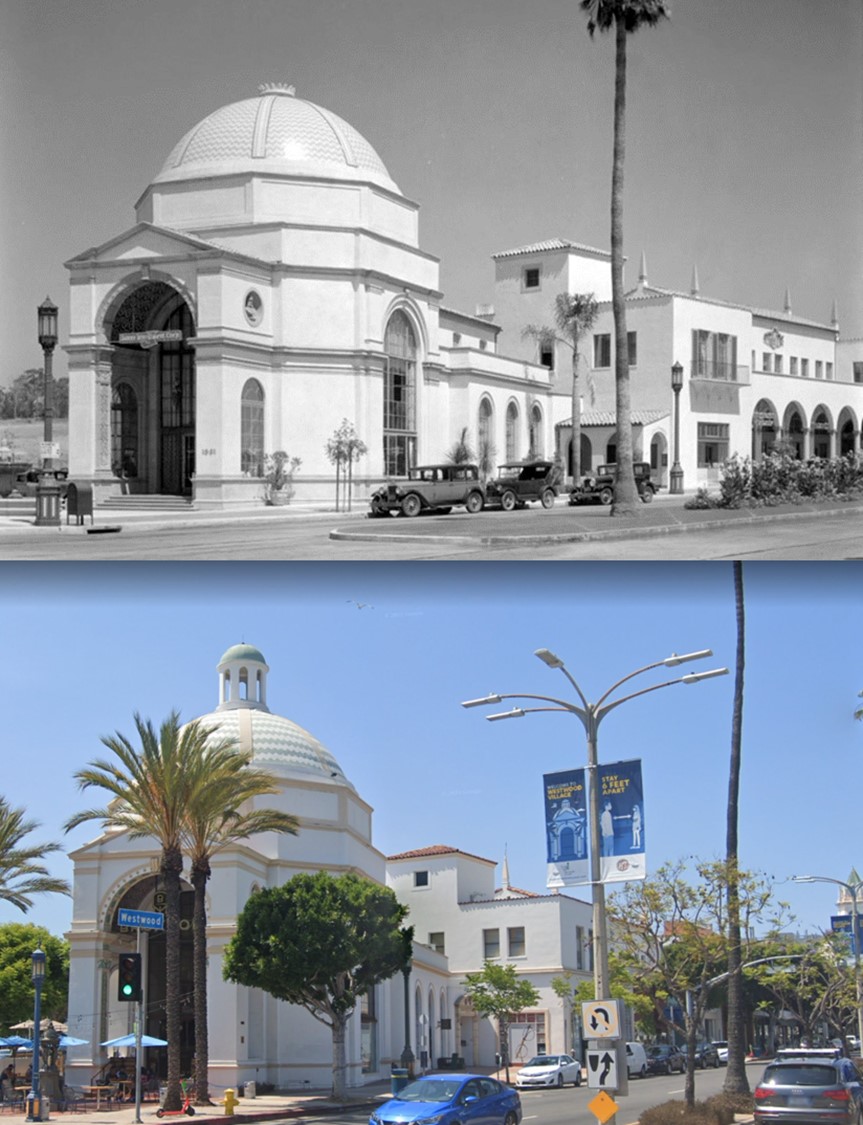 |
|
| Then and Now* – In 1929 the Janss Dome was the first building erected in the Mediterranean-themed Westwood Village. It was designed by the architectural firm of Allison & Allison, who also designed UCLA’s Royce Hall and Kerckhoff Hall. Then and Now comparison by Jack Feldman. |
Historical Notes The building is currently (2022) occupied by the Broxton Brewery & Public House. |
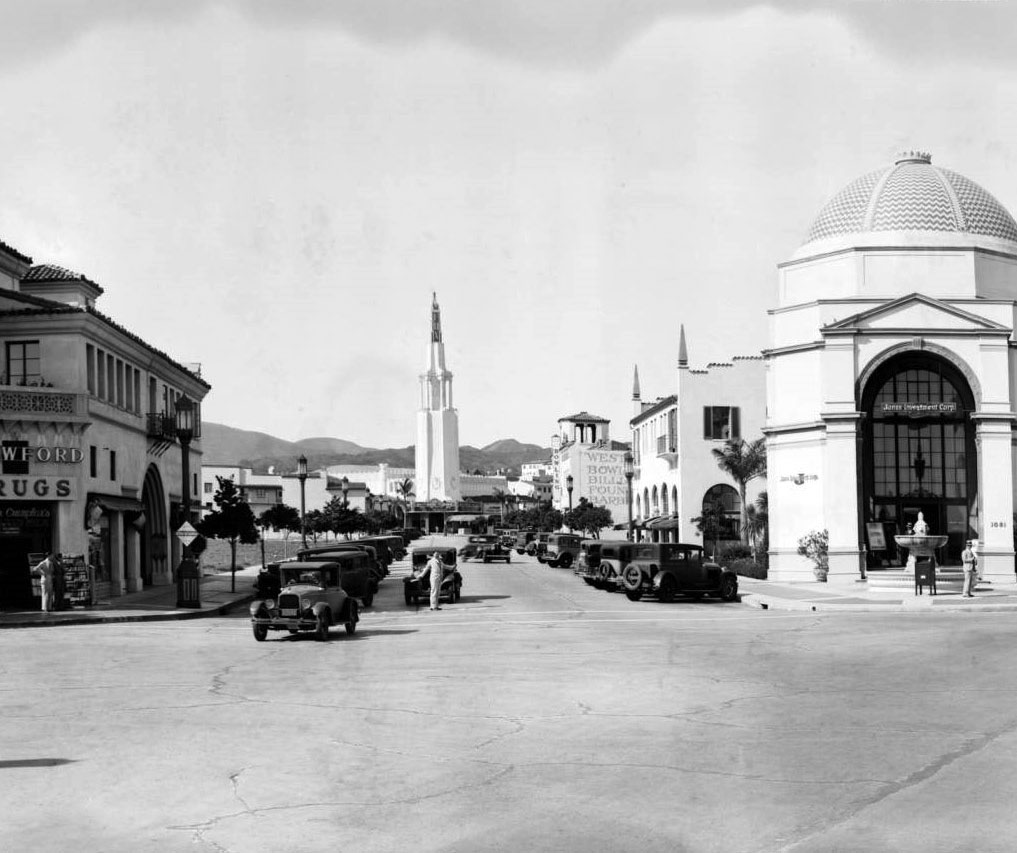 |
|
| (1932)* - View looking north on Broxton Avenue with the tower of the Fox Theatre in the distance and the Janss Dome on the right. |
Historical Notes The Janns Dome ranks alongside the white Spanish Revival/Moderne tower of the Fox Theater as an iconic landmark of Westwood Village. |
 |
|
| (1932)* - A panoramic view of Westwood Village in Westwood, Los Angeles. The domed building in the center is the Janss Investment Corp., and the road to the right of it is Westwood. Left of that is the University Professional Building, with Crawford Drugs at the corner on the ground level. The spire down the street between Janss and the Professional building is the Fox Theatre. Across Westwood from Janss is the Citizens National Trust & Savings Bank. On the west side of Westwood in the background is the tower of the Holmby Building. The cross street is now Kinross Avenue, while the street leading to the theater is Broxton. |
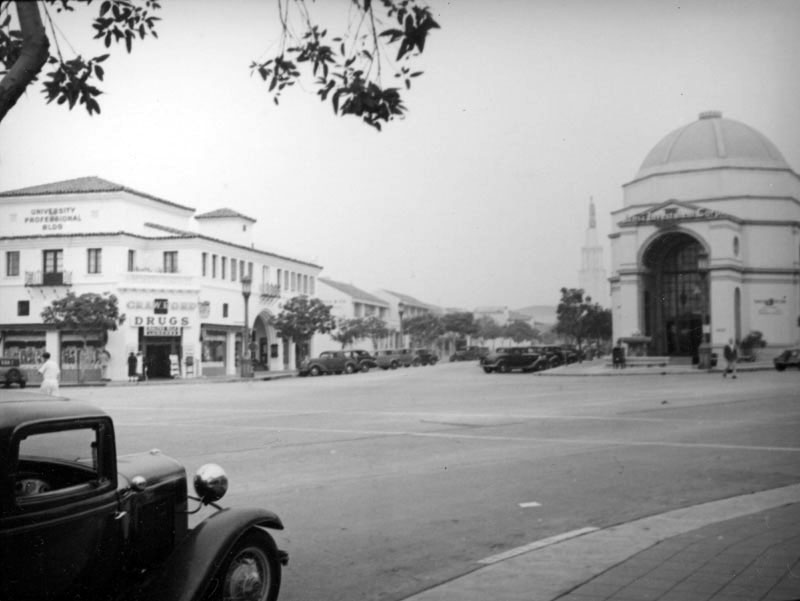 |
|
| (ca. 1940)*- View of Westwood Boulevard, Westwood Village, showing Crawford Drugs and the Janss Dome housing Janss Investment Company--the developers of Westwood. |
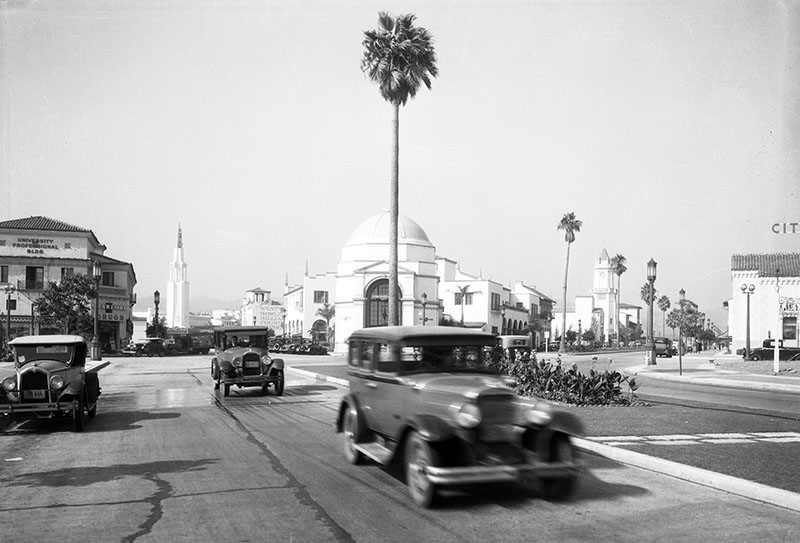 |
|
| (1932)* - View looking north up Westwood Boulevard from south of Kinross Avenue. |
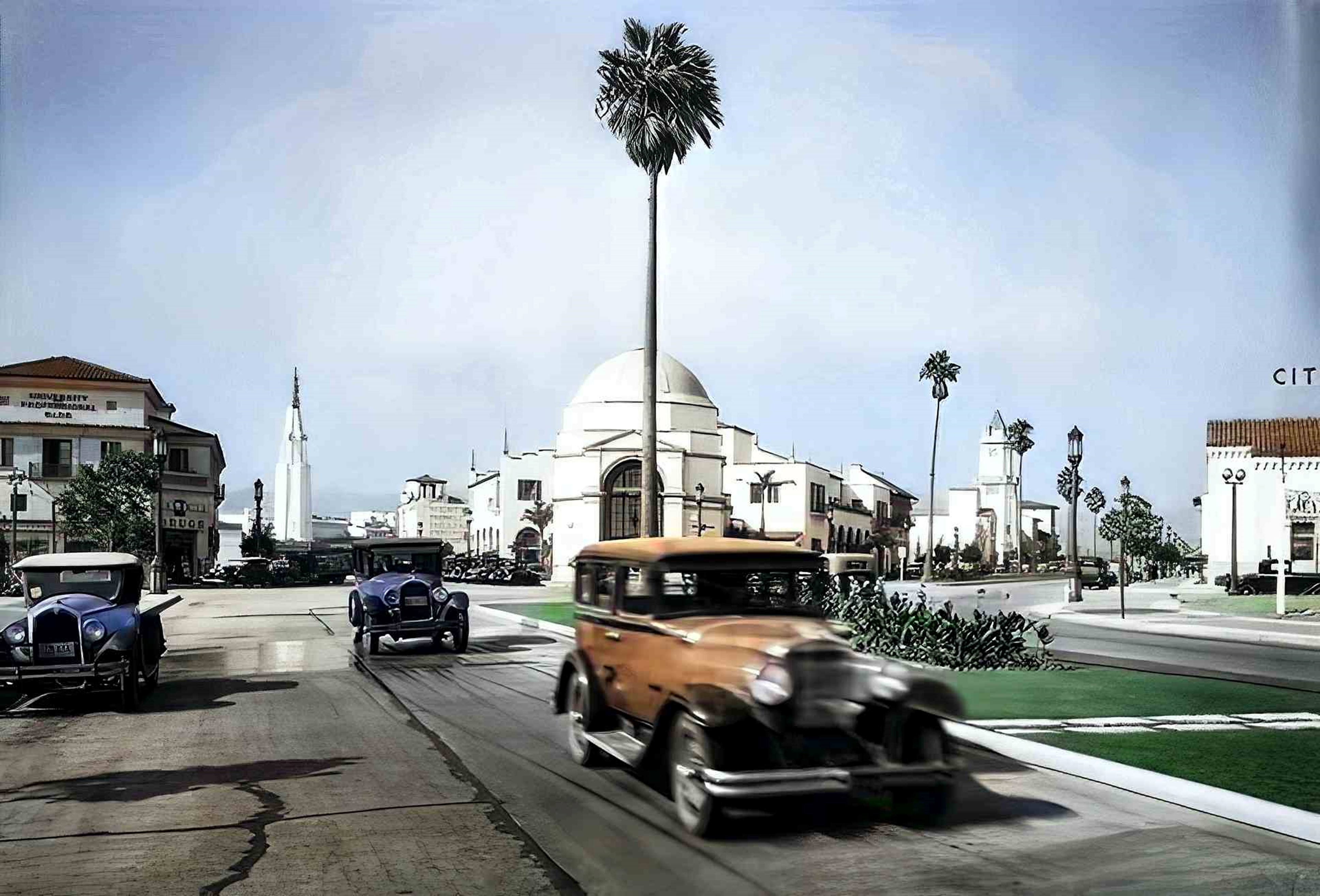 |
|
| (1932)* - View looking north up Westwood Boulevard from south of Kinross Avenue. Image enhancement and colorization by Richard Holoff |
Then and Now
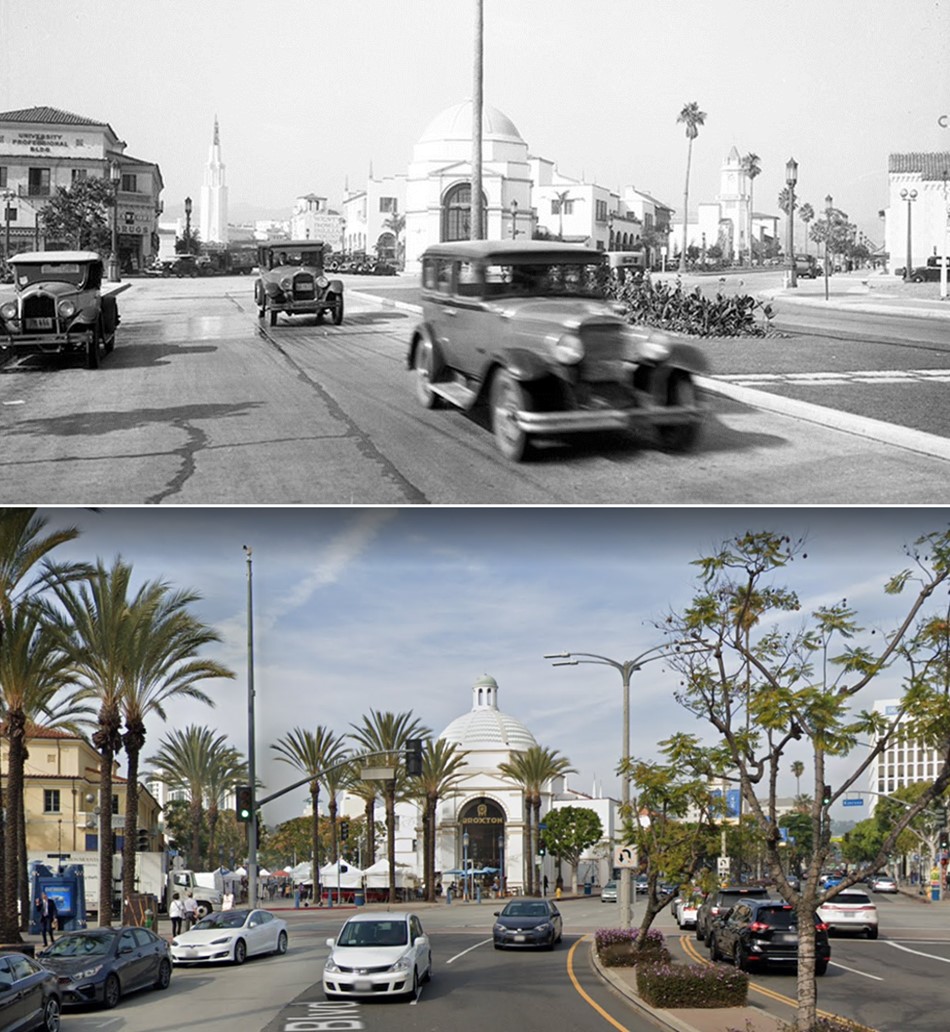 |
|
| (1932 vs 2021)* – Looking north up Westwood Boulevard from south of Kinross Avenue. Photo comparison by Jack Feldman. |
 |
|
| (1932)* - View looking north on Westwood Boulevard from Kinross Avenue. The tall clock tower in the distance is the Holmby Building. The building on the N/E corner of Westwood and Kinross is the Citizens National Trust & Savings Bank. |
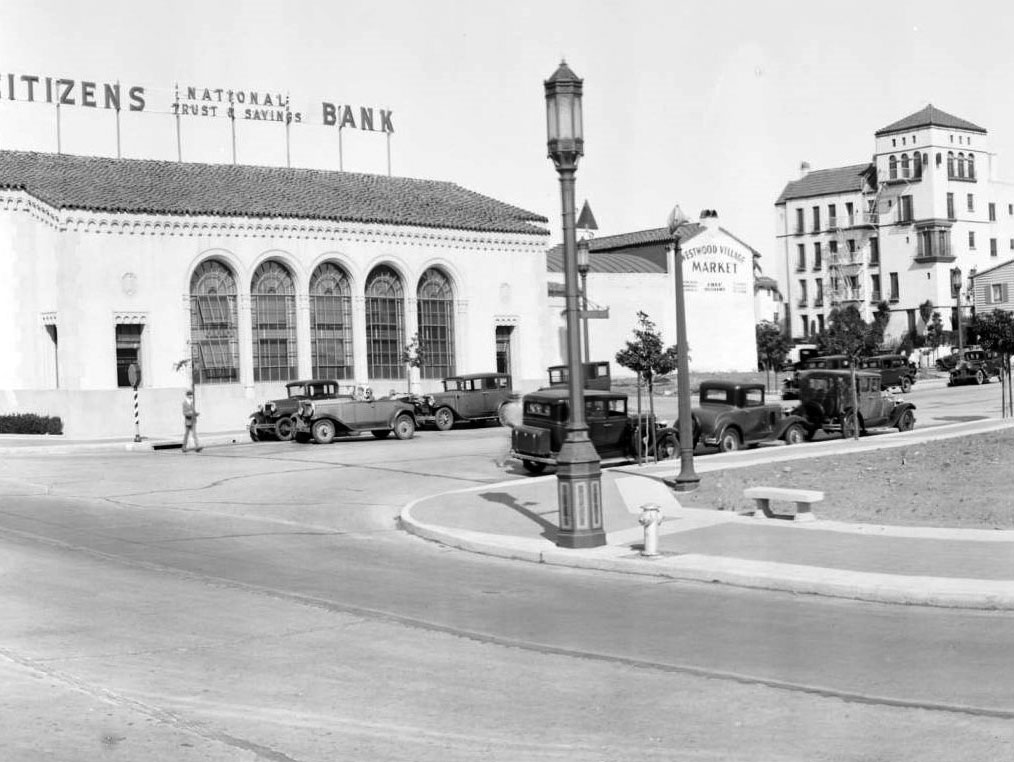 |
|
| (1932)* – View looking northeast showing the intersection of Westwood Boulevard and Kinross Avenue. Citizens National Trust & Savings Bank is on the N/E corner. On the S/E corner stands a “Westwood Special” streetlamp. Click HERE to see more Early LA Streetlights. |
Historical Notes Citizens began as a state bank in 1890 at Third and Spring in Los Angeles. In 1928, Citizens merged with Citizens Trust and Savings, creating Citizens National Trust & Savings Bank of Los Angeles. Architect William V. Kernan designed the original 1930 Spanish Colonial Revival University-Westwood branch location at 1088 Westwood Boulevard, with brick construction covered with stucco and featuring an art stone entrance and a coffered paneled ceiling. This branch was replaced in 1952 by a new building designed by Stiles Clements, located at 10925 Kinross. |
* * * * * |
Holmby Hall Building
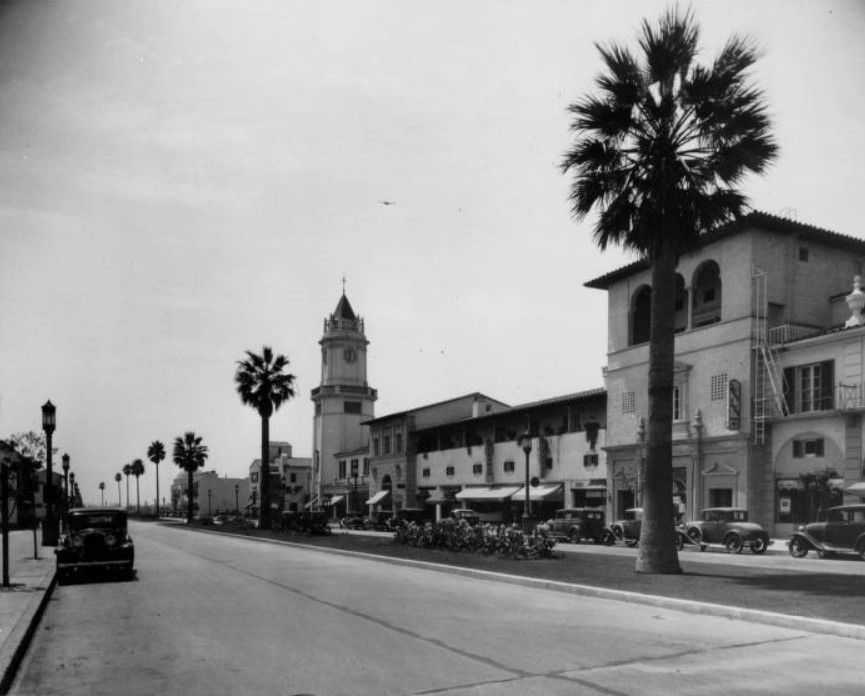 |
|
| (1931)* - View looking south at car-lined Westwood Boulevard. The tall clock tower in the distance is part of the Holmby Hall Building. |
Historical Notes The name Holmby was loosely derived from the name of Arthur Letts' birthplace, a small hamlet in England called Holdenby. It was also the name of Letts' new development “Holmby Hills” and his estate in Hollywood. |
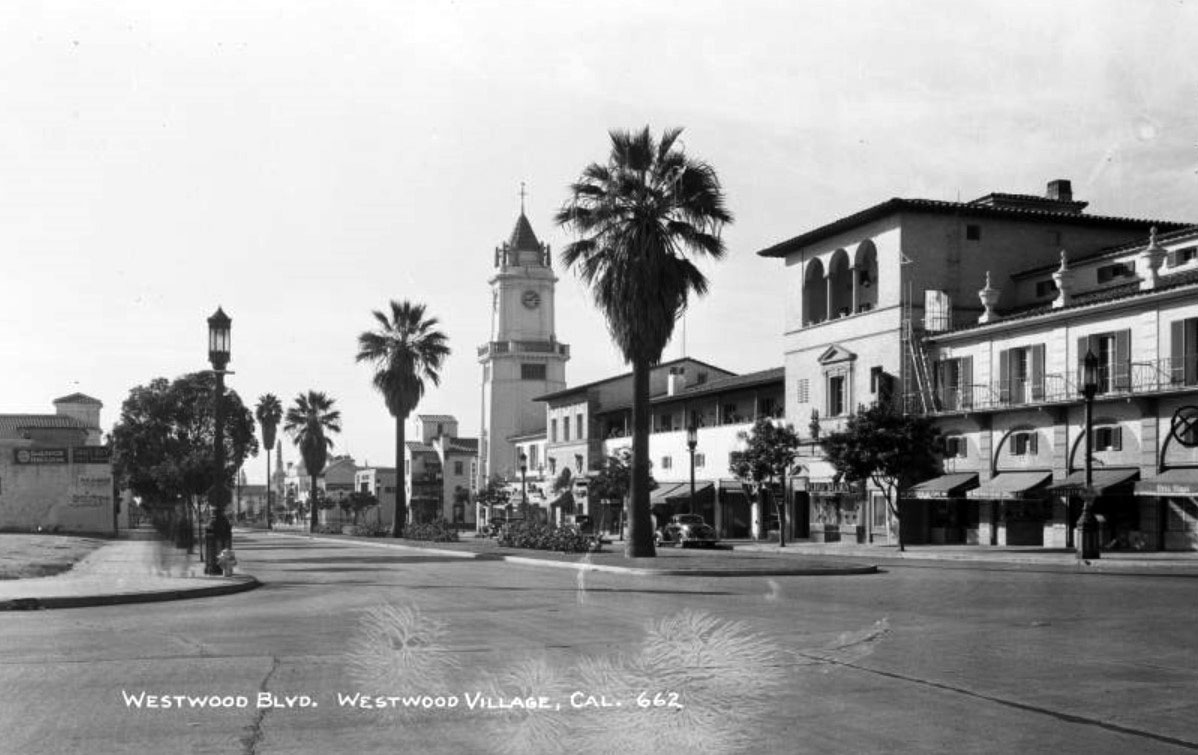 |
|
| (1930s)* - Postcard view looking south on Westwood Boulevard from Le Conte Avenue. The Holmby Building with clock tower can be seen at center, located at 921 Westwood Blvd. |
Historical Notes Built in 1929, Holmby Hall is a streetscape of six Spanish Colonial Revival storefronts and features a prominent white clock tower, capped by a green pinnacle. It was the first shop building to be erected in the architecturally significant cinema/shopping precinct of Westwood Village. |
 |
|
| (ca. 1930)* – View looking north showing the beautiful Holmby Building with its clock tower at the corner of Westwood Blvd and Weyburn Ave. |
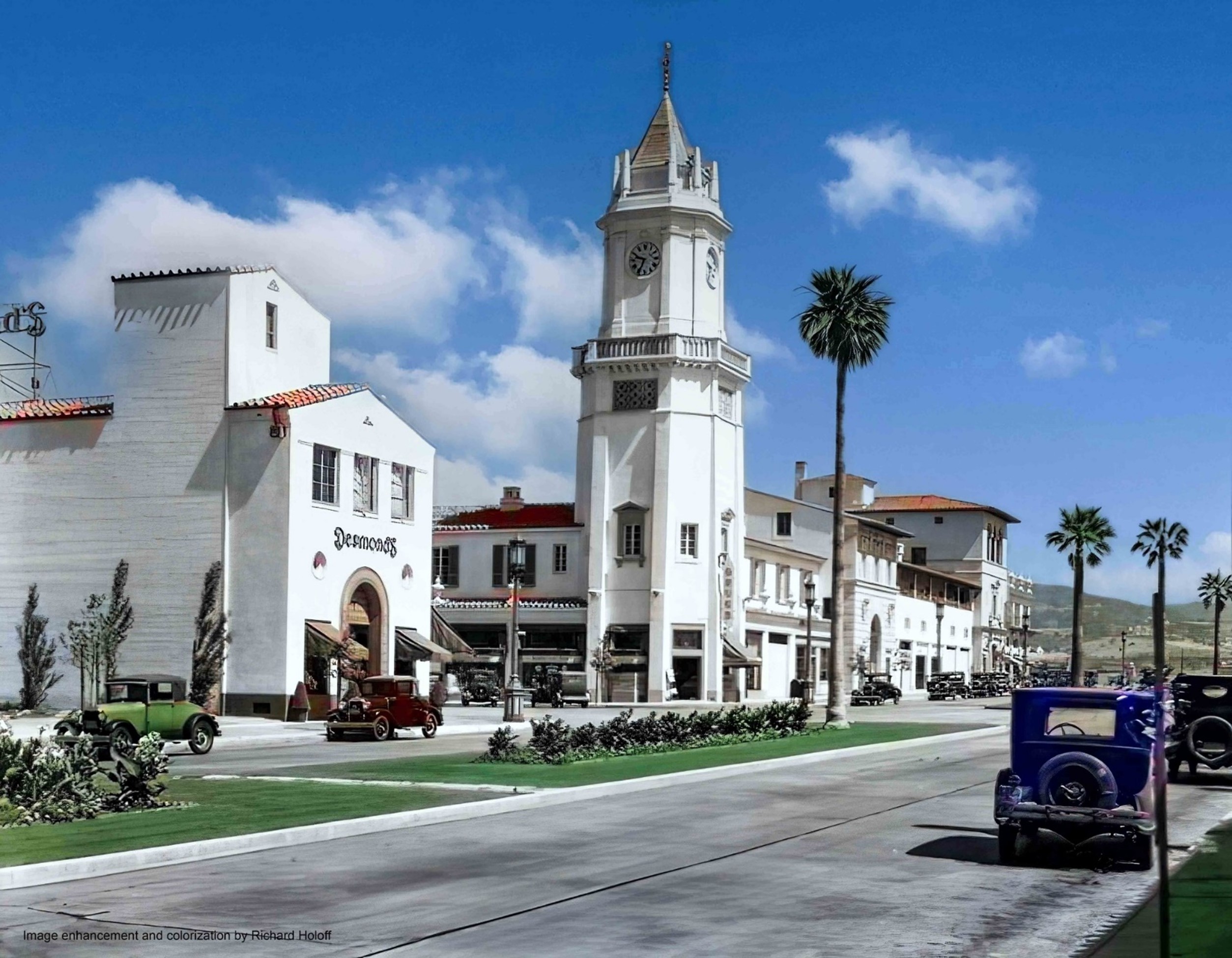 |
|
| (ca. 1930)* – View looking north showing the beautiful Holmby Building with its clock tower at the corner of Westwood Blvd and Weyburn Ave. Image enhancement and colorization by Richard Holoff. |
 |
|
| (ca. 1930)* – View looking north toward the intersection of Westwood Boulevard and Weyburn Avenue, showing Desmond's Department Store on the S/W corner and the Holmby Building on the N/W corner. |
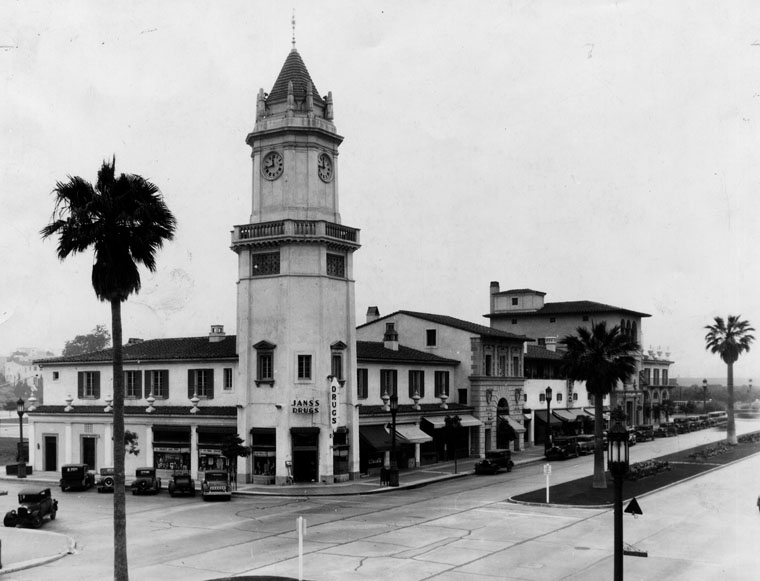 |
|
| (1932)* - Exterior view of Holmby Building, designed by Gordon B. Kaufmann, in Westwood Village. |
Historical Notes Holmby Hall’s history is tied in with that of UCLA, as the building was used as the first dormitory for female students of that famous university. |
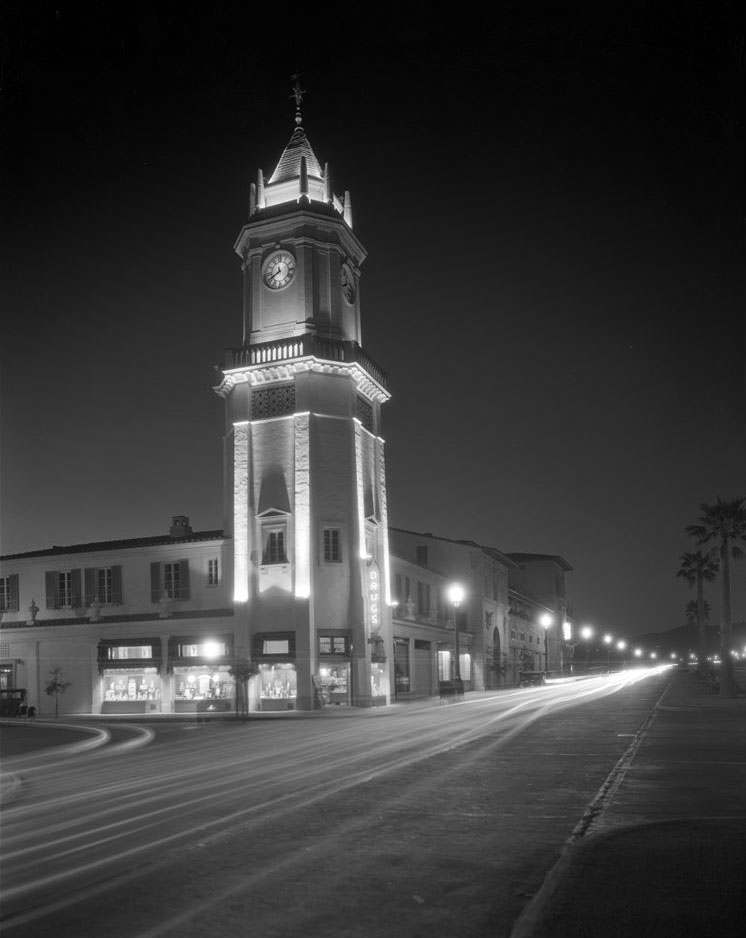 |
|
| (1930)* - Nightime view of the Westwood Drug Store with the Clock Tower. |
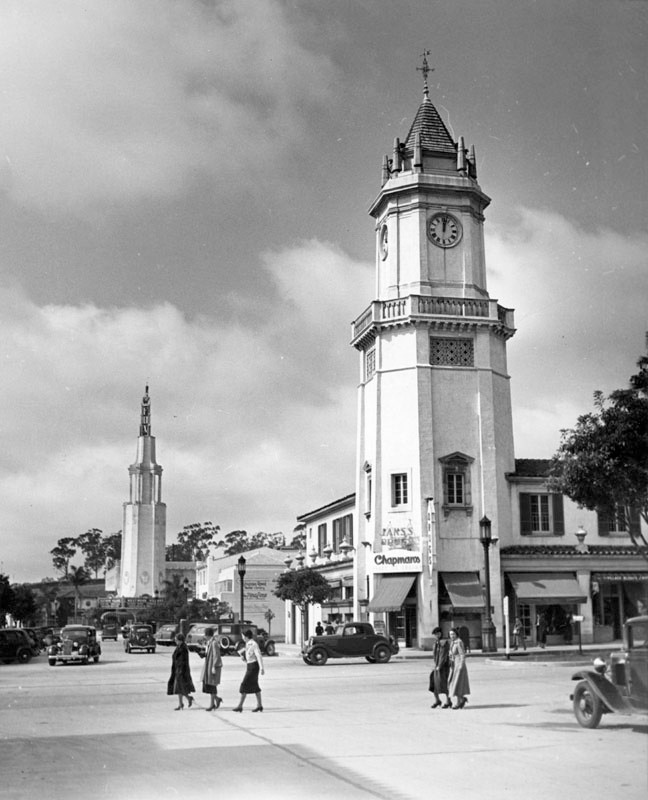 |
|
| (ca. 1938)* - A street scene looking west on Weyburn Ave at Westwood Boulevard. The Holmby Building stands tall on the northwest corner with Chapmans occupying the corner store. Down the street is Fox Westwood Village Theater. |
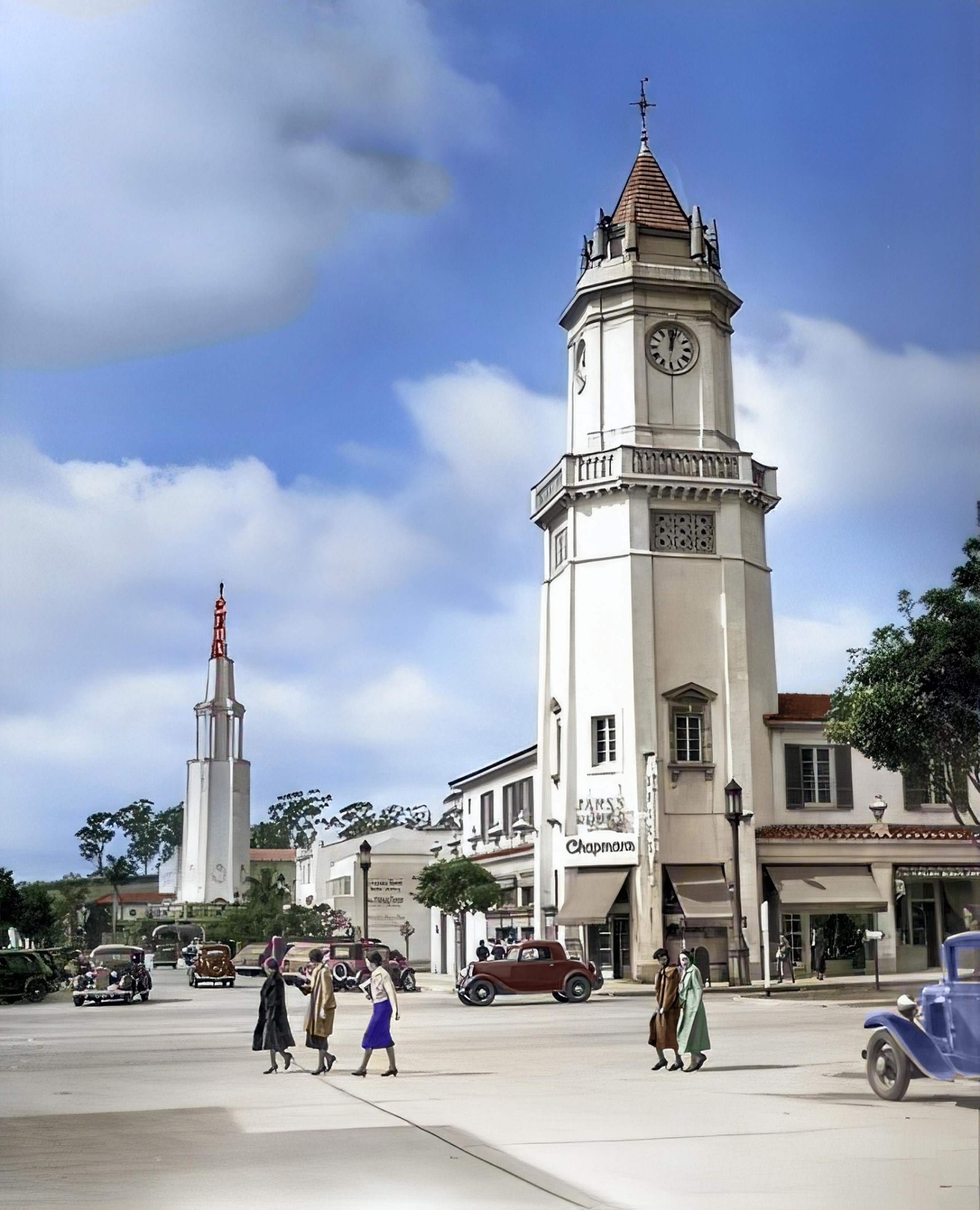 |
|
| (ca. 1938)* - A street scene looking west on Weyburn Ave at Westwood Boulevard. The Holmby Building stands tall on the northwest corner with Chapmans occupying the corner store. Down the street is Fox Westwood Village Theater. Image enhancement and colorization by Richard Holoff |
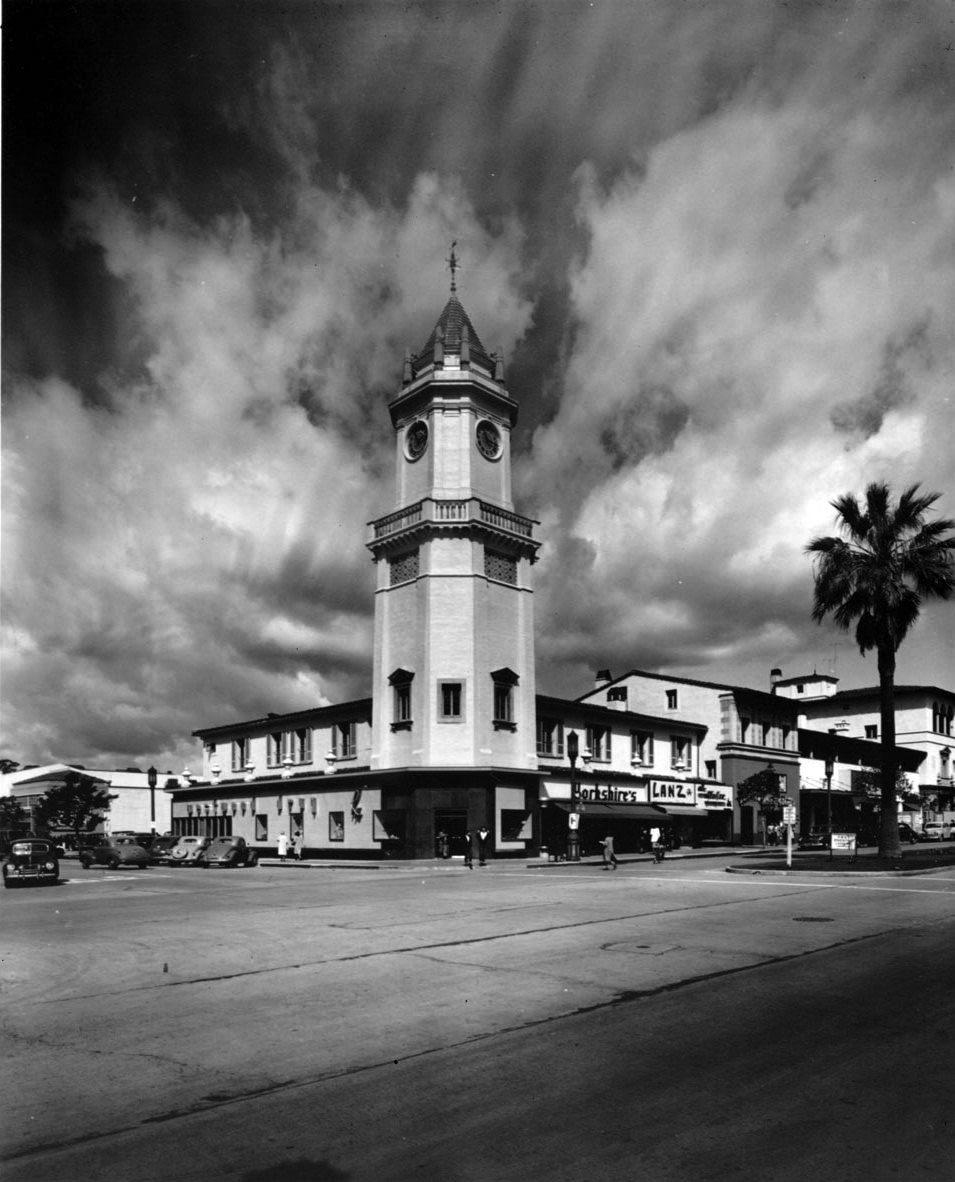 |
|
| (ca. 1948)* - A closer view of the Holmby Building (Hall) located at 921 Westwood Boulevard in the block between Weyburn and Le Conte Avenues, with the clock tower on the corner of Weyburn Avenue. Westwood Drug occupies the ground floor. |
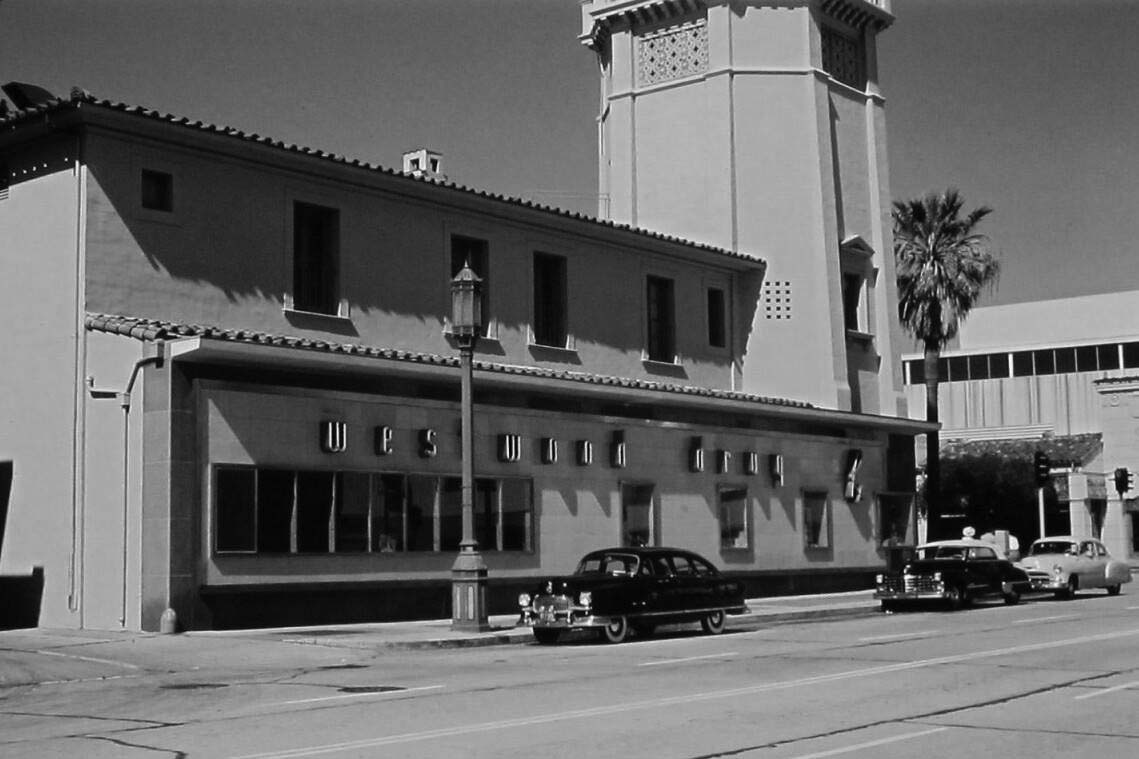 |
|
| (ca. 1950)* – View looking at northwest corner of Westwood Boulevard and Weyburn Avenue showing the Westwood Drug Store located on the ground floor of the Holmby Building. |
* * * * * |
Desmond's
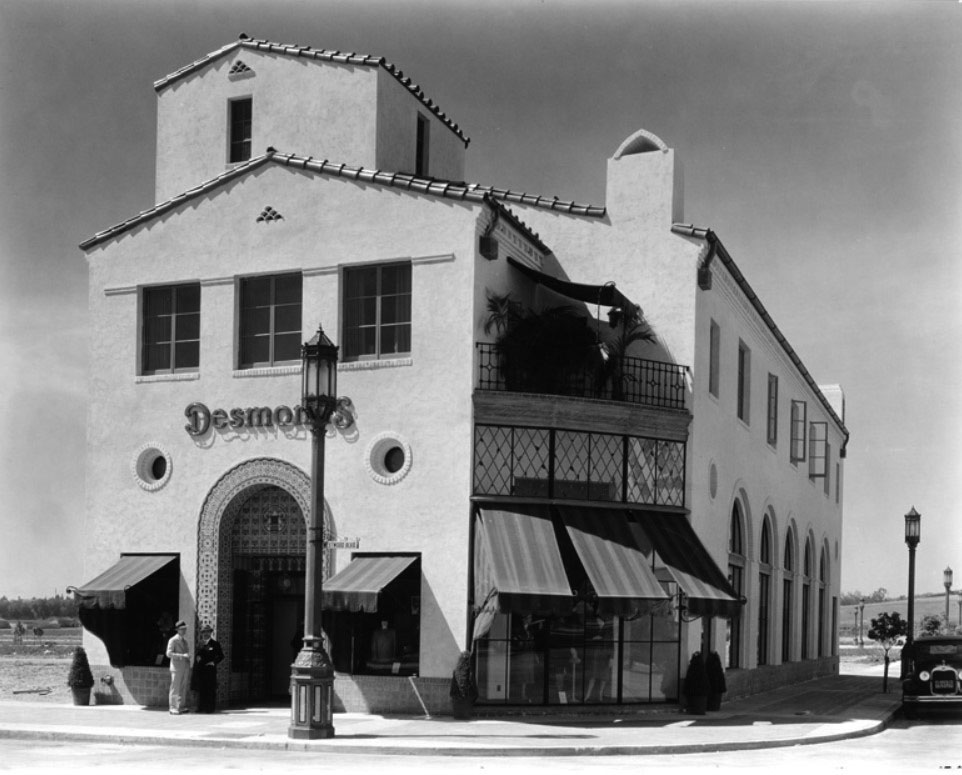 |
|
| (1929)* – View showing two men standing by the entrance of the recently built Desmond’s Building located at 1001 Westwood Blvd. Note the ornate streetlights. These would later be known as "Westwood Specials" streetlights. |
Historical Notes The first Desmond's Department Store was opened on Olvera Street in 1862. In 1921, Ralph R. Huesman purchased the store from the Desmond family and led the expansion of the retailer to several locations throughout the Southern California market. |
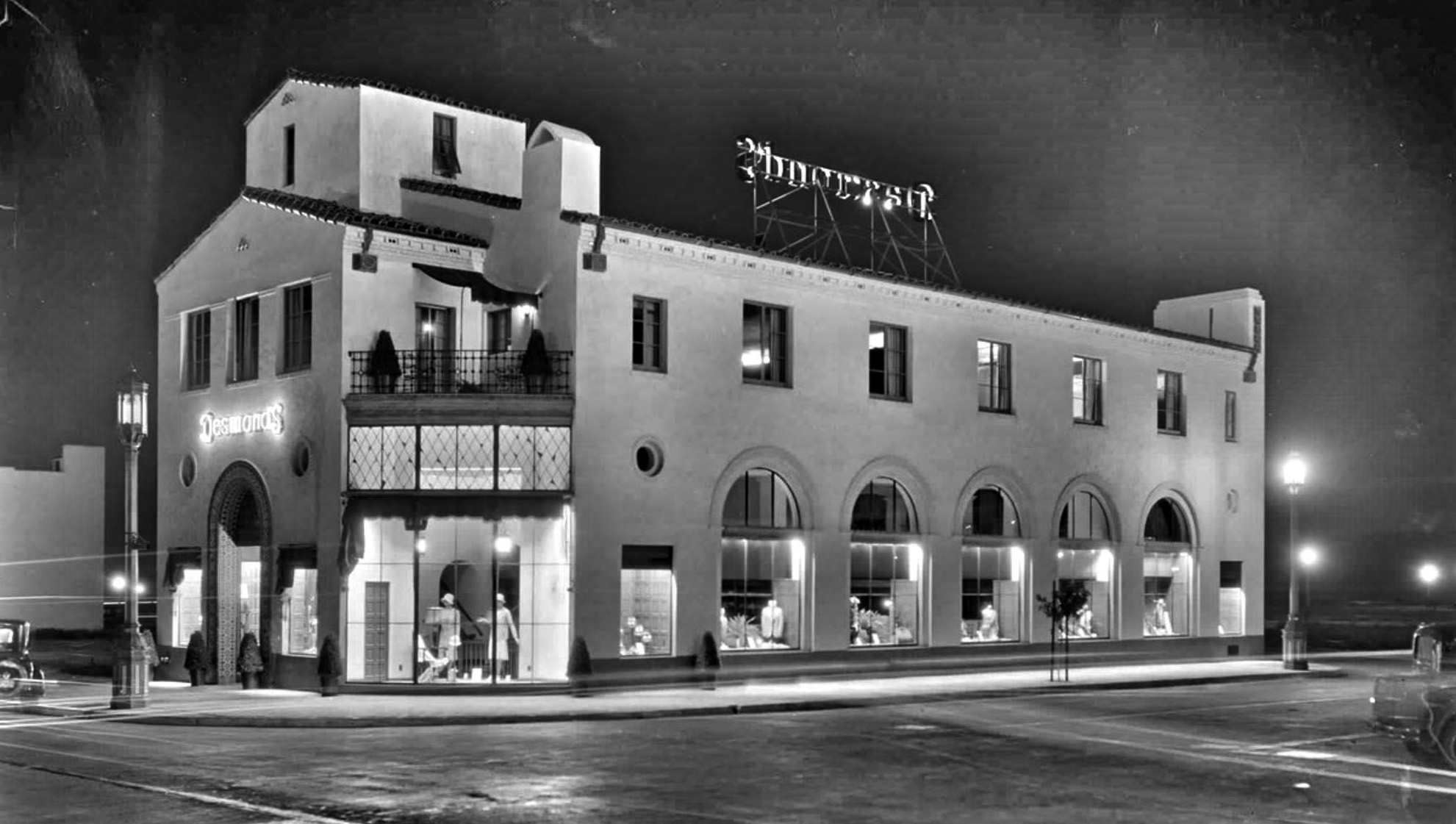 |
|
| (1929)^ - Night view of Desmond’s Clothing Store located on the SW corner of Westwood Boulevard and Weyburn Avenue. |
Historical Notes Designed by architect Allen G. Siple, the Westwood Village store opened in December 1929 and was the fifth store in the chain following Downtown, Pasadena, Wilshire and Beverly Hills. |
Then and Now
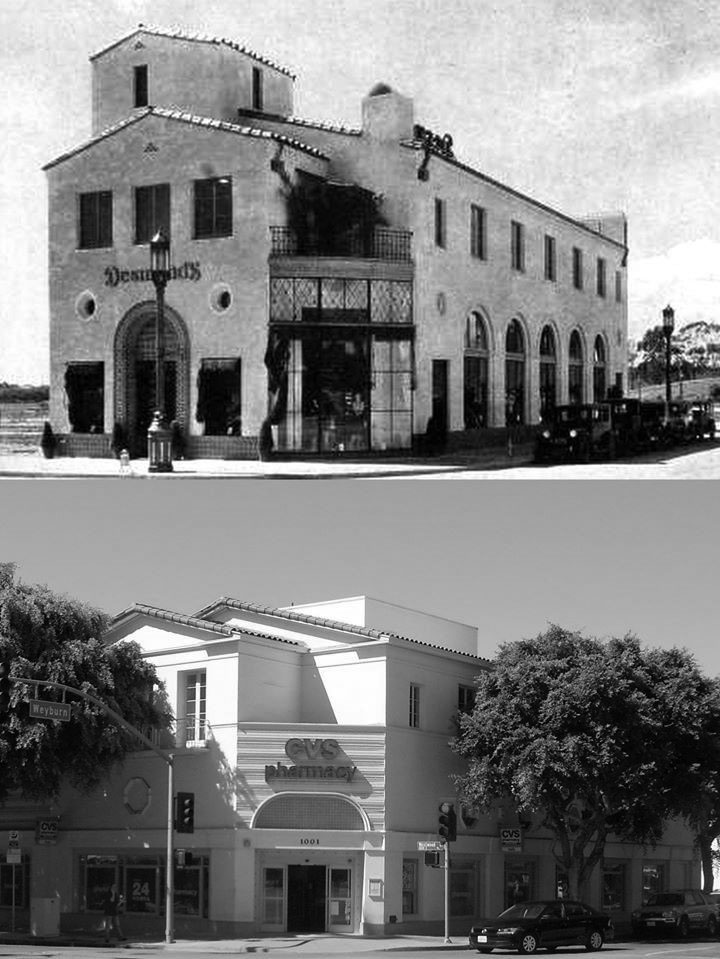 |
|
| (1929) vs. (2020)^.^ - Desmond's Building, today a CVS Pharmacy. |
Historical Notes Today, the Westwood Desmond’s building is occupied by a CVS store. Click HERE for more contemporary views. |
* * * * * |
 |
|
| (1932)*- View showing the Intersection of Le Conte Ave and Westwood Blvd with the Holmby Hall Building seen on the left. |
Historical Notes Opening in 1929, the original design of Westwood Village was considered one of the most well planned and beautifully laid out of commercial areas in the nation. Harold Janss had hired major architects and instructed them to follow a Mediterranean theme, with clay tile roofs, decorative Spanish tile, paseos, patios and courtyards. Buildings located at strategic points, including theaters, used towers to serve as beacons for drivers on Wilshire Boulevard. Janss picked the first slate of businesses and determined their location in the neighborhood; the area opened with 34 businesses, despite the Great Depression, had 452 in 1939. |
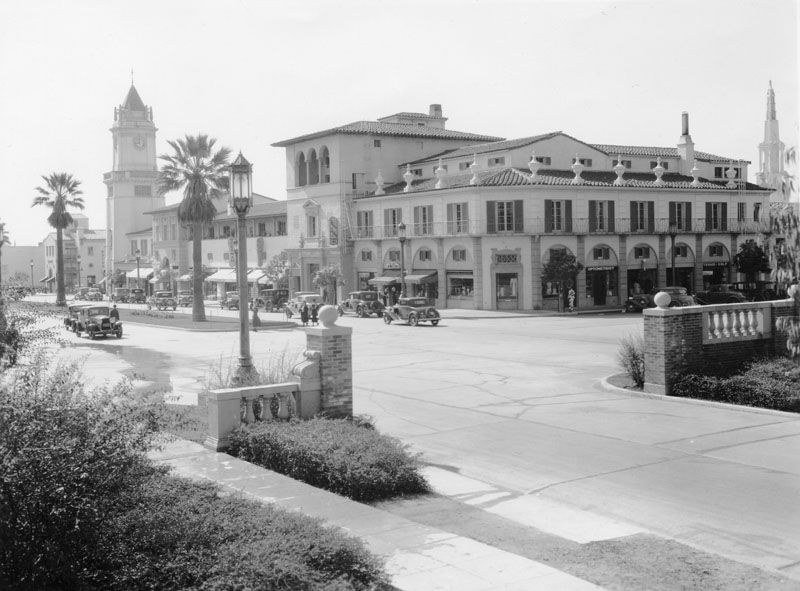 |
|
| (ca. 1937)* - The intersection of Le Conte Avenue and Westwood Boulevard, looking southwest. On the far side is the Holmby Building in Westwood Village. It is a retail and office building in the California Mediterranean style. |
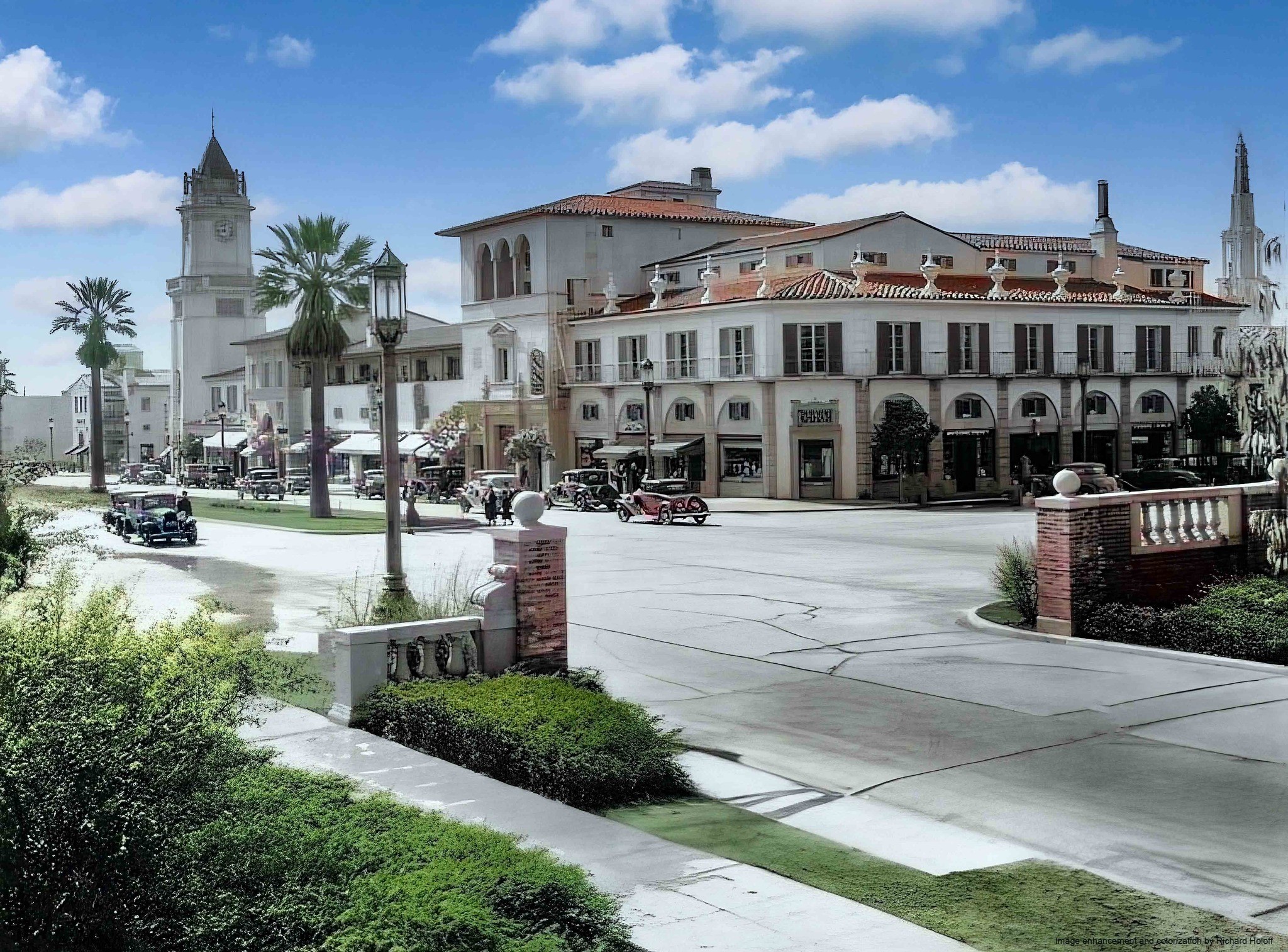 |
|
| (ca. 1937)* - The intersection of Le Conte Avenue and Westwood Boulevard, looking southwest. On the far side is the Holmby Building in Westwood Village. It is a retail and office building in the California Mediterranean style. Image enhancement and colorization by Richard Holoff |
Ralphs Market
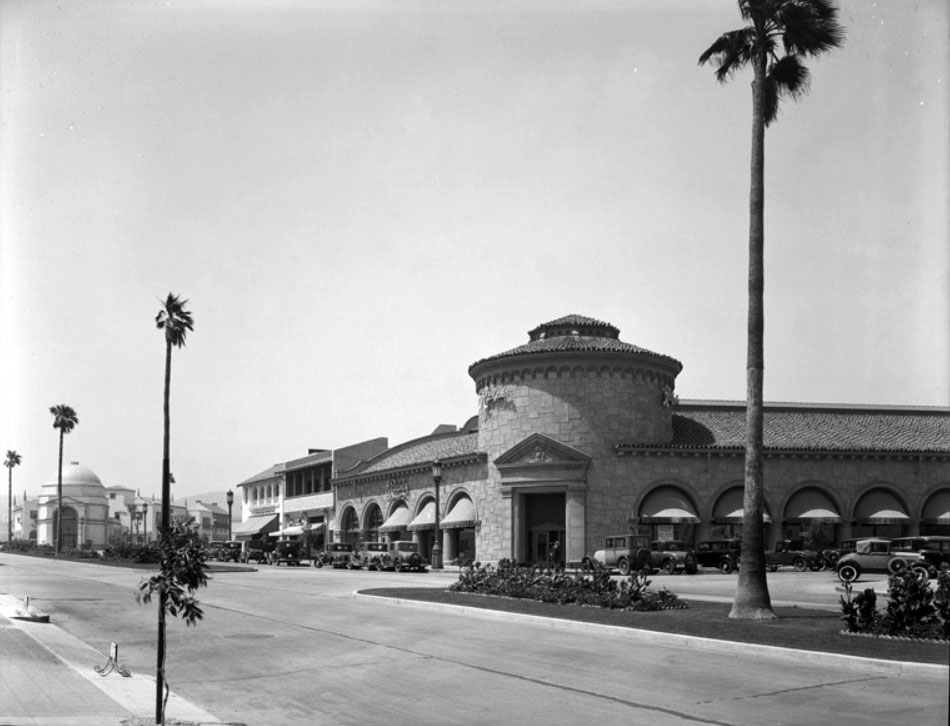 |
|
| (1930s)#^ - View showing the Westwood Ralphs Market designed by Russell E. Collins and S. N. Benjamin in Mission Revival/Spanish Colonial Revival style. |
Historical Notes When the new Westwood Village began to open in 1929, one of its original buildings was the Ralphs Grocery Store located on Westwood Boulevard, one block north of Wilshire Boulevard. The store's most prominent feature was its low rotunda, at the corner of Westwood Boulevard and Lindbrook Drive. The building's exterior walls were built with imitation stone, but were later covered with stucco. The building's style has been described as having Mission Revival, Spanish Colonial Revival, Romanesque Revival and Renaissance Revival elements, and is said to have served as a model for other low-rise commercial structures in the village. Early advertising materials for the Westwood Village development featured images of the Ralphs tower and the Janss dome, which became area landmarks. The opening of the store in the fall of 1929 was timed to coincide with the opening of the UCLA campus, and the Los Angeles Times proclaimed the store "one of the most beautiful exclusive grocery marts in the West." The opening was celebrated with a free food show, as Ralphs boasted a new feature at their Westwood store — "the employment of uniformed boys to wrap each purchase of merchandise while it is being paid for at the cashier's stand, and then carry it to the customer's car."* |
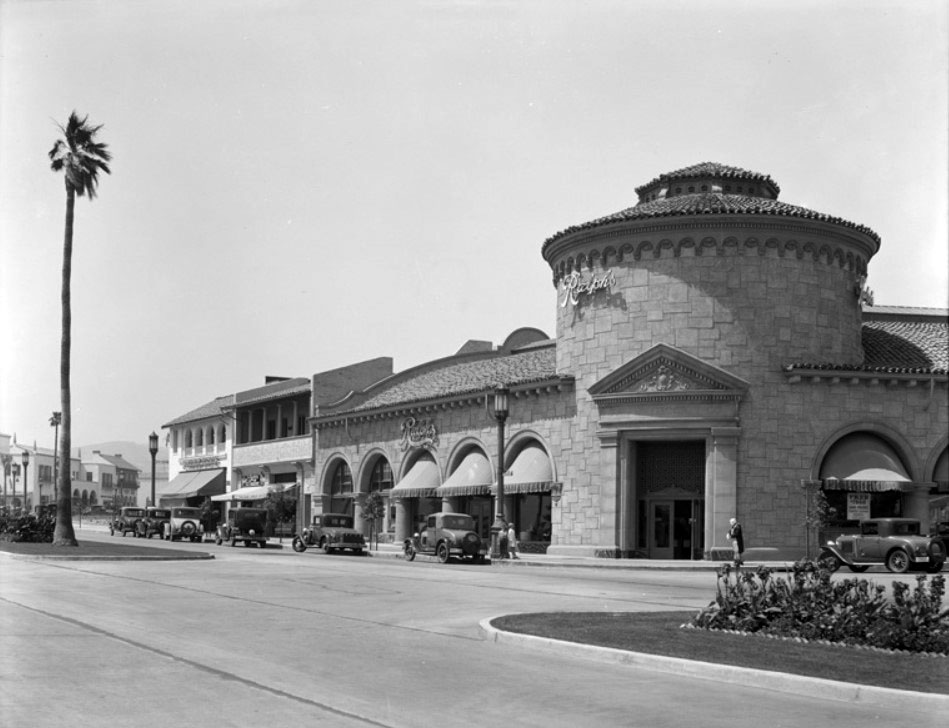 |
|
| (1930s)#^ – View looking north on Westwood Boulevard showing Ralphs Market located on the northeast corner of Westwood and Lindbrook Drive. |
Historical Notes Ralphs operated a grocery store on the site until the mid-1960s, when it left Westwood Village. Ralphs returned to Westwood Village nearly 40 years later, converting the old Bullock's department store into a grocery store (formerly sharing the space with a Best Buy and an Expo Home Design Center). Since Ralphs vacated the building in the mid-1960s, it has housed a number of different businesses. In 1970 a large portion of the space facing Lindbrook Drive was converted into a movie theater, which was known over the years as the United Artists Theater, the UA Egyptian, the Odeon Cinema and finally as the Mann Festival which closed on July 30, 2009. The Bratskeller restaurant, popular with UCLA students, also operated at the building from the late 1960s through the mid-1980s. In the late 1990s and early 2000s the prime corner space at the base of the tower was split between Daphne's Greek Cafe and Togo's Sandwich Restaurant. In late 2008, they were replaced with a Peet's Coffee & Tea, which remains currently. In early 2012, part of the shuttered movie theater was converted to 800 Degrees Neapolitan Pizzeria.* In 1988, the Ralphs Building was declared Historic-Cultural Monument No. 360. It was also listed on the National Register of Historic Places in 1992.* |
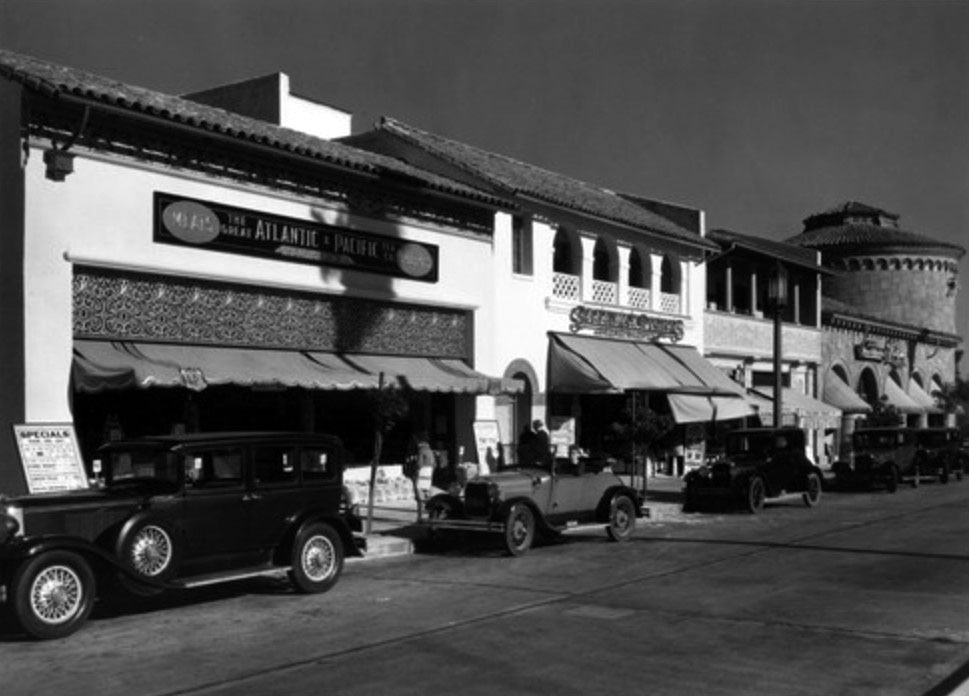 |
|
| (1936)#^ – View looking south on Westwood Boulevard showing cars parked in front of the Great Atlantic and Pacific Tea Company, 1124 Westwood Boulevard. The Ralphs Market rotunda is seen in the distance. |
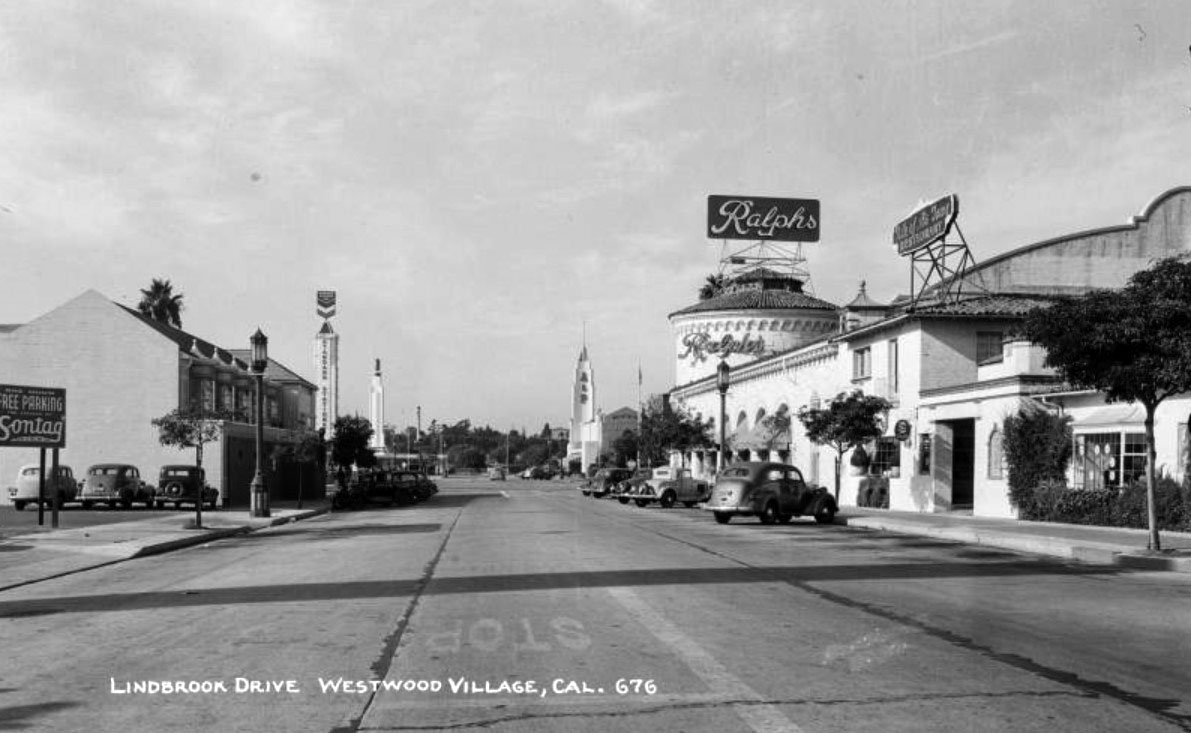 |
|
| (ca. 1939)#* – View looking west on Lindbrook Drive towards Westwood Boulevard where Ralphs Market, with its unique rotunda, stands on the northeast corner. Also seen are the tall towers of two gas stations and the A & P Store. |
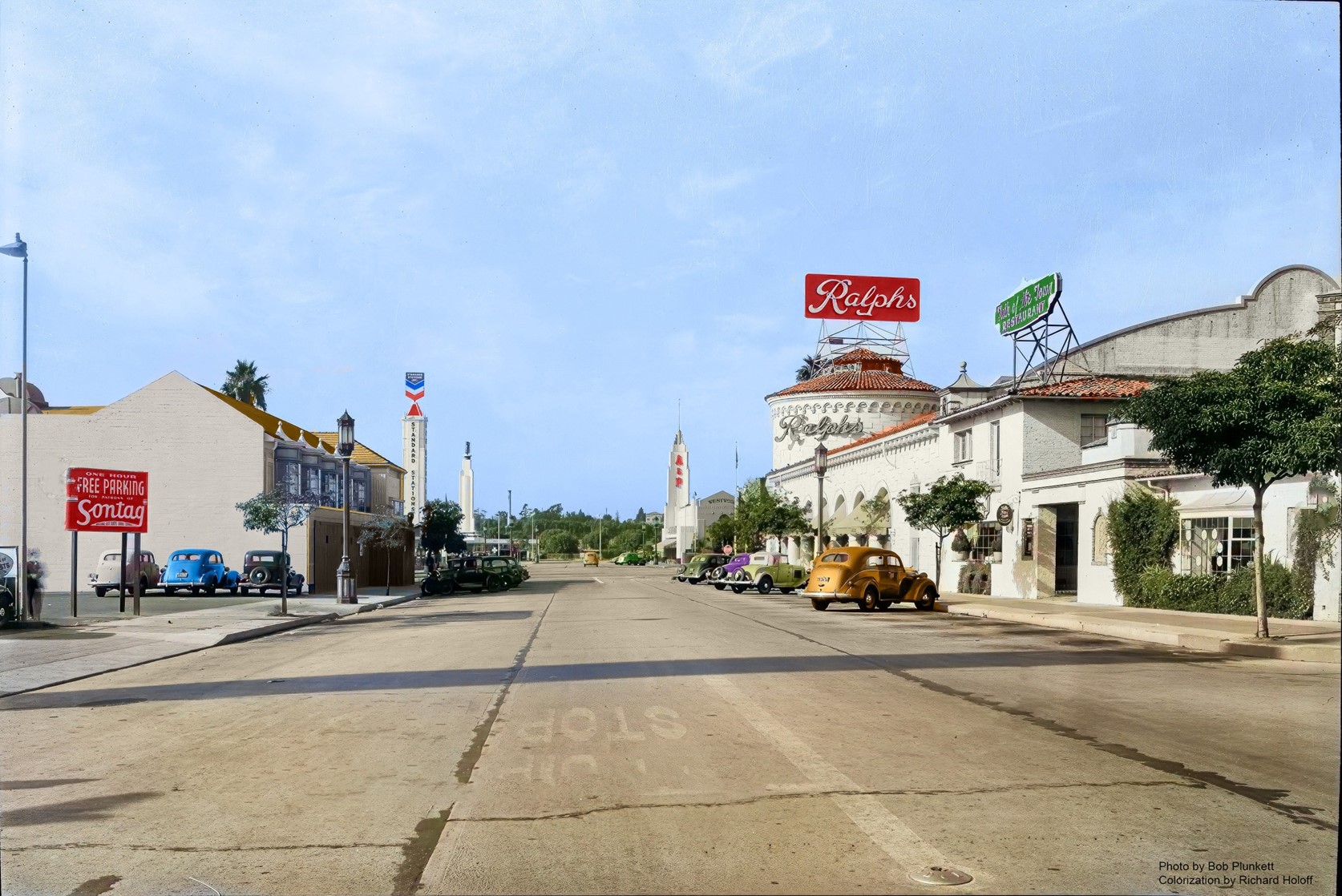 |
|
| (ca. 1939)#* – View looking west on Lindbrook Drive towards Westwood Boulevard where Ralphs Market, with its unique rotunda, stands on the northeast corner. Also seen are the tall towers of two gas stations and the A & P Store. Photo by Bob Plunkett; Image enhanced and colorized by Richard Holoff |
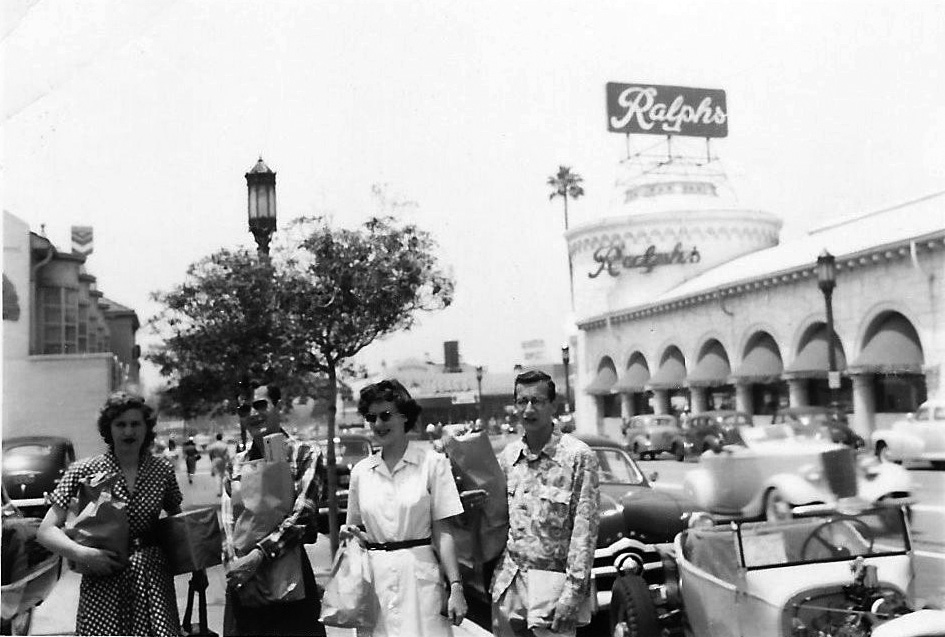 |
|
| (1940s)^.^ – A successful day of shopping in Westwood with Ralphs Market seen in the background. |
Then and Now
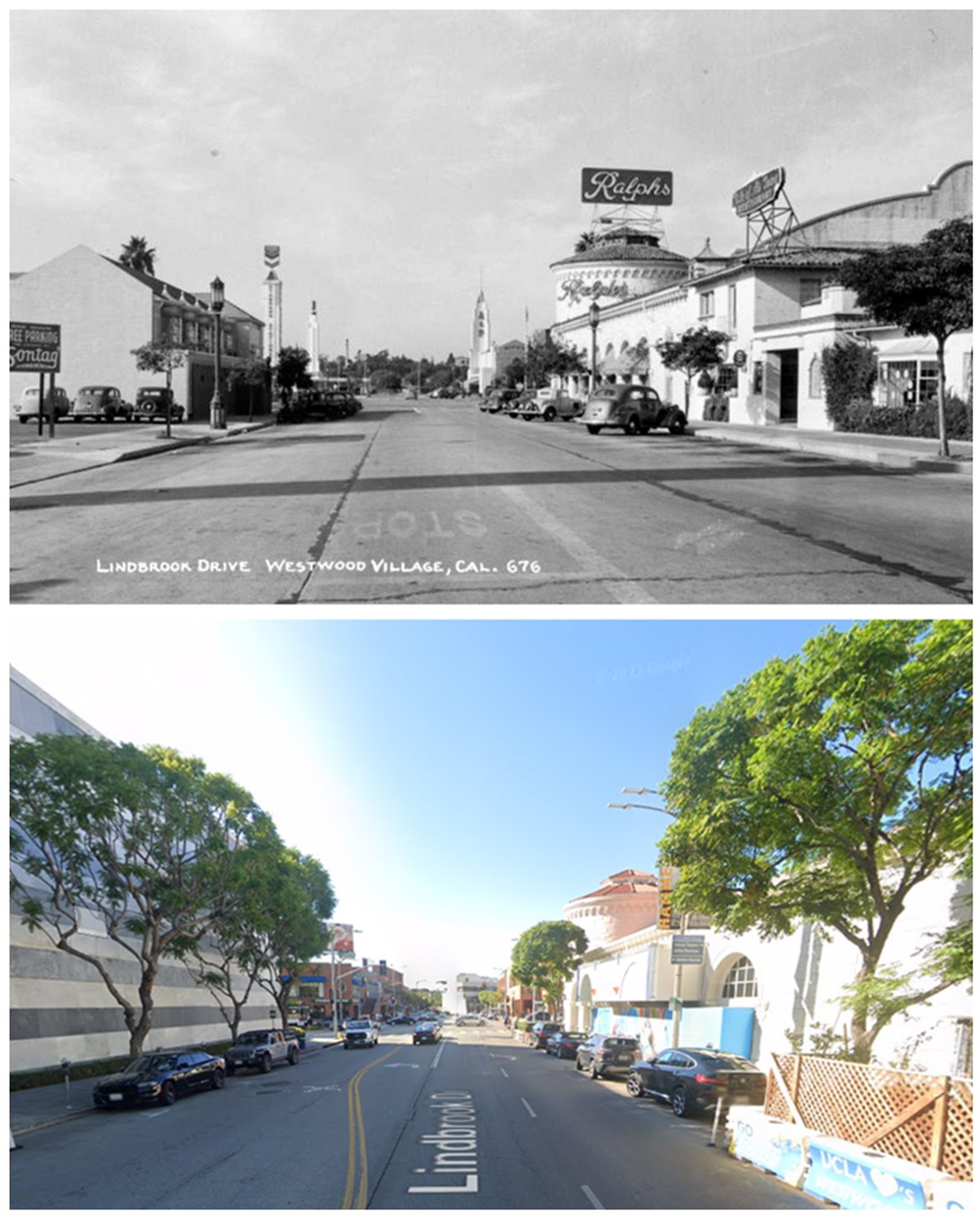 |
|
| (1939 vs 2022)* - Looking west on Lindbrook Drive towards Westwood Boulevard where Ralphs Market building, with its unique rotunda, stands on the northeast corner. |
Then and Now
 |
|
| (1930s vs. 2021)* – The Ralphs Market buildng located on the NE corner of Westwood and Lindbrook in Westwood Village. |
Historical Notes Built in 1929 as a Ralphs Grocery Store, it was one of the original six buildings in the Westwood Village development. The building was noted for its cylindrical rotunda capped by a low saucer dome, with a pediment over the entrance and arcaded wings extending north and east. The opening of the store in the fall of 1929 was timed to coincide with the opening of the UCLA campus, and the Los Angeles Times proclaimed the store "one of the most beautiful exclusive grocery marts in the West."* |
* * * * * |
A&P Market (The Great Atlantic & Pacific Tea Company)
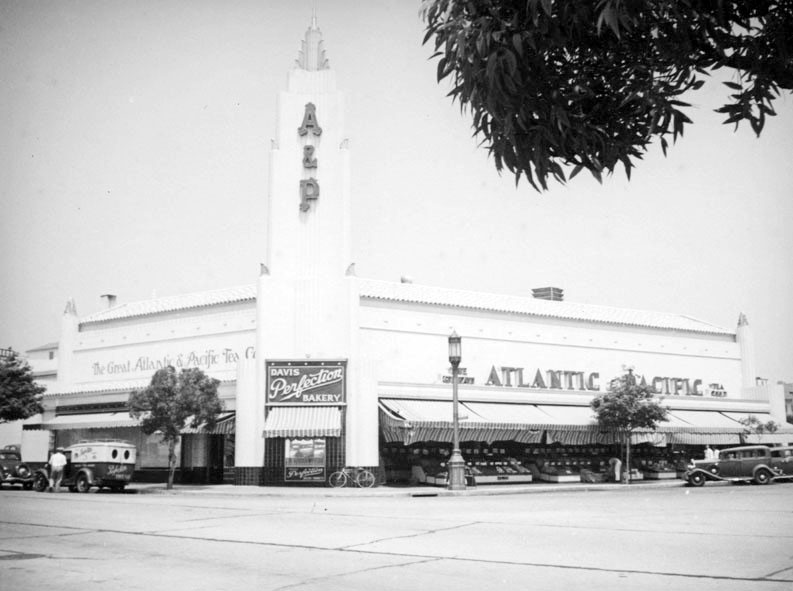 |
|
| (ca. 1937)* – View looking at the northwest corner of Lindbrook Drive and Westwood Boulevard (across the street from Ralphs) showing The Great Atlantic & Pacific Tea Company (A&P). The building above no longer exists. Click HERE for contemporary view. |
Historical Notes The Great Atlantic & Pacific Tea Company, better known as A&P, was a chain of grocery stores that ceased supermarket operations in November 2015, after 156 years in business. From 1915 through 1975, A&P was the largest grocery retailer in the United States (and until 1965, the largest U.S. retailer of any kind). A&P was considered an American icon that according to The Wall Street Journal "was as well-known as McDonald's or Google is today" and that A&P was "Walmart before Walmart." Known for innovation, A&P and the supermarkets that followed its lead significantly improved nutritional habits by making available a vast assortment of food products at much lower costs. Until 1982, A&P also was a large food manufacturer.*^ |
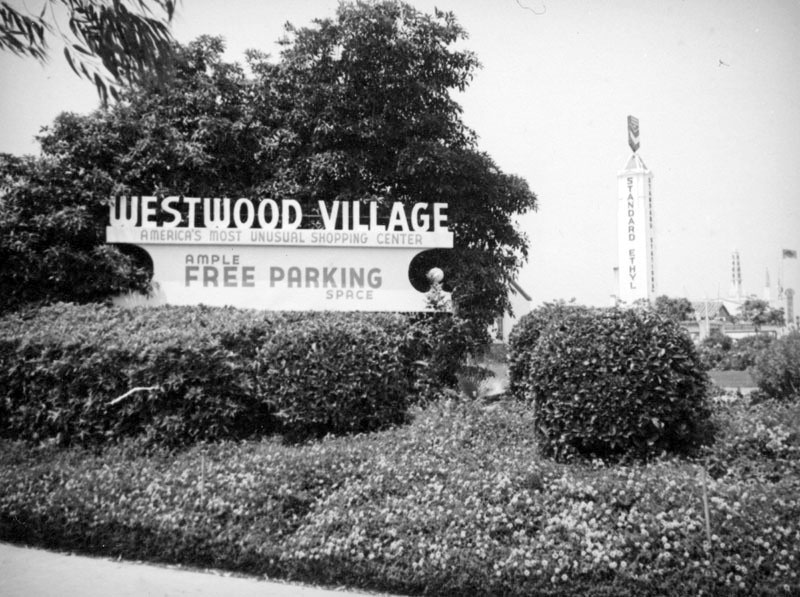 |
|
| (1930s)* - Sign at Westwood Village, "America's Most Unusual Shopping Center," with "Ample Free Parking Space." |
Historical Notes Janss hired Harland Bartholomew, a St. Louis planner, and L. Deming Tilton, involved in the reconstruction of Santa Barbara town center, to develop a master plan for Westwood Village. They chose a Mediterranean-style shopping area with angled streets and irregular blocks. Street corners were anchored by tile-roofed, Spanish Colonial Revival buildings with walk-through plazas and second-floor arcades. Attractions included the Fox Westwood Theatre, department stores such as Bullocks Westwood and Sears, Ralphs grocery, and college shops. Neon-topped towers and a greenbelt along Wilshire drew motorists from the boulevard. |
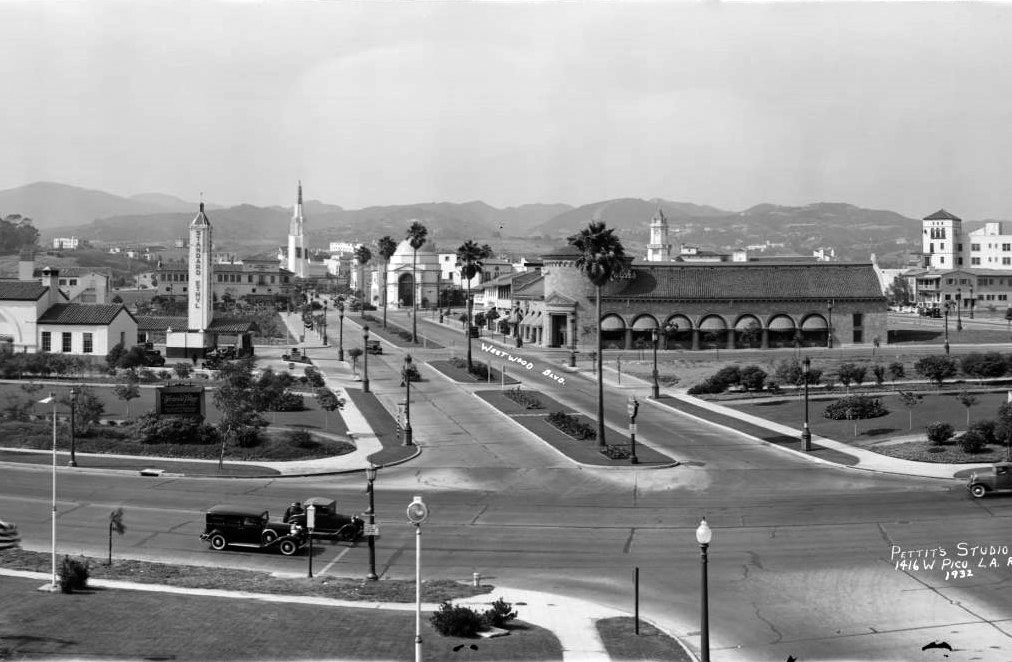 |
|
| (1932)* – View looking north showing the intersection of Wilshire and Westwood boulevards. In the distance can be seen the four major landmarks of Westwood Village. The Fox Theatre, Janss Dome, Ralphs Market and the Holmby Building. Note the absence of any traffic signals at this busy intersection! |
Historical Notes One can see the many towers that served as Village landmarks, including the Fox Theater Tower, Sears Roebuck & Co. Tower, Holmby Hall Clock Tower, and four gas station towers that lined Lindbrook Drive. The towers served to orient pedestrians within the Village, and were intended to catch the eye of motorists as they sped along in the “fast moving traffic” along Wilshire Boulevard.^ |
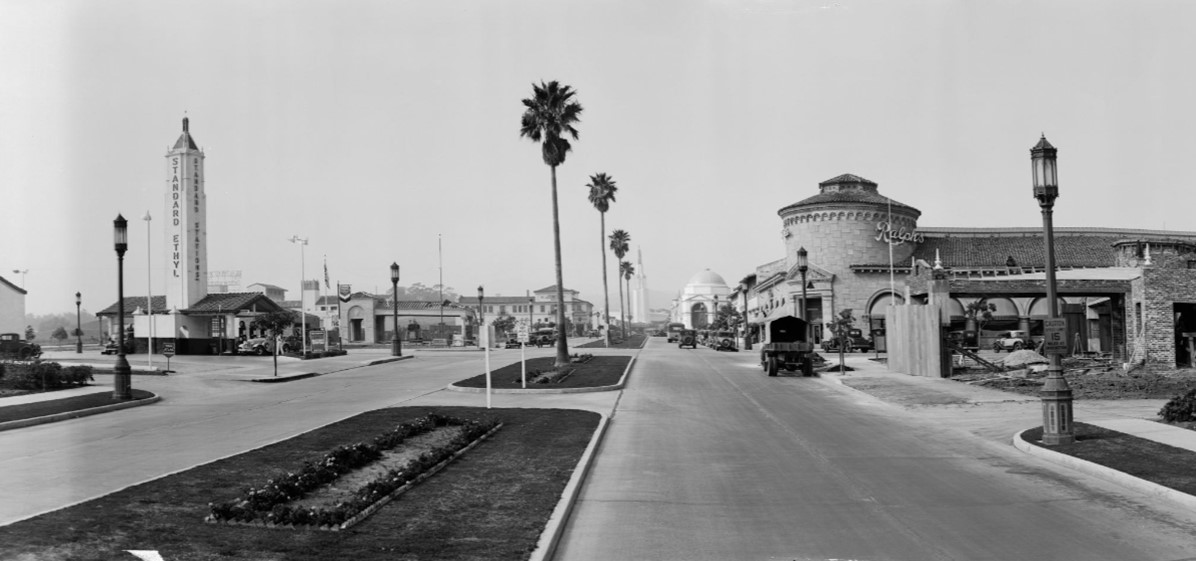 |
|
| (1933)* – View looking northwest along Westwood Blvd. The street, with palm trees planted in the dividers, is lined with a variety of stores, including a Ralphs, and gas stations. In the distance are the dome of the Janss Investment Corp and the tower of the Fox Theatre. |
 |
|
| (1933)* – View looking northwest along Westwood Blvd. The street, with palm trees planted in the dividers, is lined with a variety of stores, including a Ralphs, and gas stations. In the distance are the dome of the Janss Investment Corp and the tower of the Fox Theatre. Image enhancement and colorization by Richard Holoff |
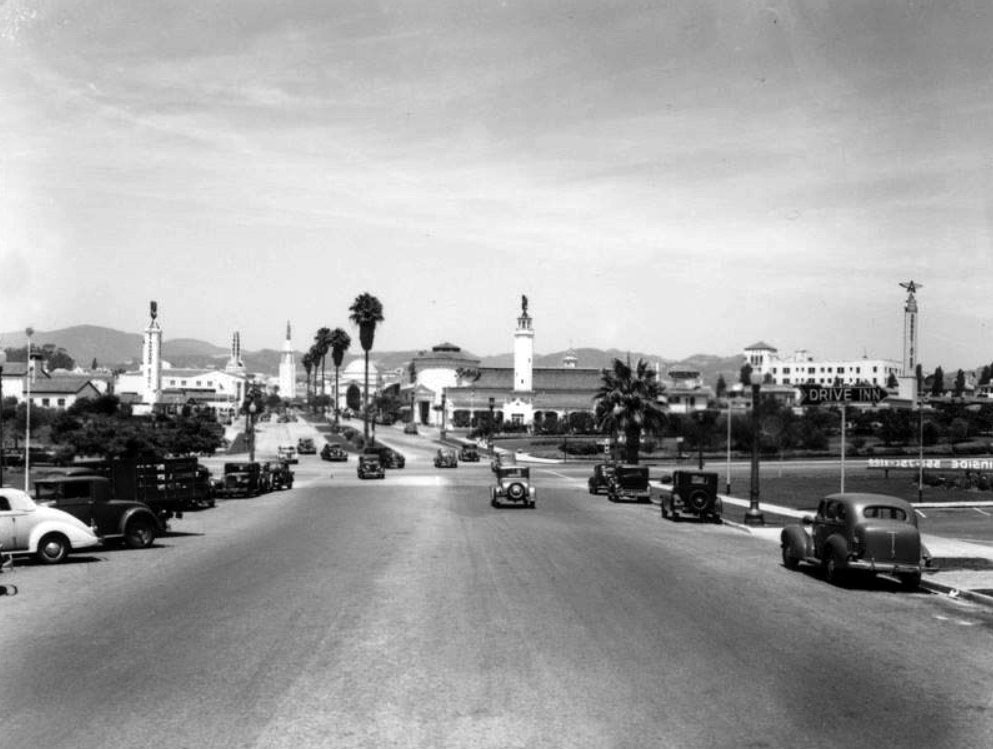 |
|
| (1937)^^* - View looking north on Westwood Boulevard toward the intersection with Wilshire Blvd. |
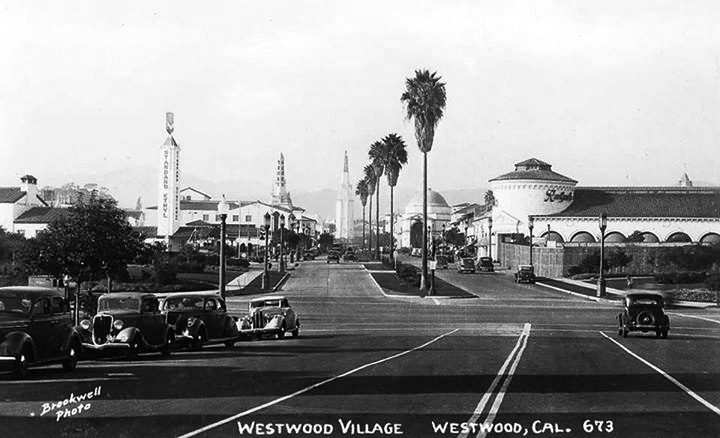 |
|
| (ca. 1937)*^* - Postcard view of Westood Village circa 1937. |
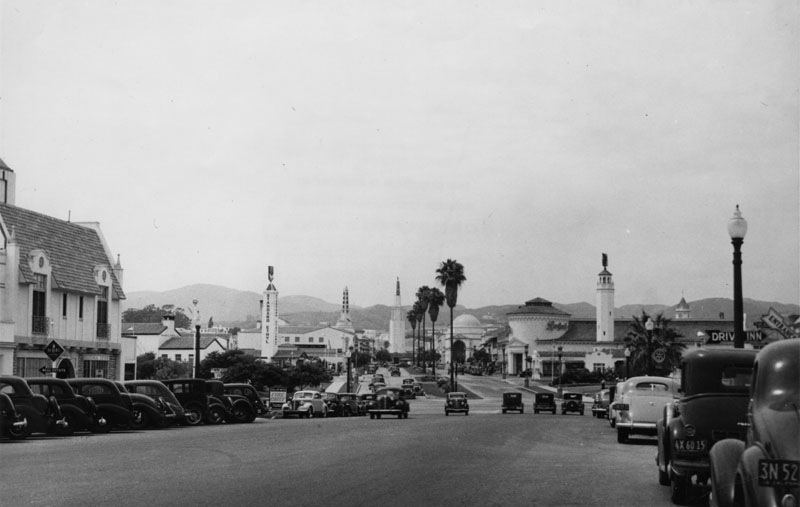 |
|
| (1938)* - Westwood Village, looking north on Westwood Boulevard at Wilshire crossing. |
* * * * * |
Westwood Service Stations
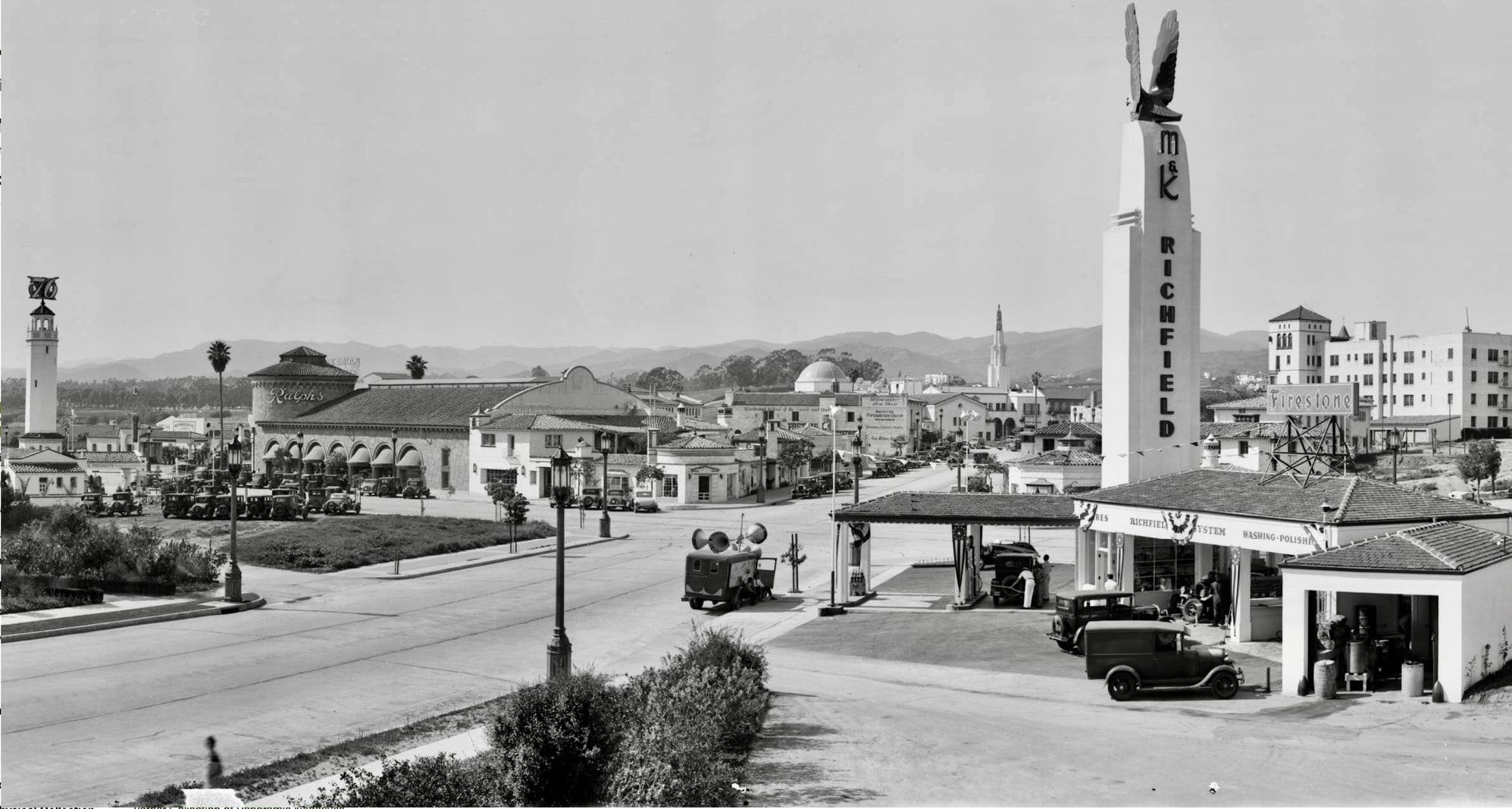 |
|
| (1934)^ – View looking north on Glendon Ave toward Lindbrook Drive showing several tower structures, two of which were for gas stations (Richfield on the right). Ralphs Market is on the left and in the distance can be seen the Janss Dome Building and the Fox Theatre tower. |
Historical Notes The towers in Westwood served to orient pedestrians within the Village, and were intended to catch the eye of motorists as they sped along in the “fast moving traffic” along Wilshire Boulevard.^ |
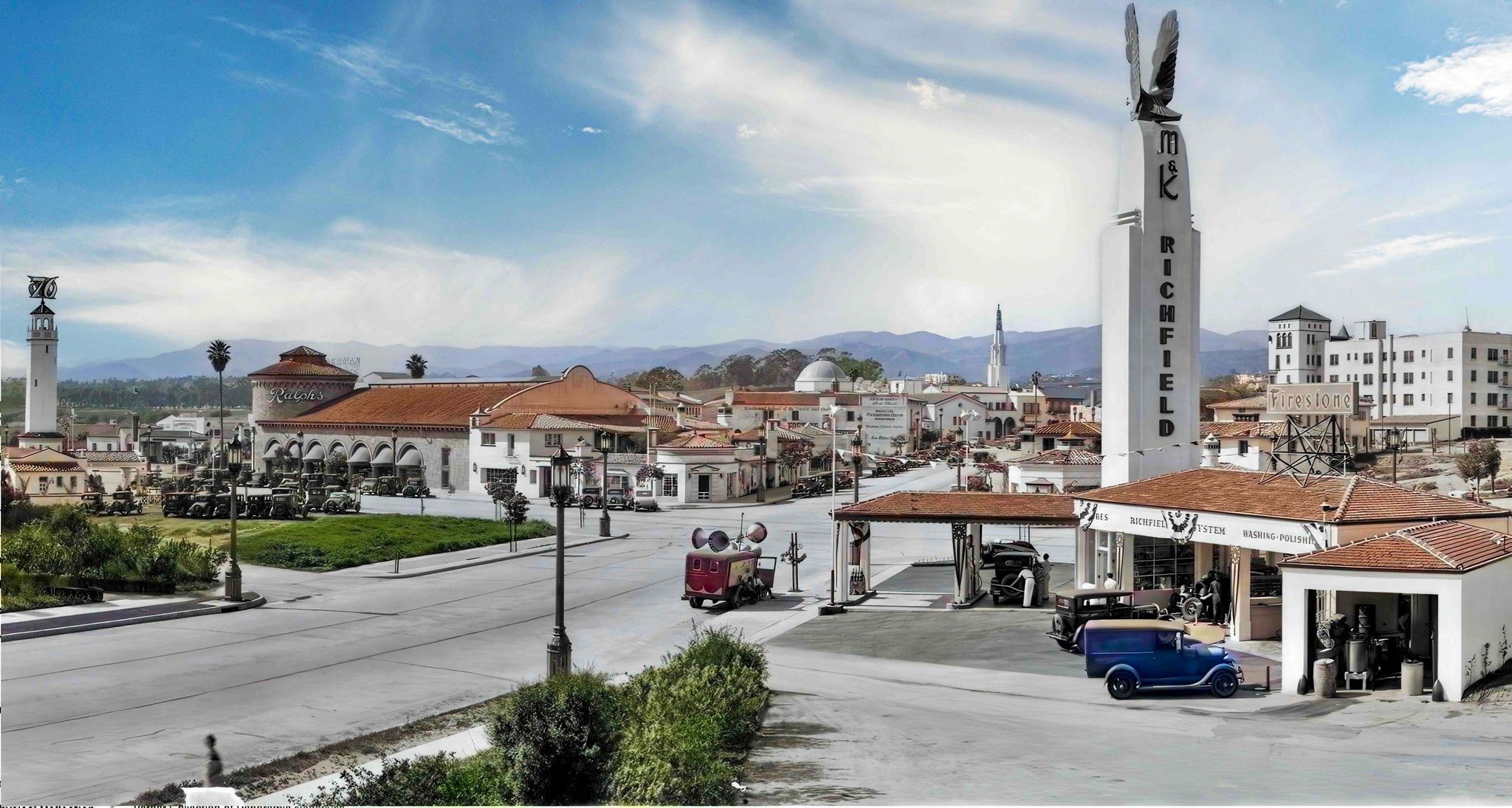 |
|
| (1934)^ – View looking north on Glendon Ave toward Lindbrook Drive showing several tower structures, two of which were for gas stations (Richfield on the right). Ralphs Market is on the left and in the distance can be seen the Janss Dome Building and the Fox Theatre tower. Image enhancement and colorization by Richard Holoff. |
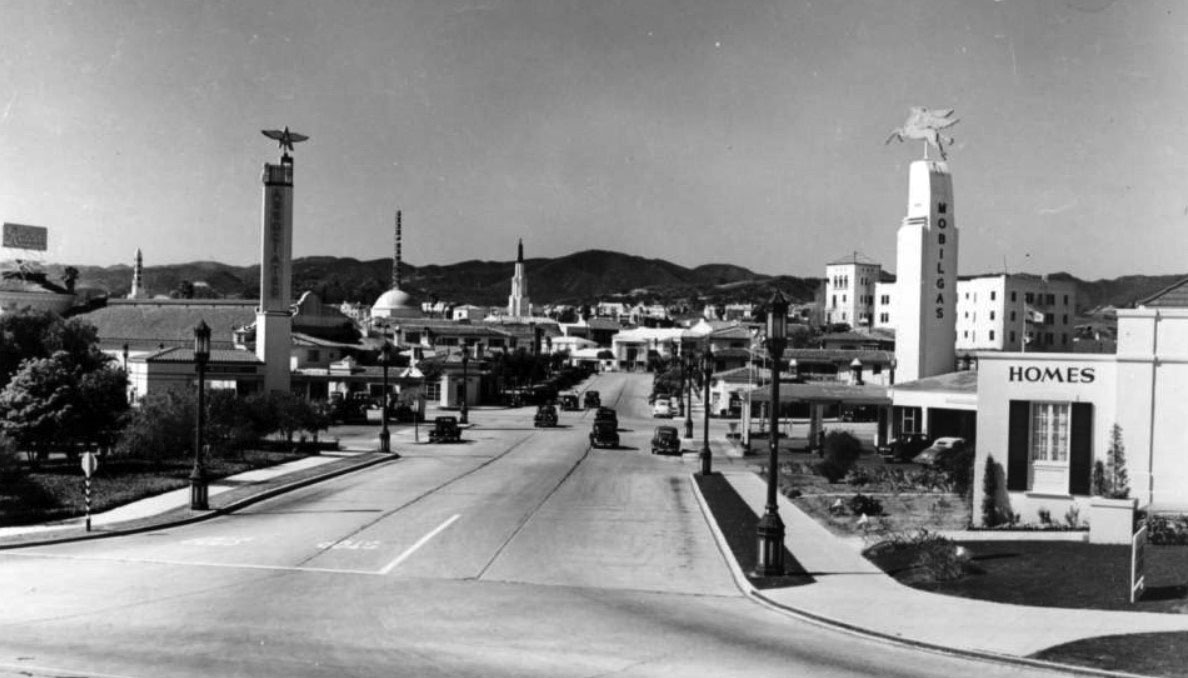 |
|
| (1939)^^ – View looking north on Glendon Ave as seen from Wilshire Blvd. in Westwood. The two closest towers are both for gas stations, Associated and Mobil, located at the intersection of Glendon Ave and Lindbrook Dr. |
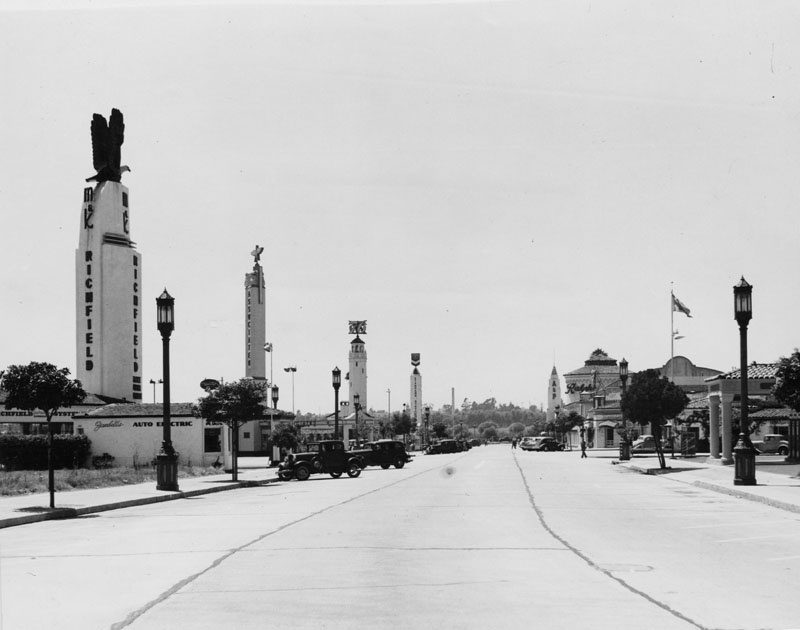 |
|
| (ca. 1937)^ - View of Westwood Boulevard, looking north from Wilshire Blvd. On the left can be seen several gas stations, including a Richfield, Associated, Union 76, and Chevron. On the right are various stores, including a Ralphs Market. |
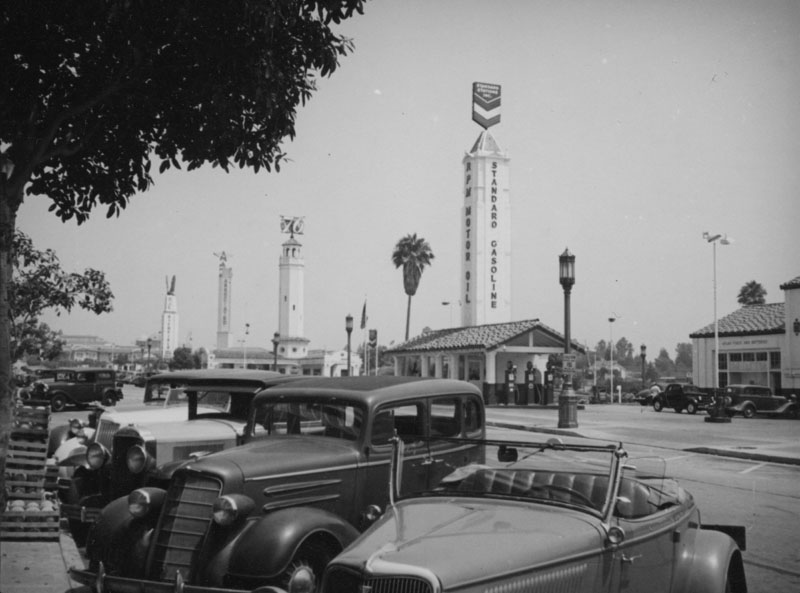 |
|
| (1930s)^ - View of Westwood Village with four tall sign towers in a row, behind the parked cars. Each tower is used to advertise a different gas station, right to left: Standard, 76, Associated, and Richfield. |
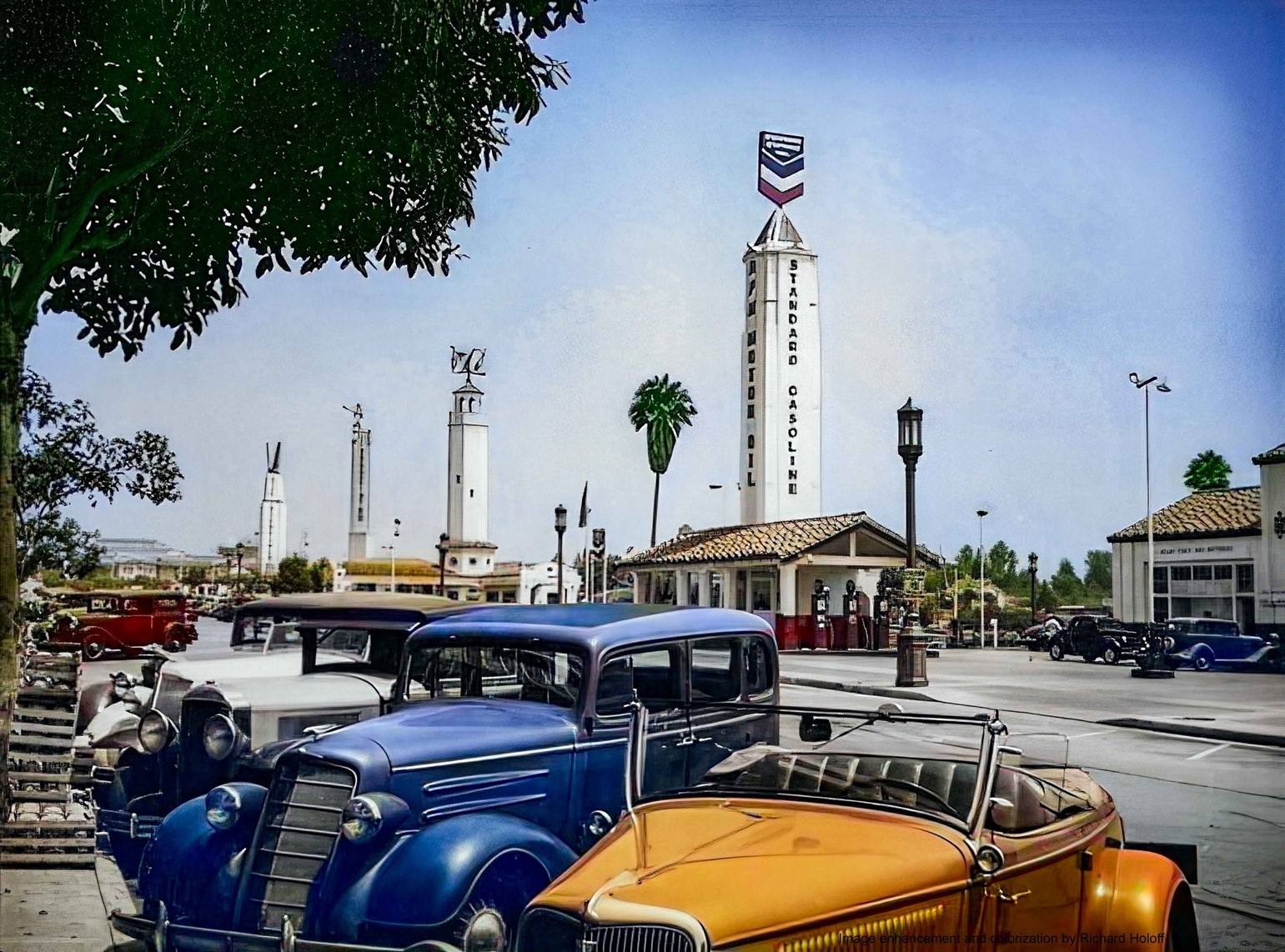 |
|
| (1930s)^ - View of Westwood Village with four tall sign towers in a row, behind the parked cars. Each tower is used to advertise a different gas station, right to left: Standard, 76, Associated, and Richfield. Image enhancement and colorization by Richard Holoff. |
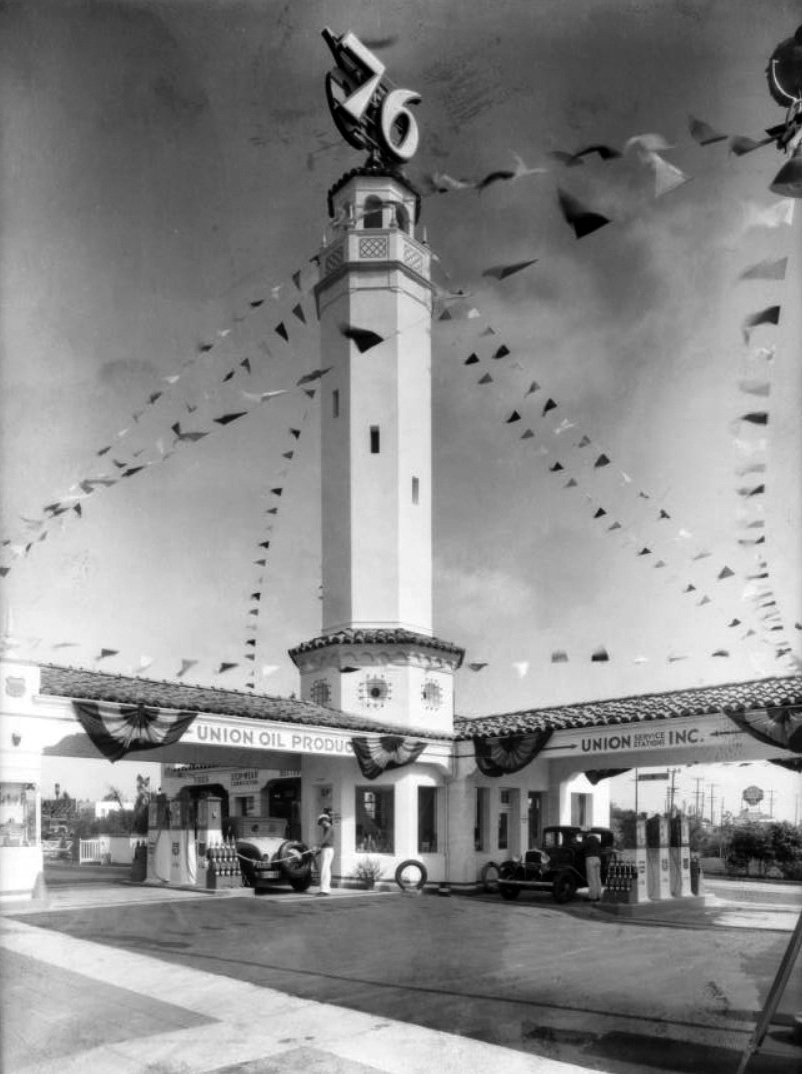 |
|
| (1933)^^ - View showing the grand opening of the Union 76 Service Station located at the southeast corner of Westwood Boulevard and Lindbrook Drive in the Westwood Village. |
Historical Notes This Union 76 Service Station had its grand opening in December 1933 as part of a massive industry opening of 750 stations citywide. The station lasted only until 1936 when it was demolished to make room for Sontag Fountain and Grill, which opened in 1938. |
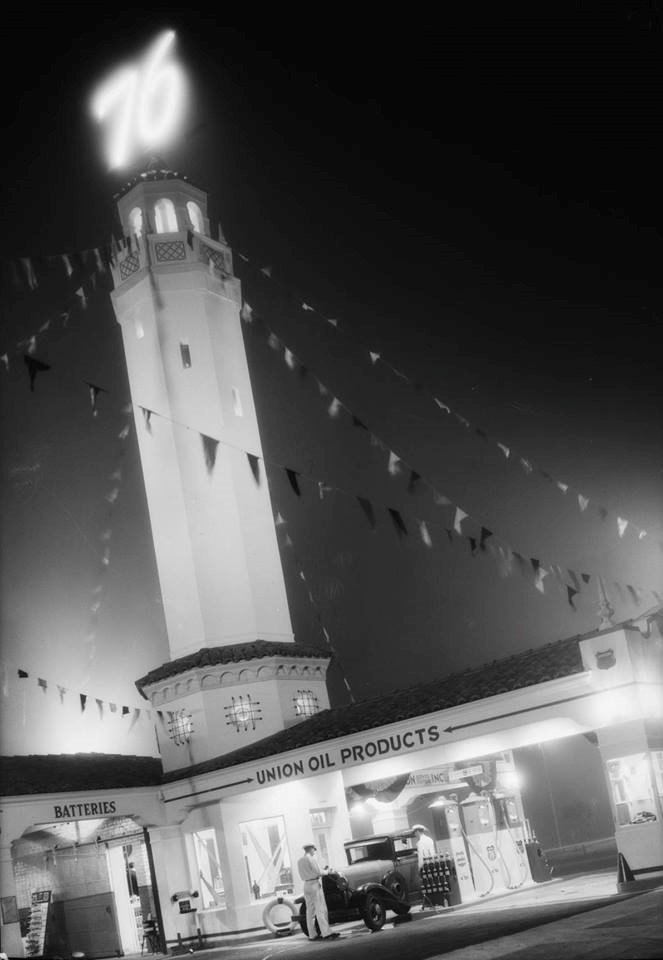 |
|
| (1931)^ – Night view showing the new Union 76 Gas Station on the southeast corner of Westwood Boulevard and Lindbrook Drive. Click HERE to see contemporary view of this same corner. |
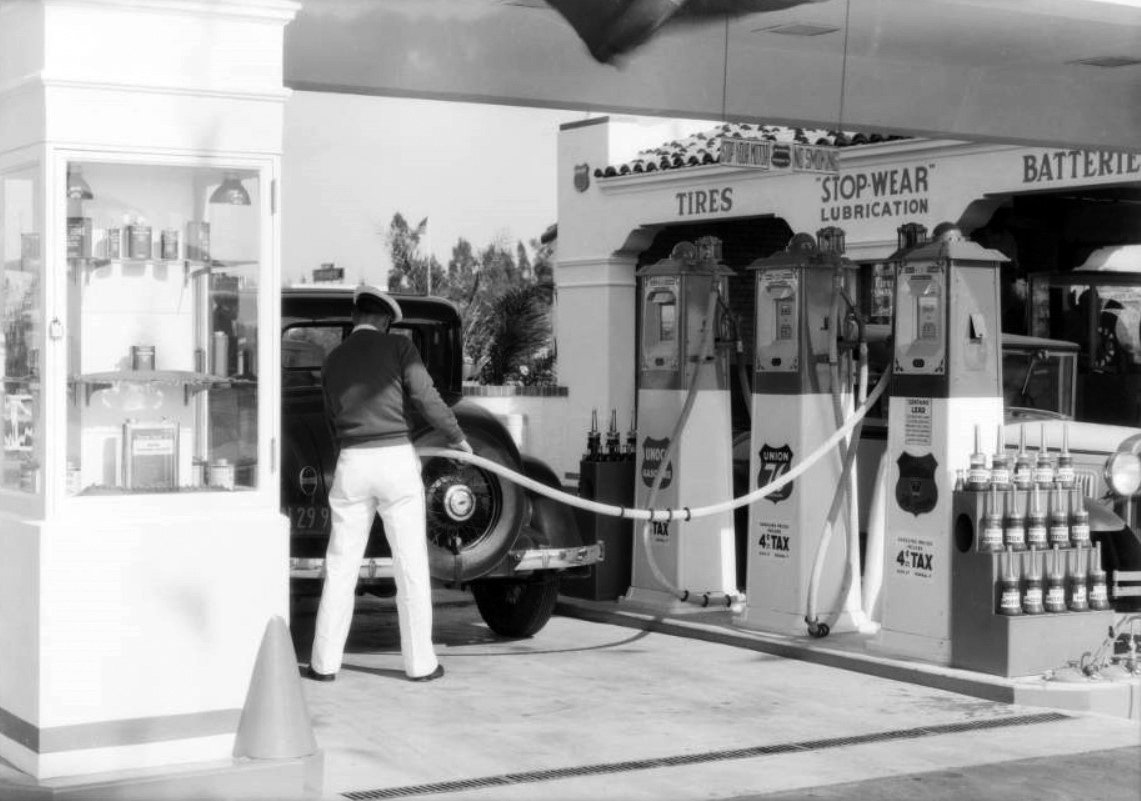 |
|
| (1933)^^ – Close-up view showing an attendant filling up a gas tank at a Union Oil Company Station at 1160 Westwood Boulevard. |
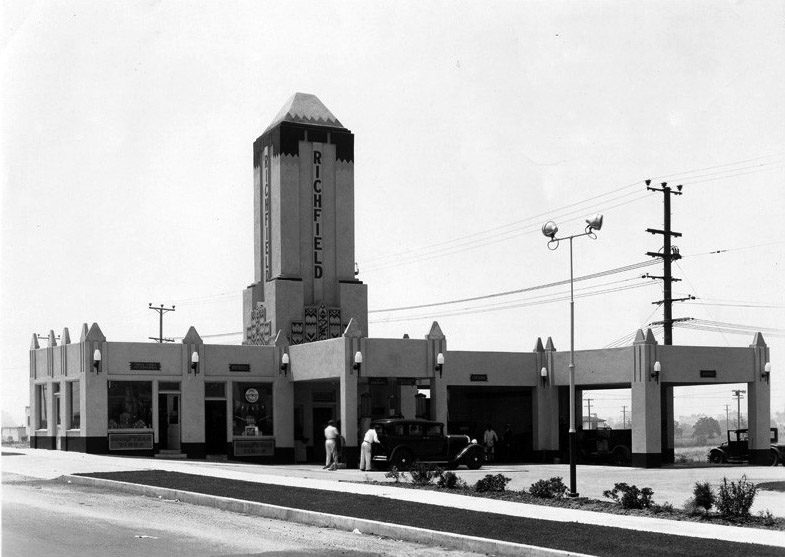 |
|
| (ca. 1933)* – View showing the Richfield Oil Station located at 1215 Westwood Boulevard. |
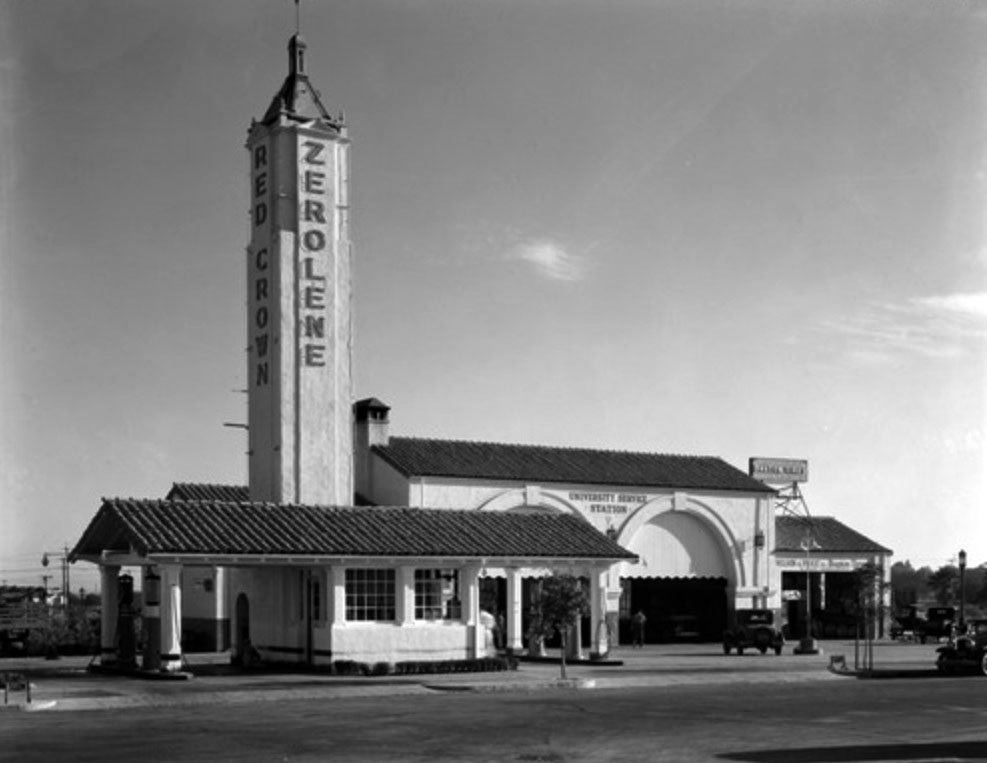 |
|
| (ca. 1933)* – View showing a service station in Westwood Village. Clock tower has "Red Crown Zerolene" on it; other signs read "University Service Station" and "Nelson and Price Inc." |
Click HERE to see more Early LA Gas Stations |
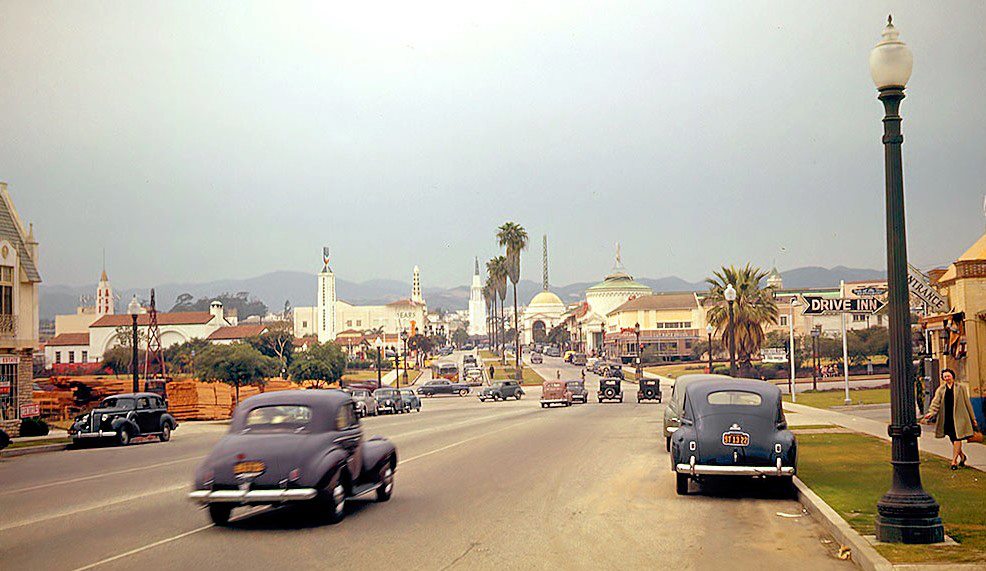 |
|
| (1941)^ - Panoramic view looking north on Westwood Boulevard toward Wilshire Boulevard with Westwood Village seen in the background. |
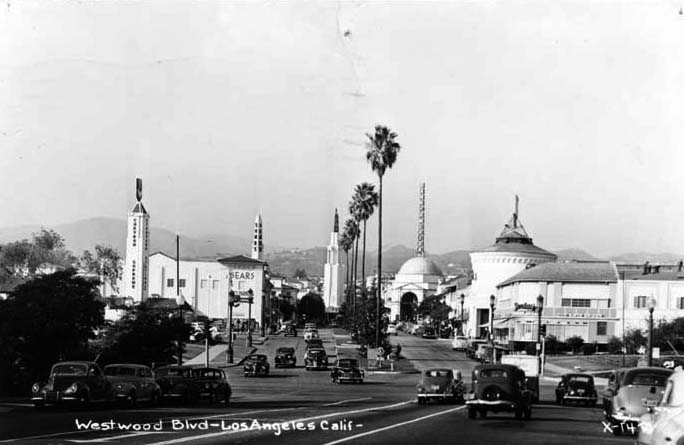 |
|
| (ca. 1940)#^ - Postcard view looking north showing Westwood Village as seen from the intersection of Wilshire and Westwood. |
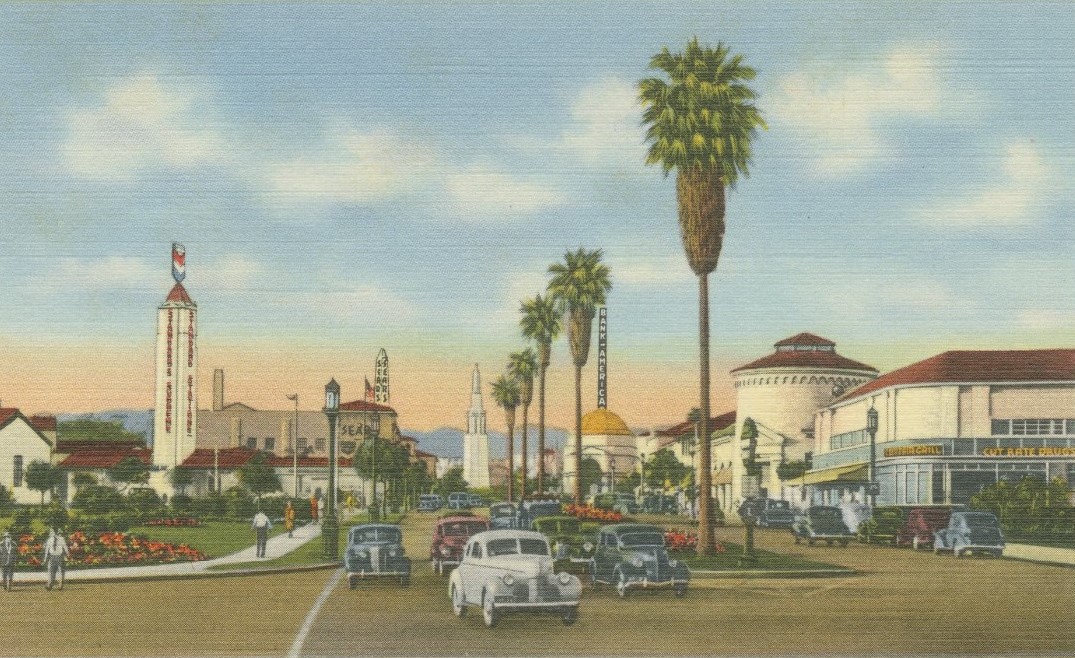 |
|
| (1940)* – Postcard view looking north along Westwood. The meridian is planted with palm trees. Businesses along the street include Cut Rate Drugs, a Standard Supreme (Chevron) gas station, Sears, and the Bank of America. |
Historical Notes Backside of postcard reads: "Westwood Village is ultra-modern, different in every respect, in a land of unusual communities. Smart shops, intimate restaurants, outdoor skating rink and the college atmosphere, all lend to make Westwood one of the most unusual and picturesque of California's newer cities." |
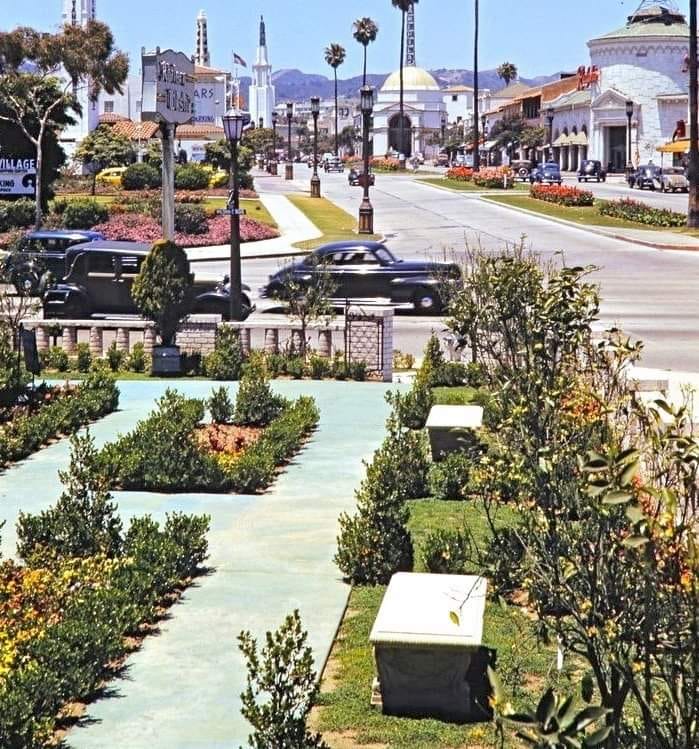 |
|
| (1940s)* – Looking north from the SW corner of Wilshire & Westwood boulevards. |
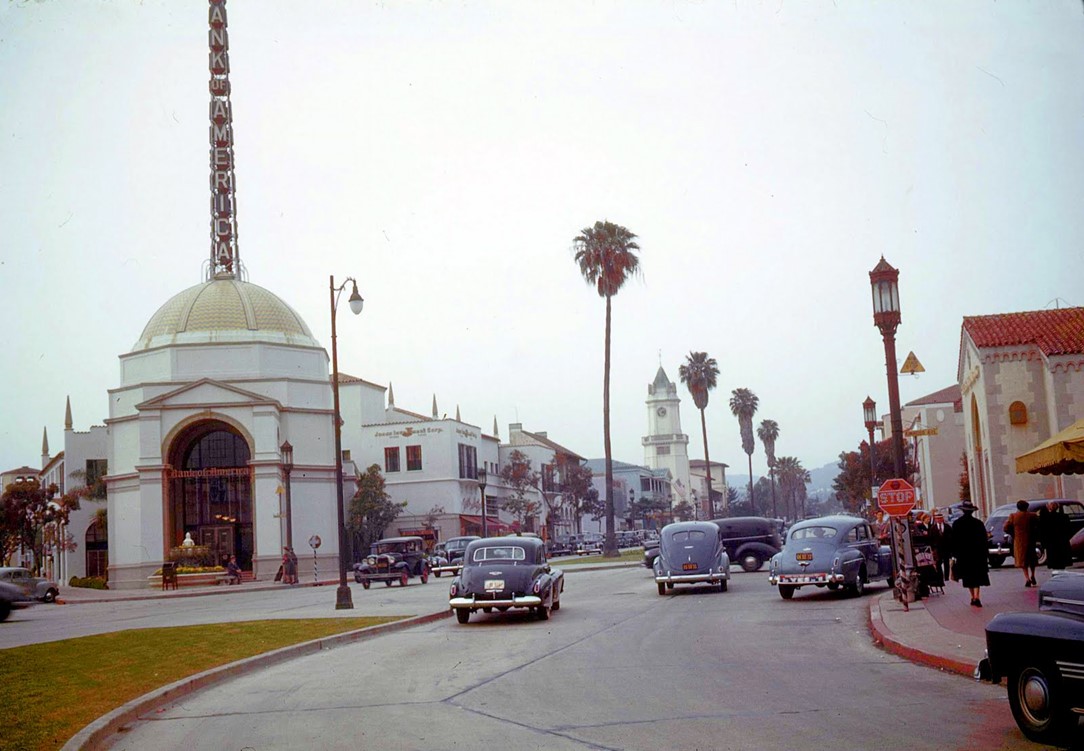 |
|
| (1941)* – View looking northeast on Westwood Boulevard. Bank of America (Janss Dome) is on the left and the Holmby Building with its clock tower can be seen in the distance. |
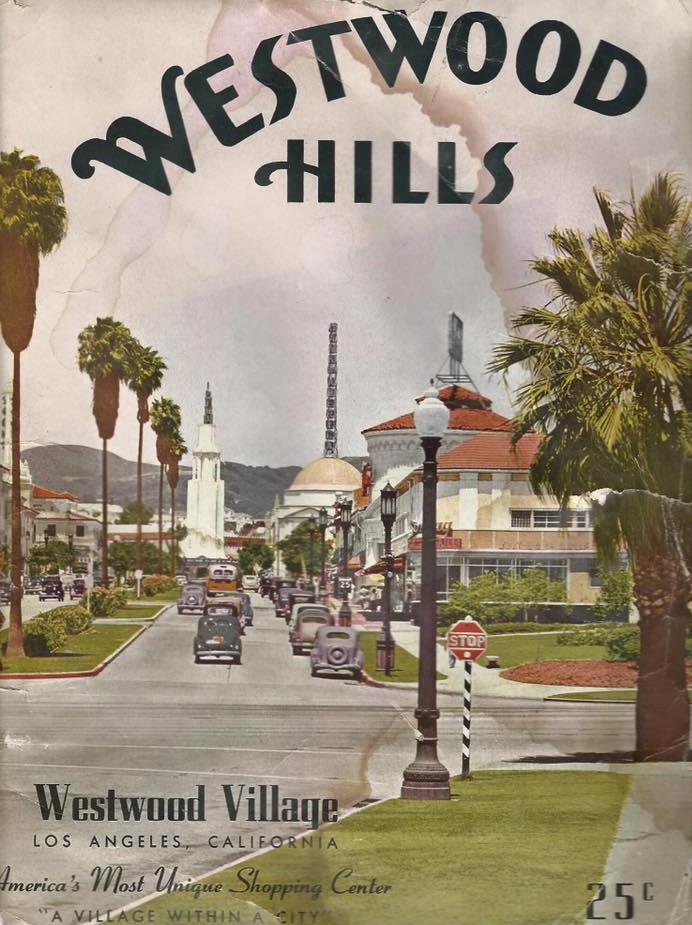 |
|
| (ca. 1940)* – Westwood Hills Magazine cover reads: Westwood Village – America’s Most Unique Shopping Center – “A VILLAGE WITHIN A CITY”. Photo: Vintage Los Angeles. |
Historical Notes Westwood Hills Magazine was published by Westwood Hills News Publishing from 1937-1941 and ran as a weekly magazine and cost 25 cents! |
.jpg) |
|
| (1940s)* – View looking NE on Westwood Boulevard showing how tall the palm trees have grown in the center median. The large building on the right was the original Bullock's Westwood. |
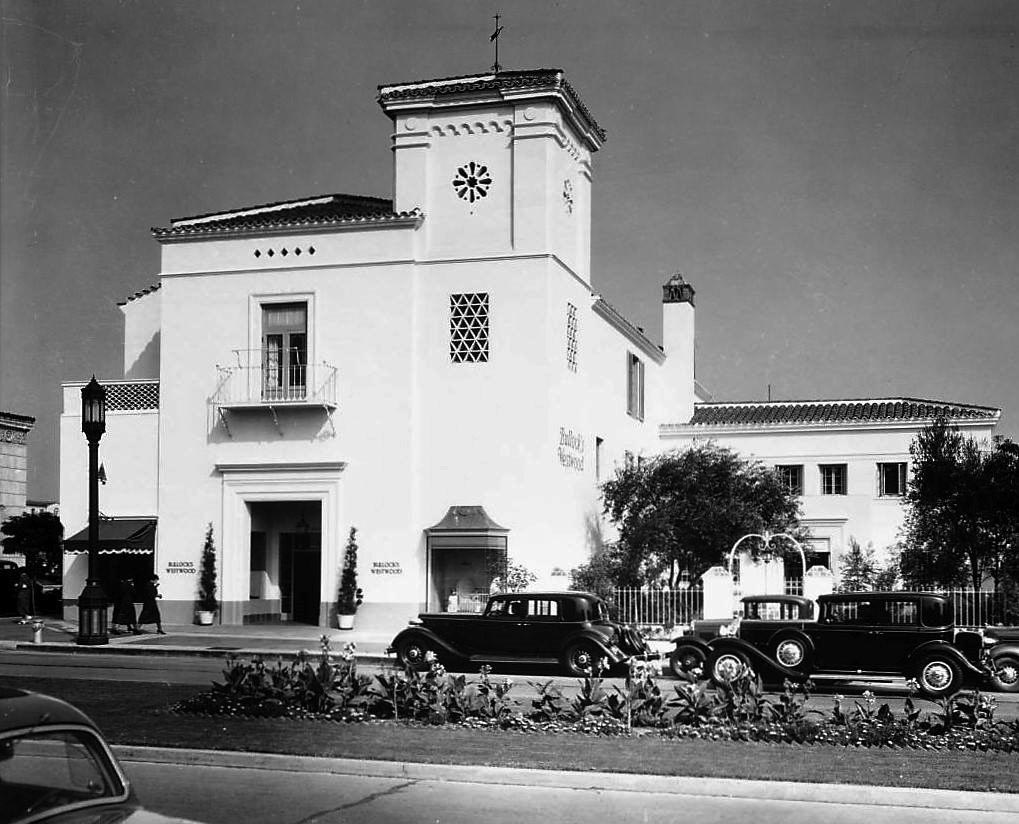 |
|
| (1936)^^ – View of Bullock’s Department Store in Westwood Village, located on the east side of Westwood Boulevard diagonally across the intersection from the Holmby Building. |
Historical Notes The original Bullock's store in Westwood was of Spanish style architecture and served the community from 1932 until 1951. |
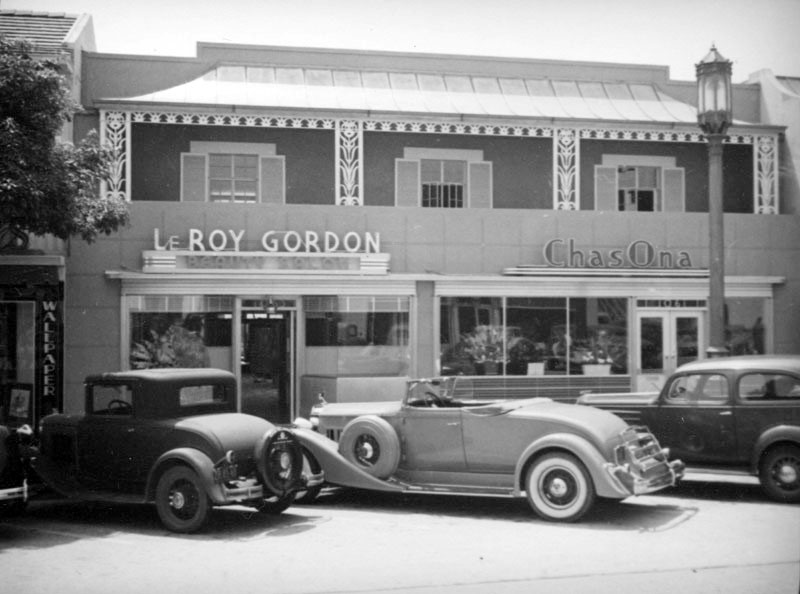 |
|
| (ca. 1937)* - Two shops in Westwood Village: LeRoy Gordon and Chas. Ona, with cars parked in front. The streetlamp on the right was called the "Westwood Special". |
Historical Notes Being adjacent to the University of California at Los Angeles (UCLA), Westwood Village was decorated in the early part of the century with the Westwood Special, notable for the blue and gold ceramic tile around its base. These were replaced with modern lights in the early 1960's when Westwood Village determined to become the brightest lighted commercial area in the world using 1,000-watt mercury vapor lamps. |
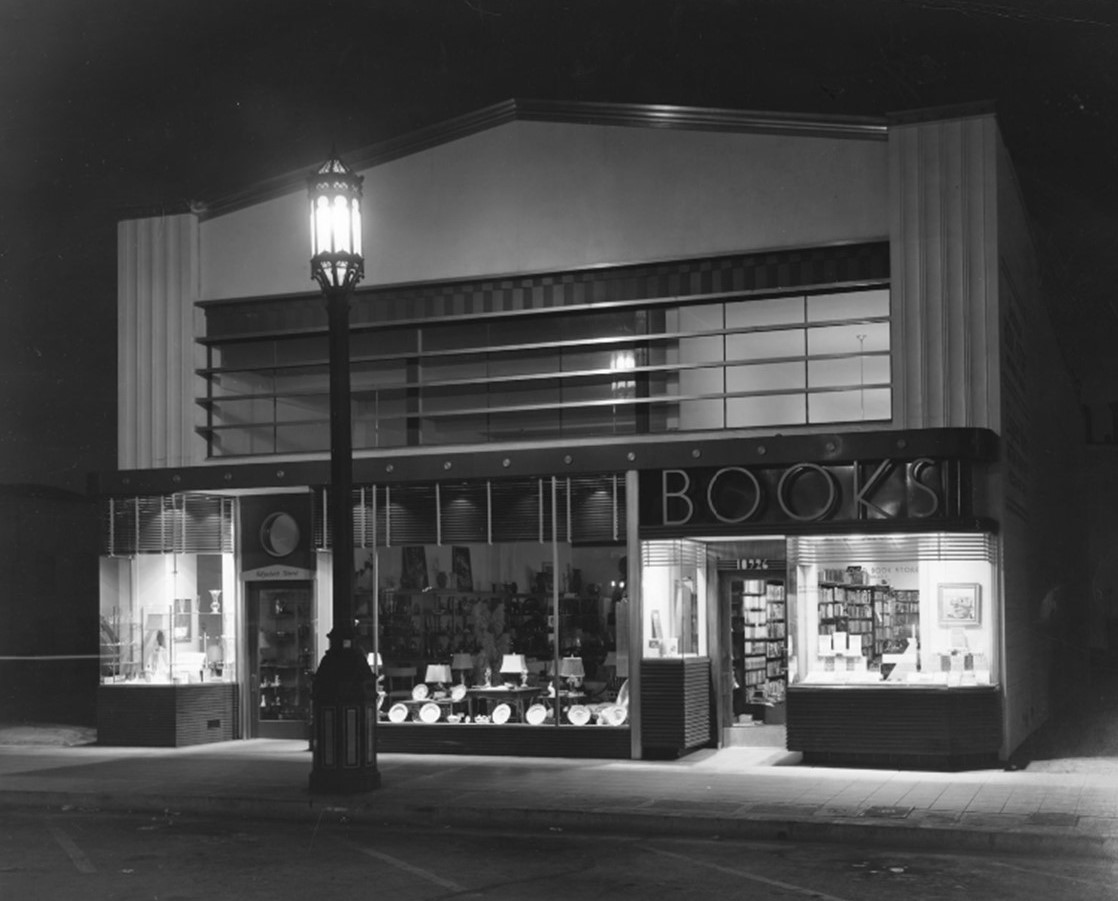 |
|
| (1938)* – View showing an art deco style building located at 10926 Weyburn Avenue in Westwood Village. On the left is a lamp shop with plates and lamps in the display window. Next door, on the right, is the Westwood Bookstore which is still open late at night. A "Westwood Special" streetlight illuminates the building. |
Myer Siegel (Westwood)
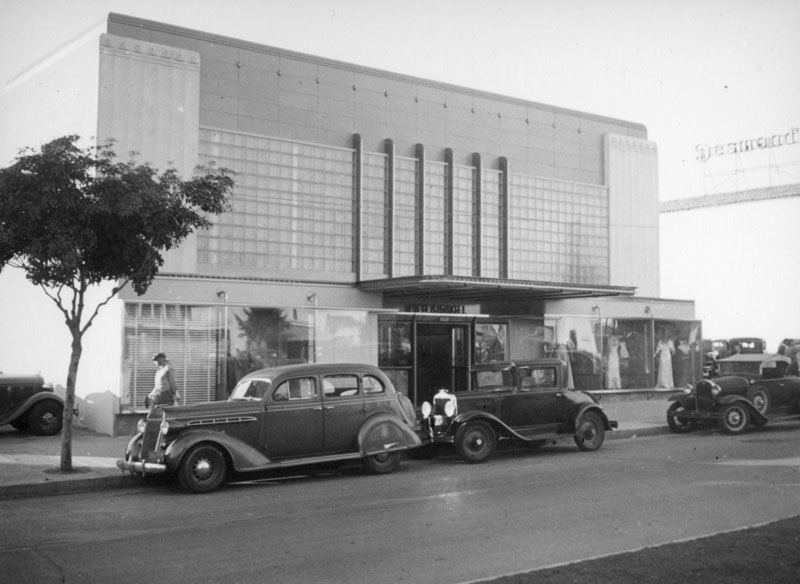 |
|
| (1937)* - View of the newly opened Myer Siegel and Company Store at 1025 Westwood Boulevard. The store opened just in time for Christmas. Photo by Herman Schuleis |
Historical Notes In 1886, Myer Siegel opened his first store at Second and Main in Los Angeles. Designed by architect Allen G. Siple, the Westwood Village store opened in December 1937 and was the fifth store in the chain following Downtown, Pasadena, Wilshire and Beverly Hills. These stores offered better women’s apparel.* |
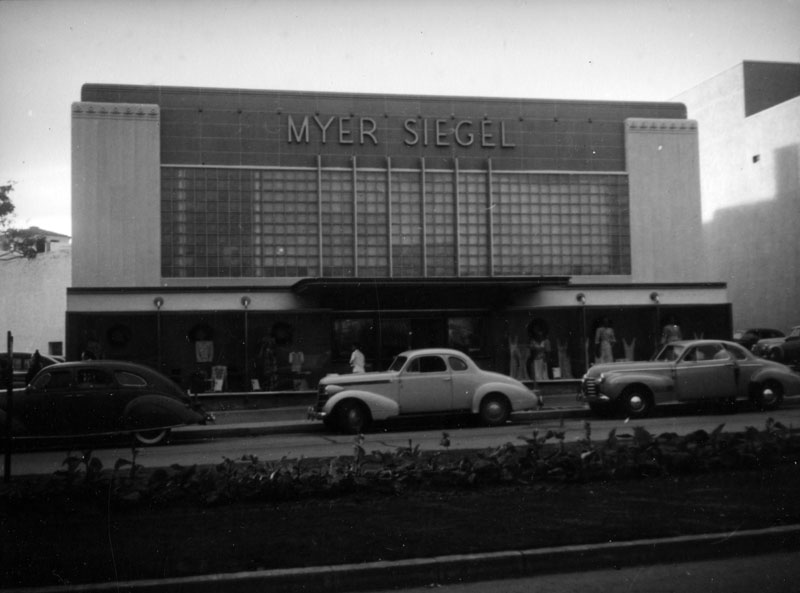 |
|
| (1940s)* - Front view of the Myer Siegel Department Store on Westwood Boulevard. Several late model automobiles are parked along the street. Photo by Herman Schulteis |
Historical Notes The large glass brick panel above the marquee allowed light to enter the mezzanine, and marble wainscoting flanked the entrance which was paved in travertine. The company closed in the late 1950's but the building is still standing today.* |
Then and Now
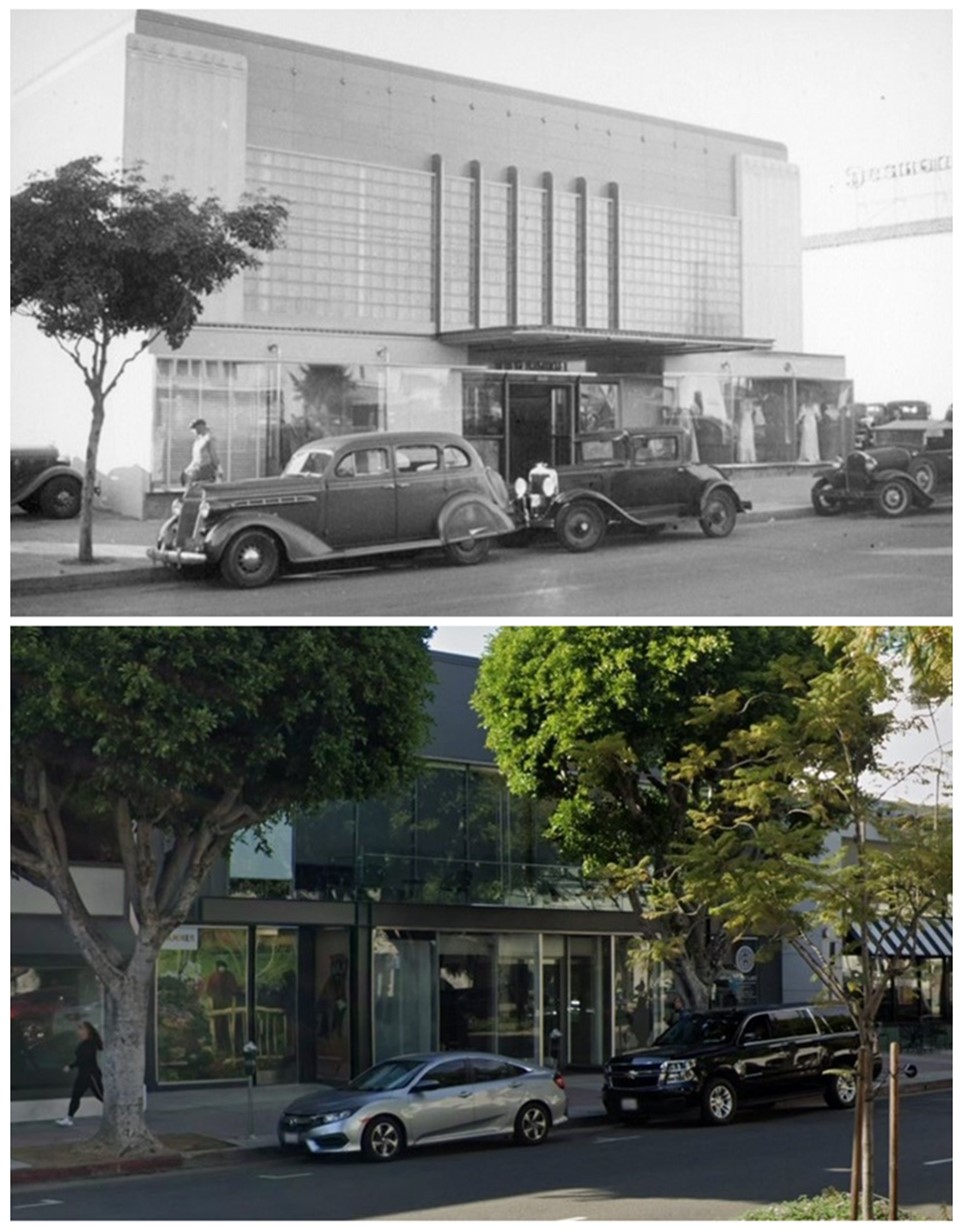 |
|
| (1937 vs 2023)* - Myer Siegel Dept Store Building located 1025 Westwood Boulevard, today occupied by the Float Lab. The one tree on the left appears to be the same. |
.jpg) |
|
| (1940s)^.^ – View looking at Ralphs Market on the corner of Westwood Boulevard and Lindbrook Drive. |
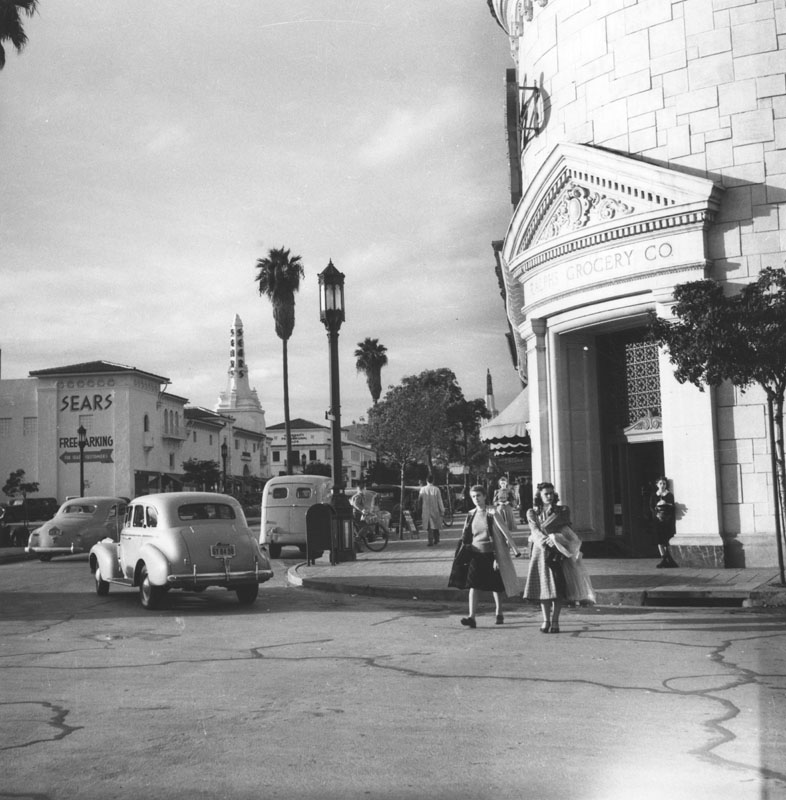 |
|
| (ca. 1940s)* - Two women are seen walking down Lindbrook Drive (foreground) where it meets Westwood Boulevard (left) right outside of a Ralphs supermarket in Westwood Village. Designed by architect Russell Collins and built in 1929, the market is identified by the words "Ralphs Grocery Co.," seen over the doorway. Various businesses, including Sears, are visible in the background, |
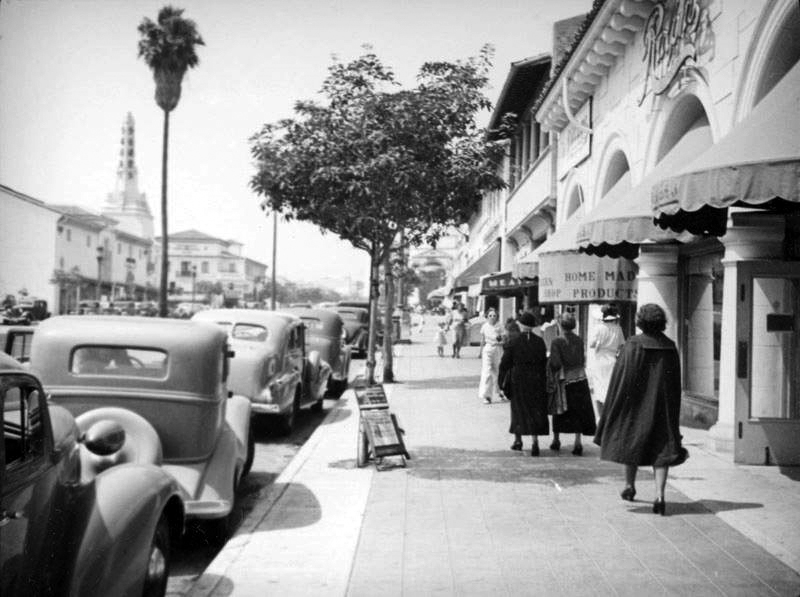 |
|
| (1940s)*#* – View looking north showing shoppers walking by the Westwood Boulevard shops with Ralphs Market on the right. |
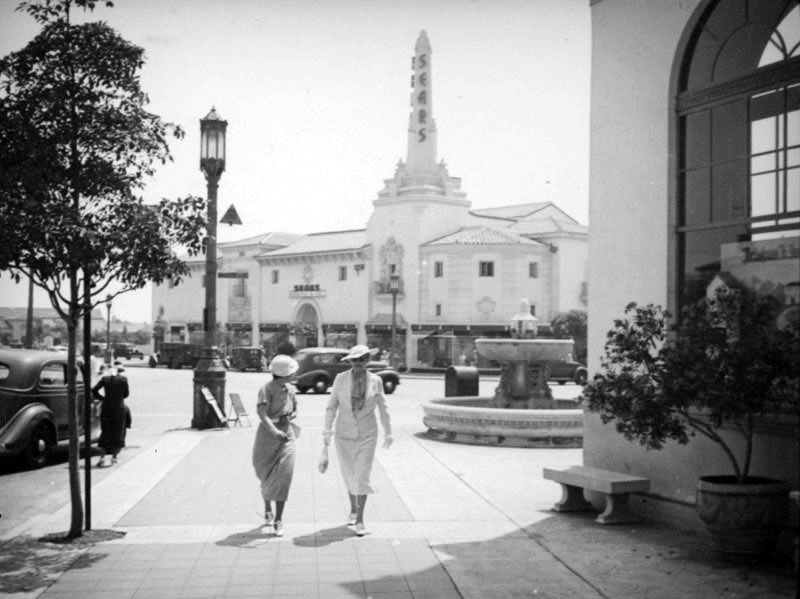 |
|
| (ca. 1940s)* - Women walking down the street adjacent to the Janss Dome located at 1045 Westwood Blvd. Behind them can be seen a large fountain and the Sears store across the street. |
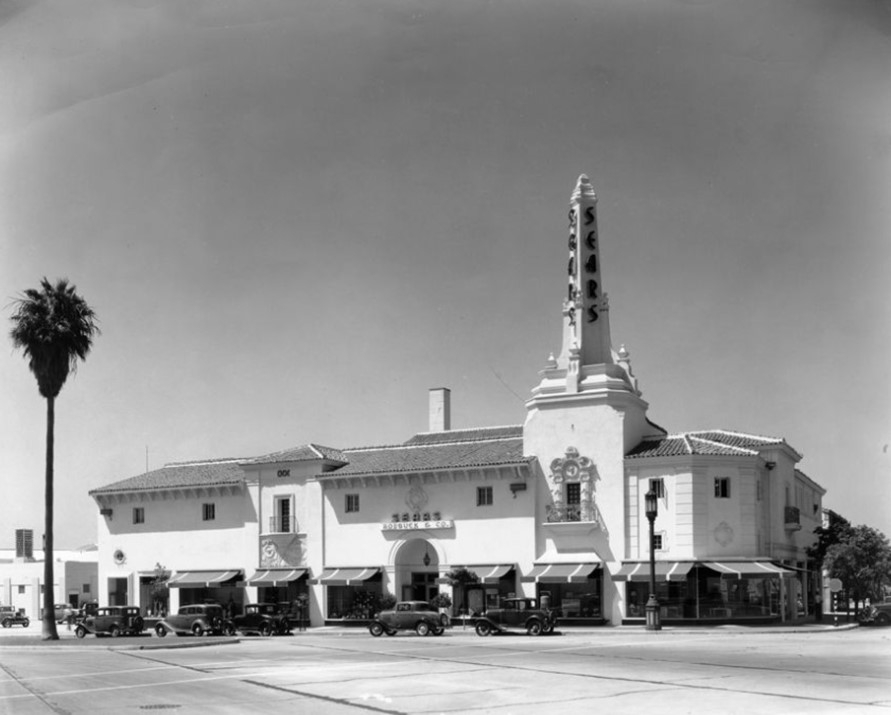 |
|
| (ca. 1936)* – View showing cars parked in front of the Sears store in Westwood at the corner of Westwood and Kinross. |
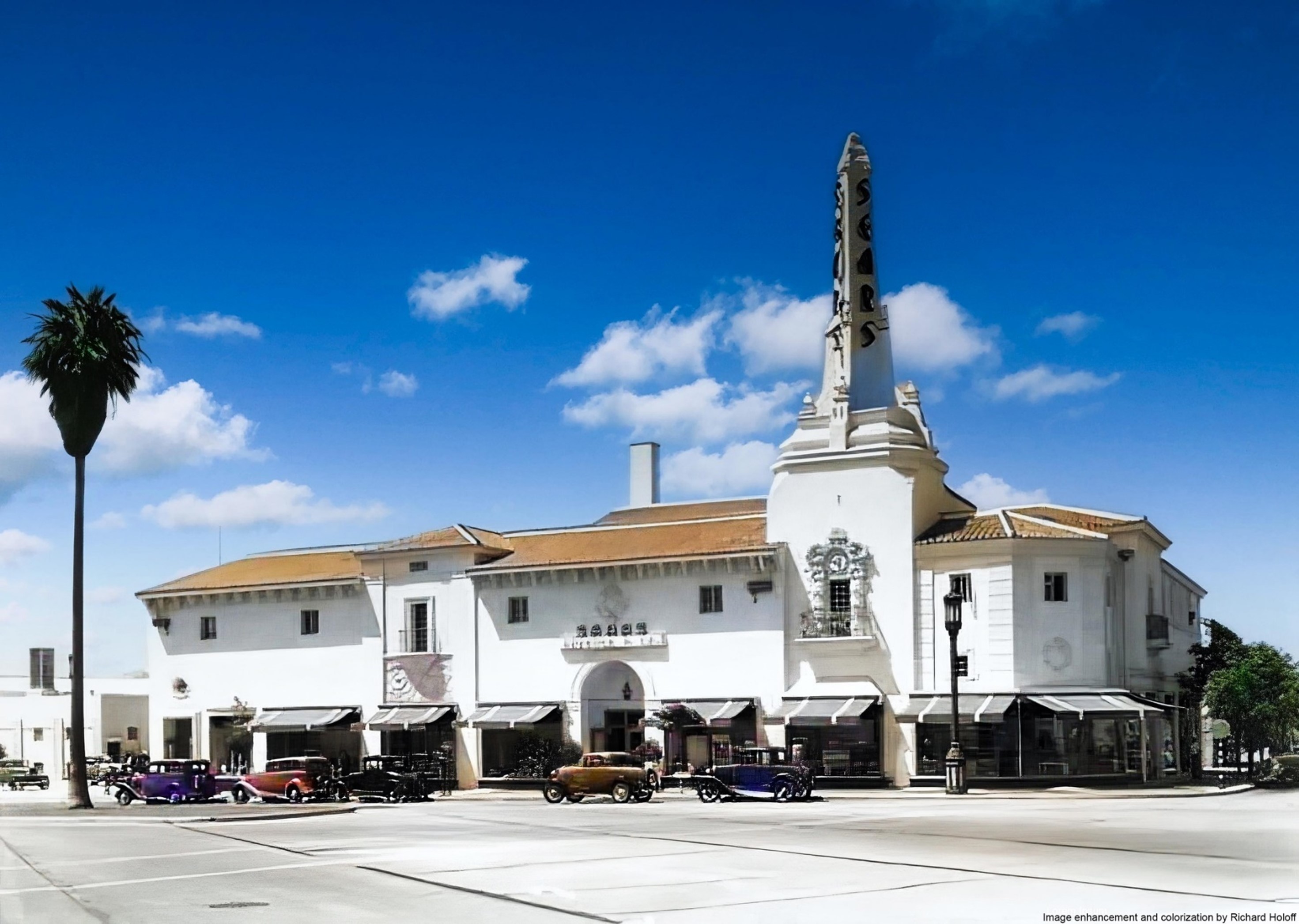 |
|
| (ca. 1936)* – View showing cars parked in front of the Sears store in Westwood at the corner of Westwood and Kinross. Image enhancement and colorization by Richard Holoff. |
Tropical Ice Gardens
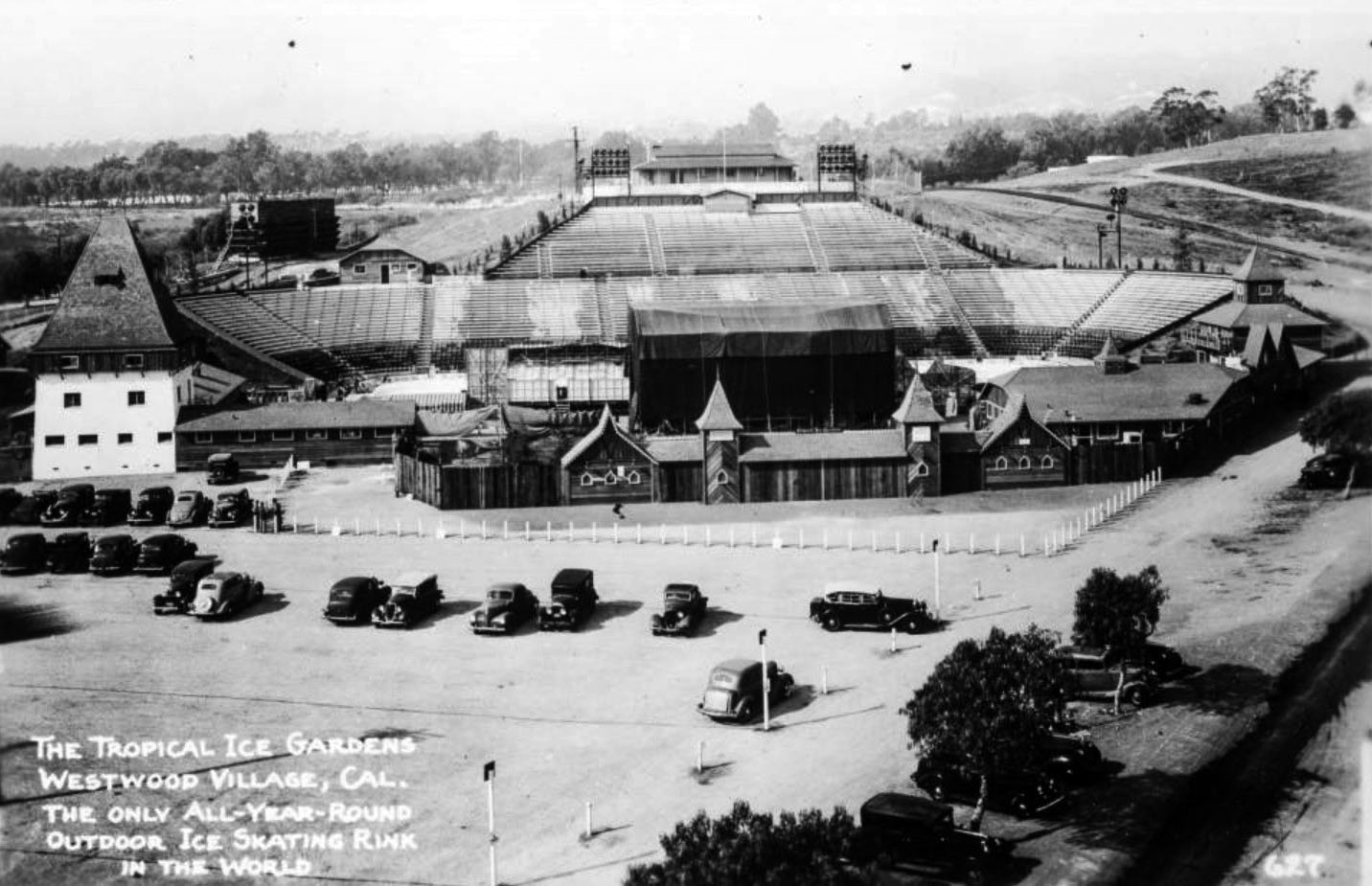 |
|
| (1938)* – Postcard view looking west showing the Tropical Ice Gardens ice skating rink, which opened in 1938 at the corner of Gayley Avenue and Weyburn Avenue in Westwood. Writing on photo reads: “The Tropical Ice Gardens, Westwood Village. The Only All-Year-Round Outdoor Ice Skating Rink in the World”. |
Historical Notes The Tropical Ice Gardens opened in November 1938 at the corner of Gayley Avenue and Weyburn Avenue in Westwood Village, near the UCLA campus. It was billed as the "world's first year-round, outdoor ice skating rink" and aimed to recreate an Alpine village setting despite Los Angeles' warm climate. The facility occupied 21,000 square feet and could accommodate around 2,000 skaters and 12,000 spectators in the stands. |
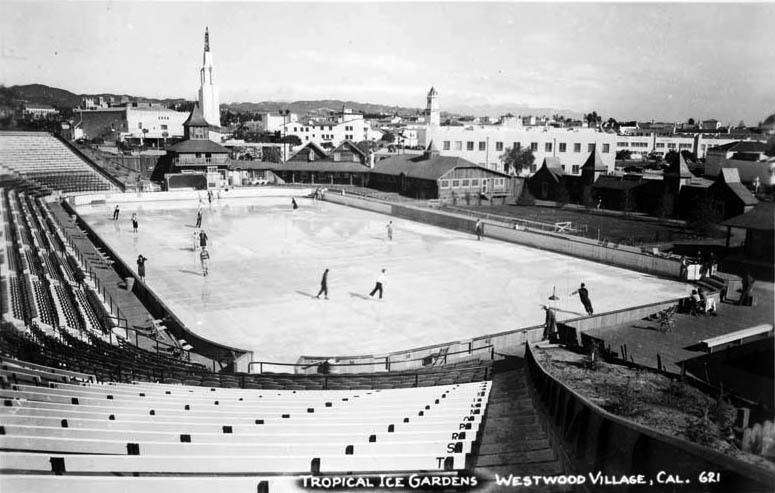 |
|
| (ca. 1939)* - Postcard view of the Tropical Ice Gardens in Westwood Village. The Fox Theater Tower can be seen in the background. |
Historical Notes UCLA's ice hockey team, formed in 1926, played its home games at Tropical Ice Gardens and had a rivalry with USC. The Tropical Ice Gardens also hosted hockey games, ice dancing shows, comedy and animal ice shows, as well as skating clubs. In 1945 the Tropical Ice Garden merged with the Mercury Figure Skating Club to become the All-Year Mercury AFC. |
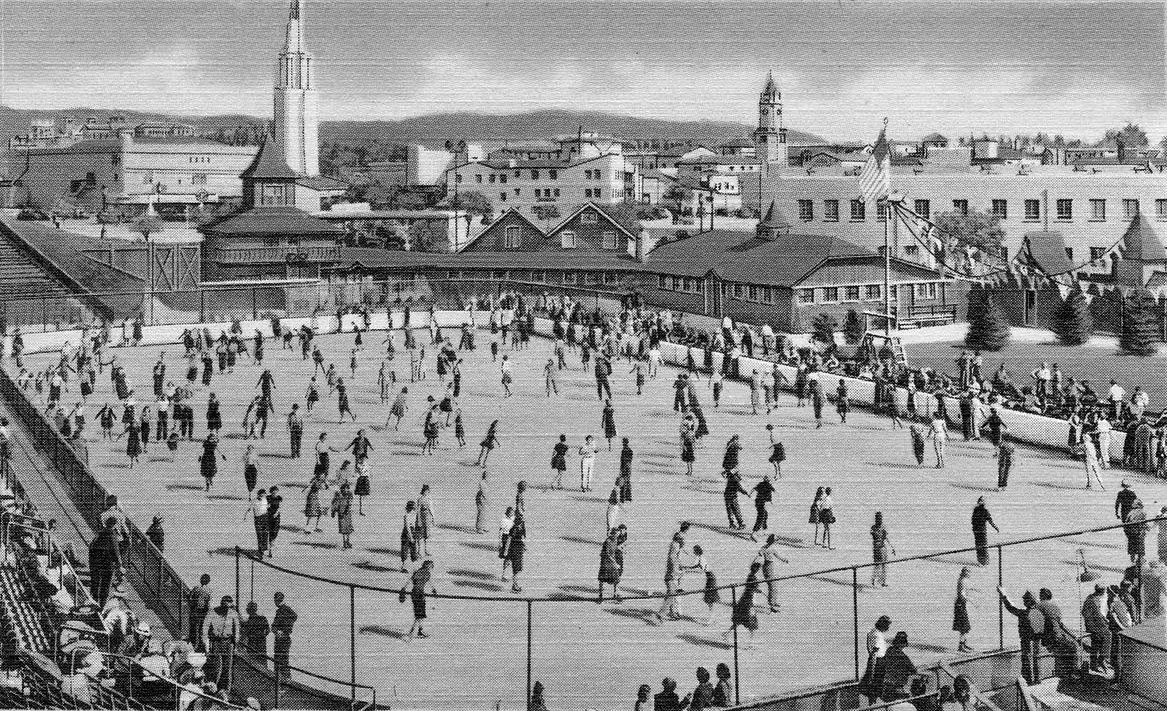 |
|
| (1930s)* – Postcard image showing a full house at the year-round Westwood Village ice skating rink. |
Historical Notes The massive outdoor rink measured 21,000 square feet and used refrigeration technology to maintain the ice year-round. |
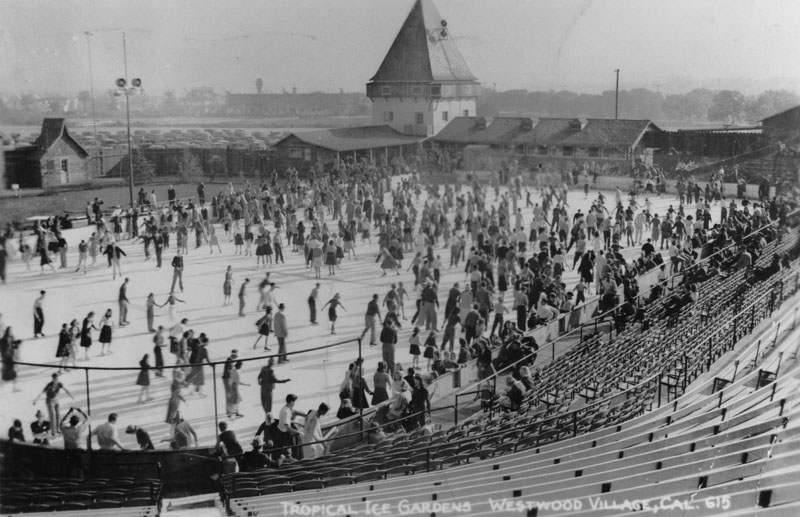 |
|
| (1939)* - Postcard photo of Tropical Ice Gardens looking southeast, showing an almost filled-to-capacity ice rink. |
Historical Notes The rink became known as the "Sonja Henie Ice Palace" after the famous Norwegian Olympic figure skater's films were shot there in the 1940s. |
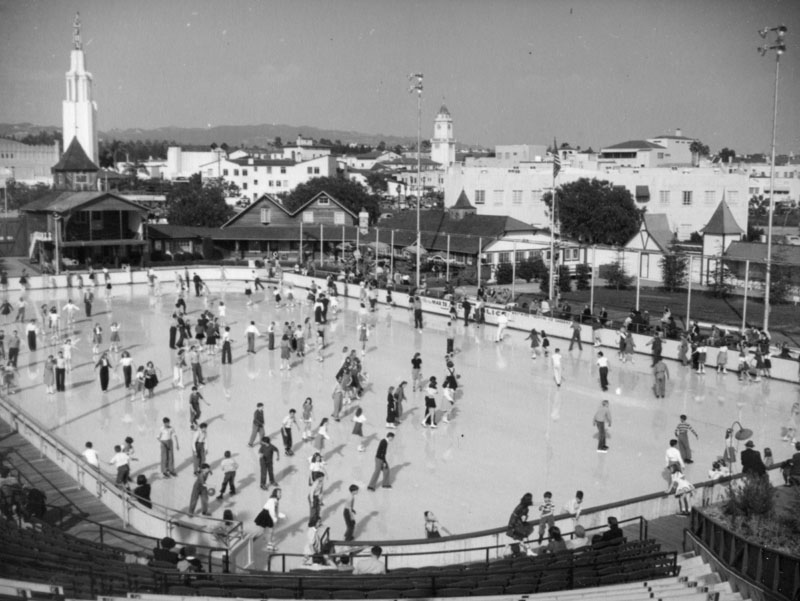 |
|
| (ca. 1940s)* - View from high up in the bleachers, where large crowds can be seen enjoying the large outdoor ice skating rink at Tropical Ice Gardens, located in Westwood Village. The towers of both the Holmby Building and the Fox Westwood Village Theatre can be seen in the background. |
Historical Notes Tropical Ice Gardens appeared in so many films starring Norwegian Olympic champion Sonja Henie that people referred to it as her rink, though she never actually owned it. By 1949 the Tropical Ice Gardens was called the Sonja Henie Ice Palace. |
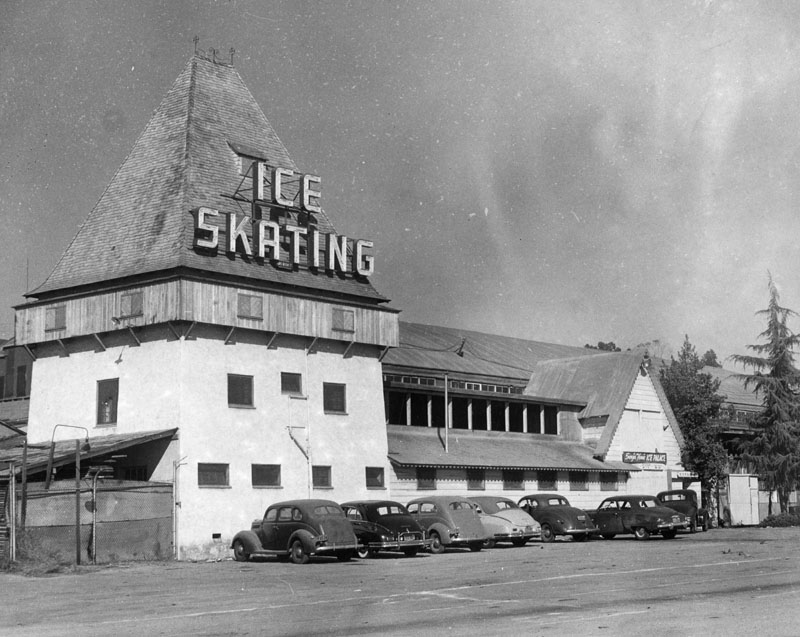 |
|
| (1949)* - View showing the Alpine-style buildings and parking lot of the Tropical Ice Gardens in Westwood Village. A line of early model cars are parked in front of the building. |
Historical Notes The rink closed in 1949 to make way for UCLA's westward expansion of its campus into Westwood Village. |
* * * * * |
Fox Theatre (aka Fox Westwood Village Theatre)
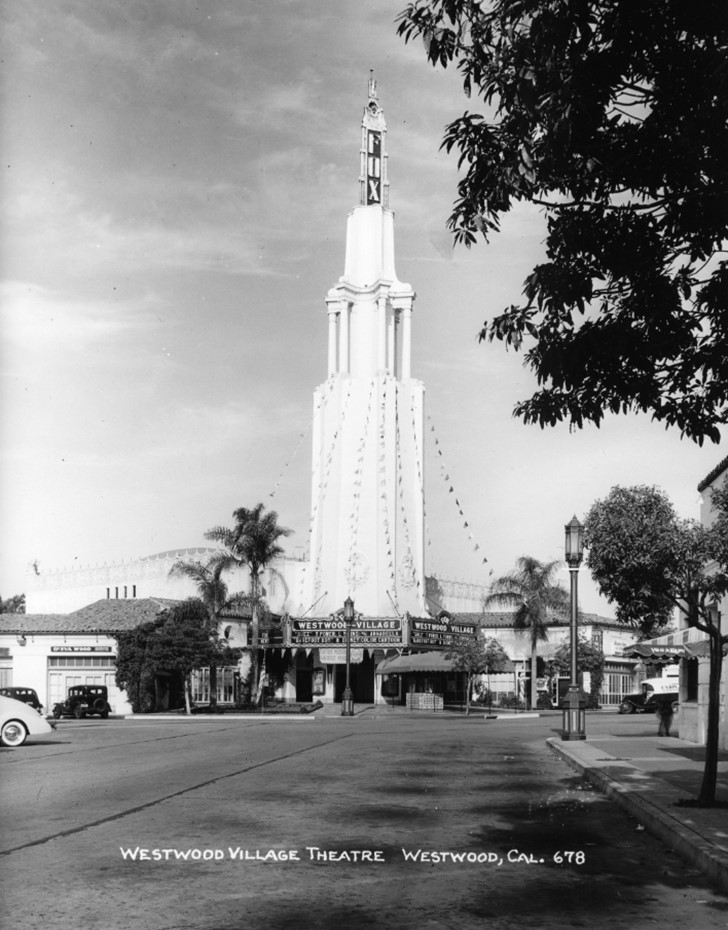 |
|
| (1938)* – Postcard view looking northwest on Broxton Avenue showing the Fox Westwood Village Theater. |
Historical Notes Opened on August 14, 1931, “The Fox” as it was known for decades, was the first motion picture theater and the first entertainment facility built in Westwood Village. Its soaring 17-story tower, capped by a three-sided spire in blazing blue-and-gold neon sign that says “FOX,” has been a dominant Westwood landmark for more than 80 years. |
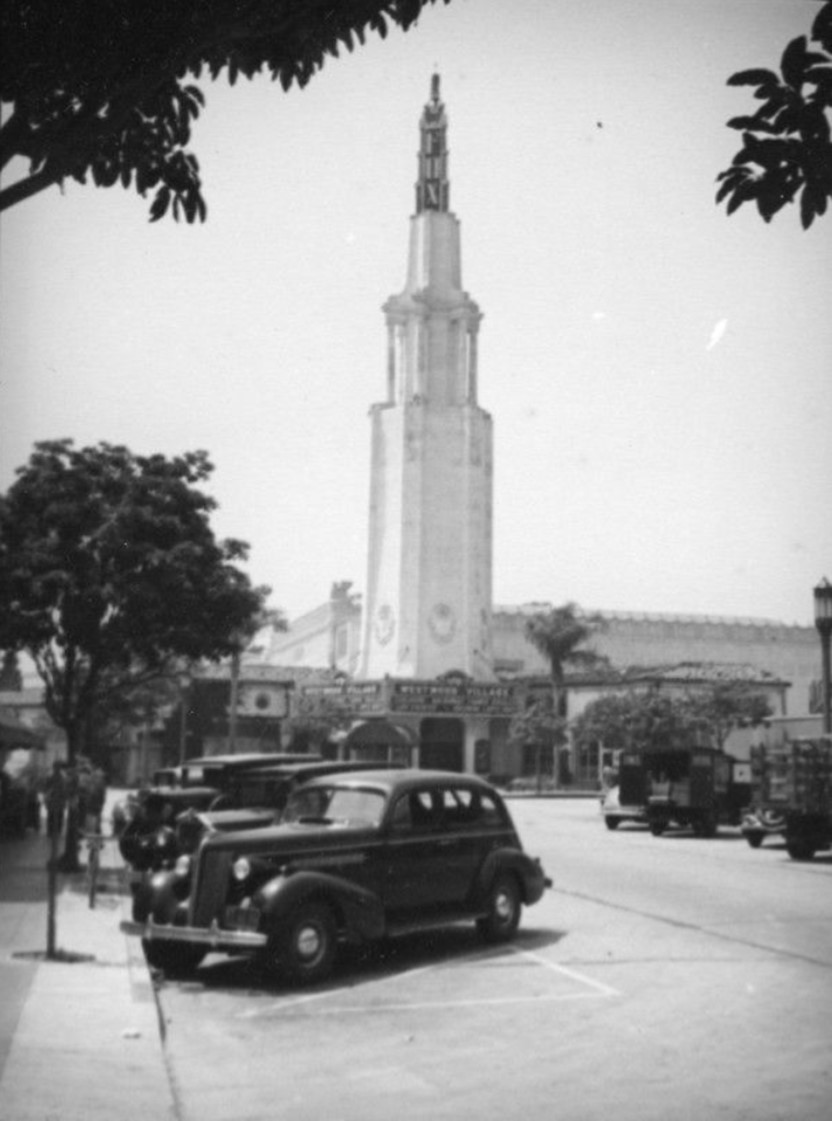 |
|
| (ca. 1938)* - View looking west down Weyburn Avenue towards the Fox Theater (later the Village Theater) in Westwood Village, located on the northwest corner of Weyburn and Broxton avenues. |
Historical Notes Designed by architect Percy Parke Lewis in Spanish Colonial Revival style with Classical Revival influences, the Fox opened in 1931 as part of a widespread cinema construction program undertaken by Fox West Coast Theatres. The Fox Theater quickly became the most recognizable symbol of the new Westwood Village. |
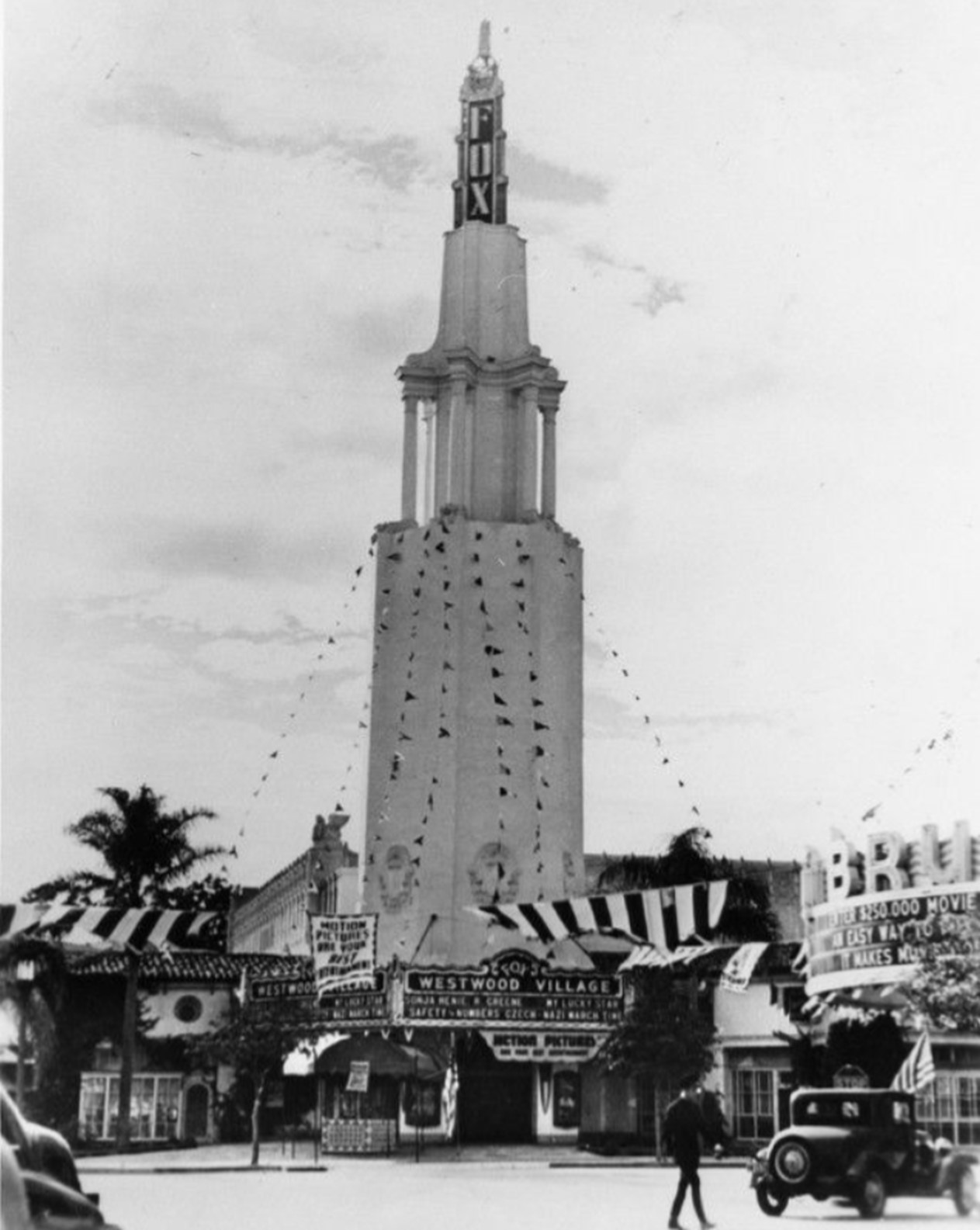 |
|
| (ca. 1938)* - Fox Theater is in the center of the picture, FOX clearly visible at the top of the building, and streamers of flags hanging from mid-high on the building down to the bop of the marquee. Advertised on the marquee is the movie My lucky star with Sonja Henie, R. Greene. On the right in the picture is the Bruin Theater. |
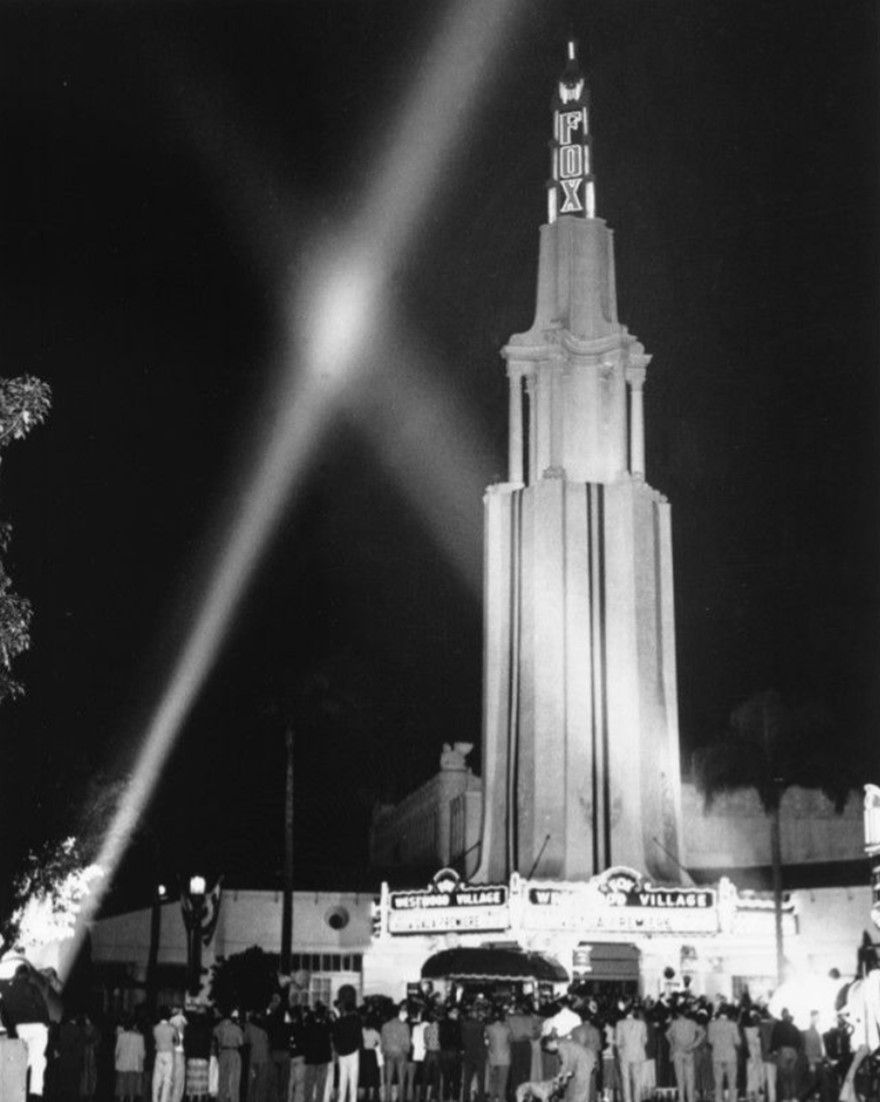 |
|
| (1951)* - Nighttime view of the Fox Westwood Village Theater. Crowds of people stand at the front of the theater to attend a premiere. |
Historical Notes A feature of the building is the huge ‘wedding cake’ tower which is still virtually unchanged today, and still sports its original neon lighting. |
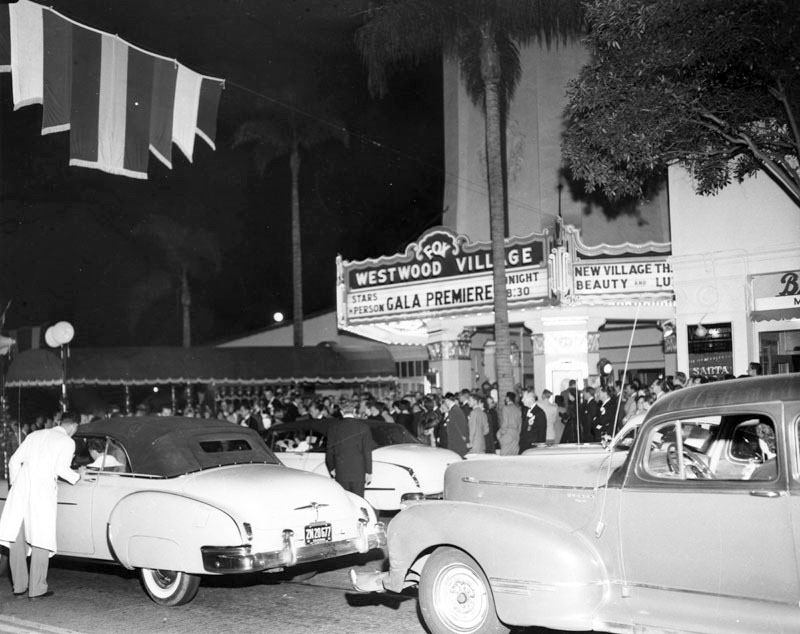 |
|
| (1951)* - Premier night at the Fox Westwood Village Theater (later renamed the Mann Village Theater). The marque reads: ‘Gala Premiere - Stars in Person - Tonight 8:30’. The street in front is completely filled with two rows of cars arriving for the gala, with attendants at the front cars to assist those arriving. The sidewalks underneath the marquee are filled with people. |
Historical Notes After more than 70 years as a first run movie palace, the Village Theatre is still one of the sites for Hollywood’s biggest movie premieres. Regency Theatres replaced Mann Theatres as the movie operator on April 1, 2010. Click HERE to see contemporary view. |
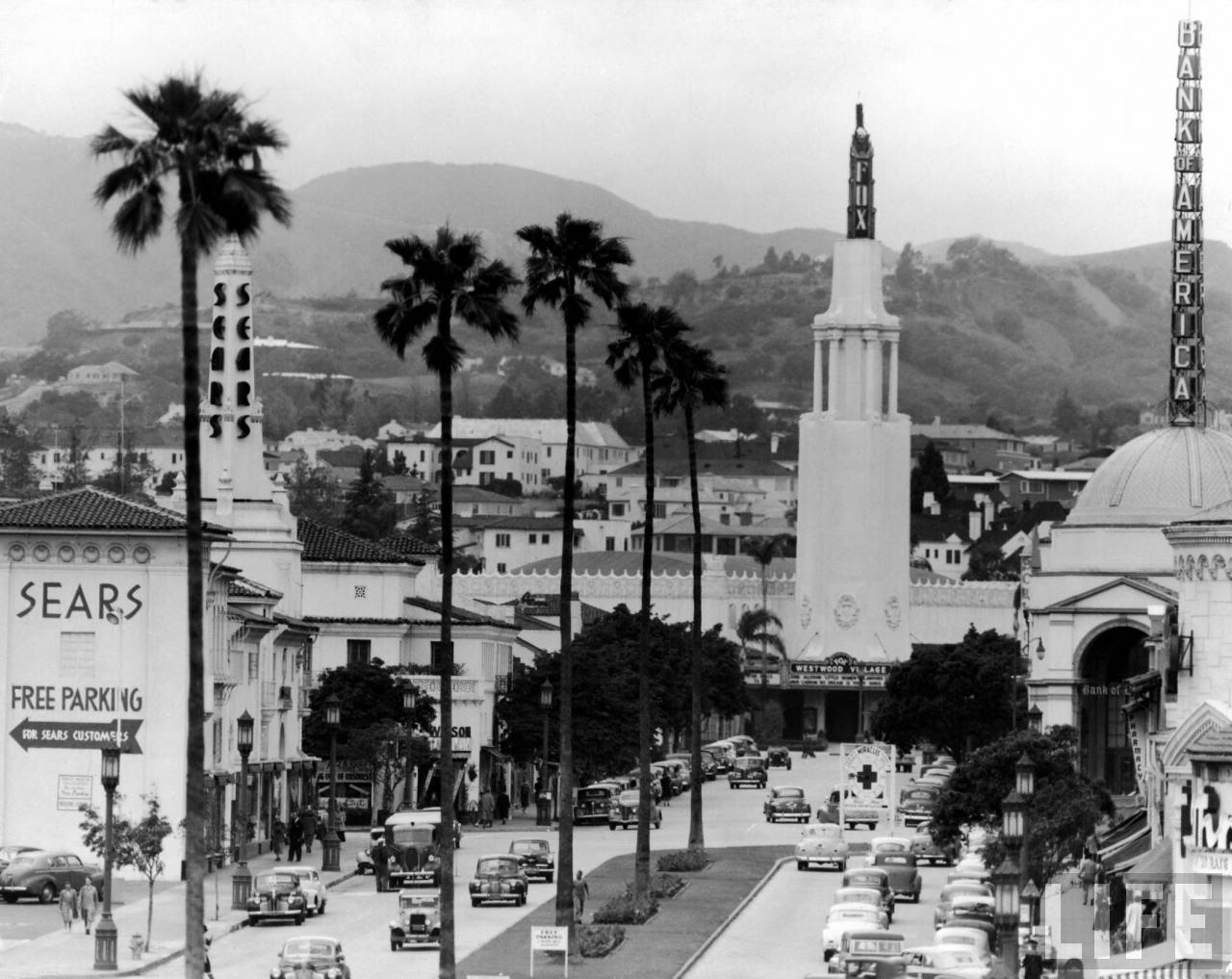 |
|
| (1949)^# - View looking northwest down Broxton Avenue. The towers of the Sears, Fox Theater, and Bank of America buildings can be seen in the background. Life Magazine Photo. |
Historical Notes A number of notable buildings remain from the early years of Westwood Village, including: The Fox Theater (or Village Theater) features a landmark 170-foot white Spanish Revival/Moderne tower and Churrigueresque stucco decorations. The theater looms over the Broxton and Weyburn Avenues intersection. Built in 1931 this cinema later became famous for the many movie premieres held there. The Janss Dome (Janss Investment Company Building) the first building to be built in Westwood Village in 1929, is another village landmark with its dome on an octagonal base, portico and large arched windows. The Dome is situated at the three-way intersection of Westwood Boulevard, Broxton and Kinross Avenues. Ralphs Market Building, also built in 1929, is a red tile-roofed Spanish Colonial Revival building featuring a rotunda with a pediment over the entrance and arcaded wings, at 1142–1154 Westwood Boulevard. The Bruin Theater (1937), a streamlined Art Deco cinema, which sits just across Broxton Avenue opposite the Fox Theater. These four buildings have all been declared Los Angeles Historic-Cultural Monuments (Click HERE to see complete list). Another village landmark is Holmby Hall (1929), a Spanish Colonial Revival building featuring a clock tower which was damaged by fire around 2003, located at the corner of Weyburn Avenue and Westwood Boulevard. |
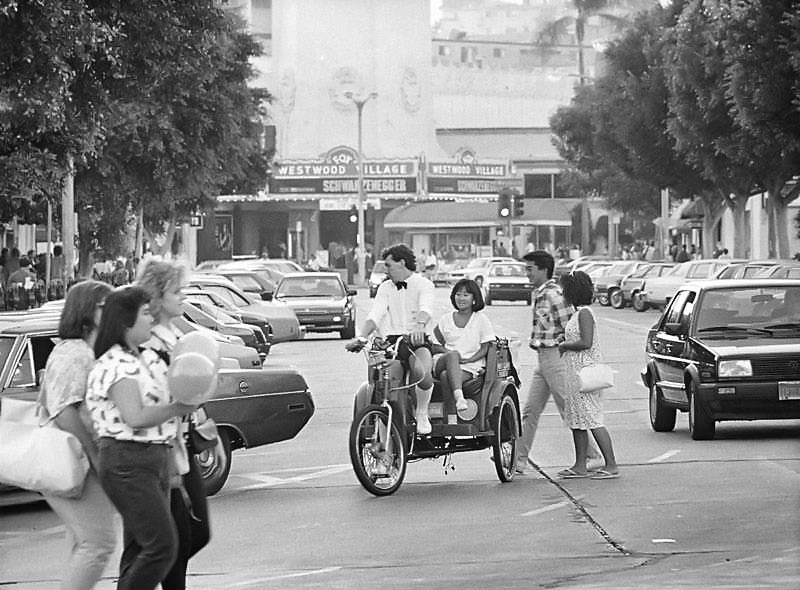 |
|
| (1980s)* – View looking west on Weyburn Avenue toward the Fox Westwood Village Theatre on Broxton Avenue, with a pedicab visible in the foreground. Photo courtesy of Obet Maldonado. |
Historical Notes In the ’80s, getting around the village by pedicab—a mix of rickshaw, bicycle, and taxi—was a popular option. Drivers had to be male, with at least two years of college and a 3.0 GPA or higher. Dressed in tuxedo shirts, shorts, and bow ties, they got quite a workout on the job, while passengers paid $3 per ride. |
* * * * * |
Bruin Theatre
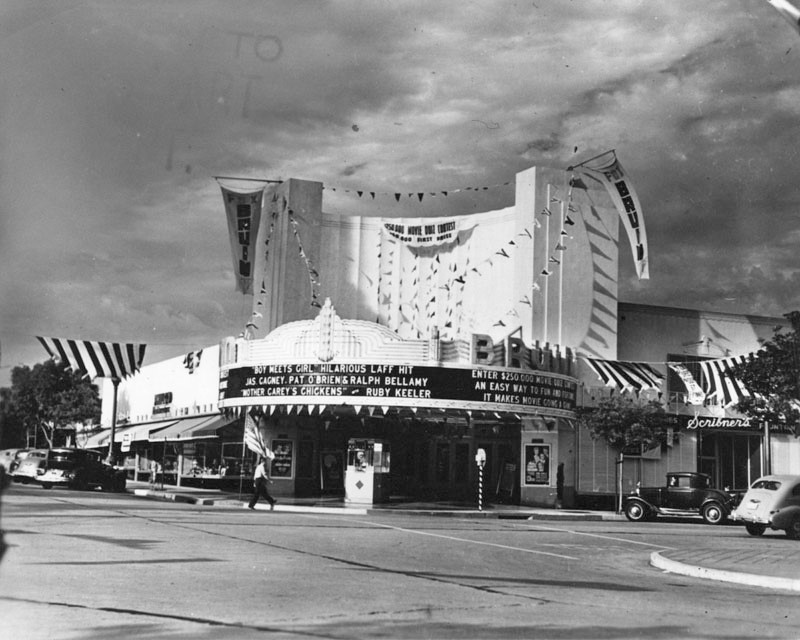 |
|
| (1938)* – View looking at the Bruin Theater located on the northeast corner of Broxton and Weyburn avenues, across the street from the Fox Theatre. The marquee wraps around the corner to be seen from all directions. |
Historical Notes The Bruin Theater opened across the street opposite the Fox Theater in 1937, as the second movie theater in the Village. This City Historic-Cultural Monument was designed by renowned theater architect S. Charles Lee in Streamline Moderne style, with UCLA inspired blue-and-gold neon flashing along the sweeping curve of its Art Deco style theater marquee. |
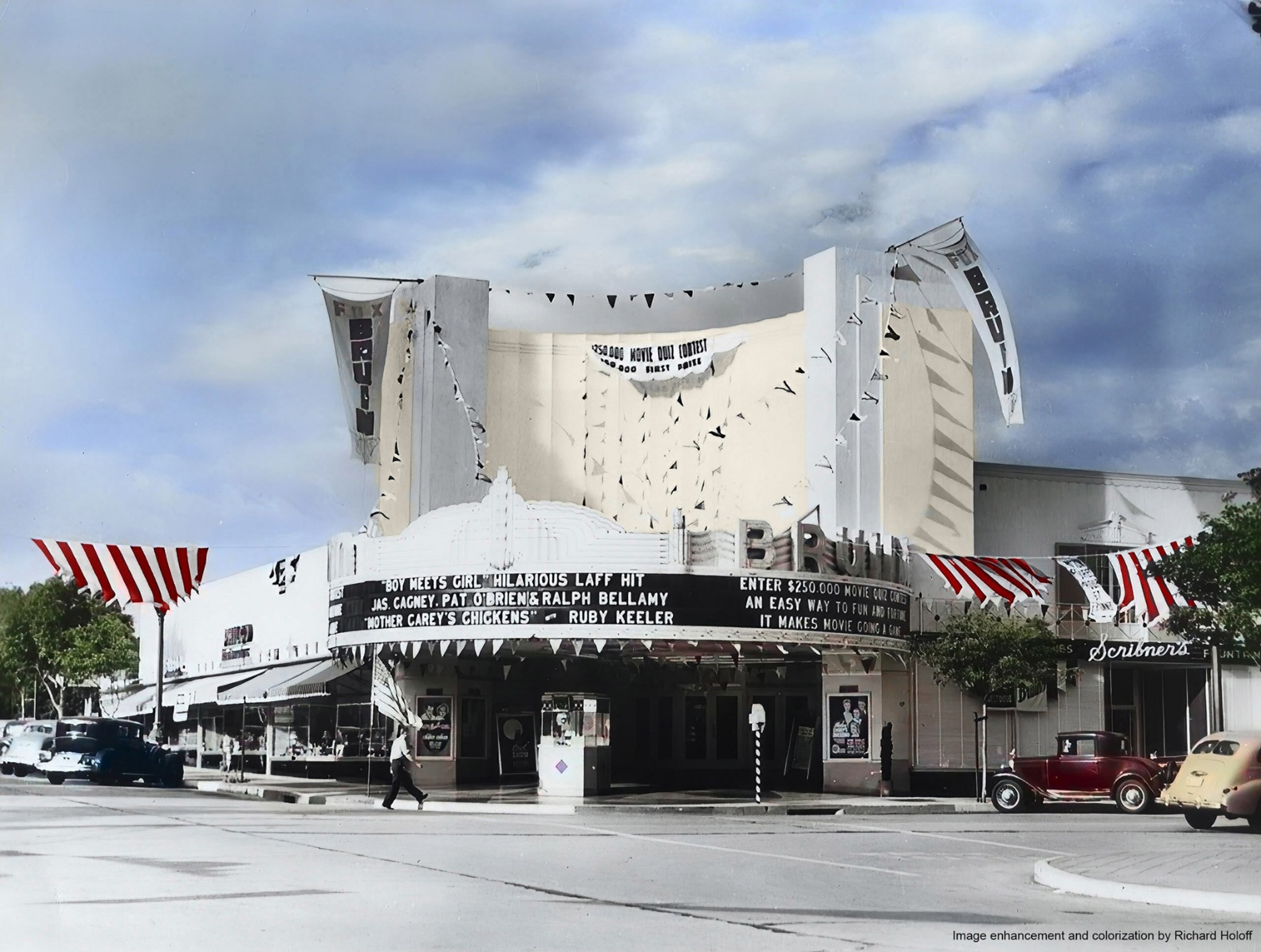 |
|
| (1938)* – View looking at the Bruin Theater located on the northeast corner of Broxton and Weyburn avenues, across the street from the Fox Theatre. The marquee wraps around the corner to be seen from all directions. Image enhancement and colorization by Richard Holoff. |
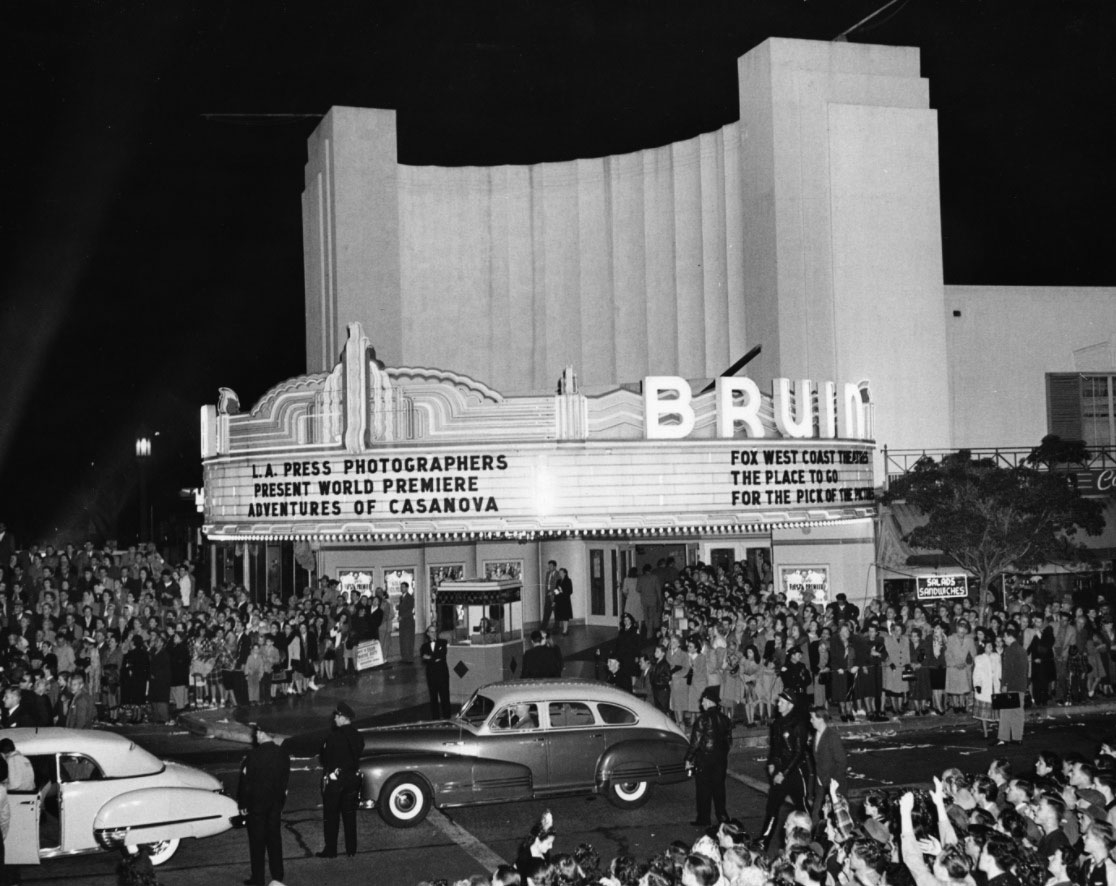 |
|
| (1948)* – Bruin Theater premier of “Adventures of Casanova” getting the Hollywood red carpet treatment. Throngs of movie fans surround the theater, eager to catch a glimpse of their favorite stars. |
Historical Notes The Fox Bruin Theatre originally had 876 seats, all on a single floor. It was designed by architect S. Charles Lee, one of the foremost & prolific theatre architect’s in Southern California, who’s earlier work included the downtown Tower Theatre and Los Angeles Theatre. |
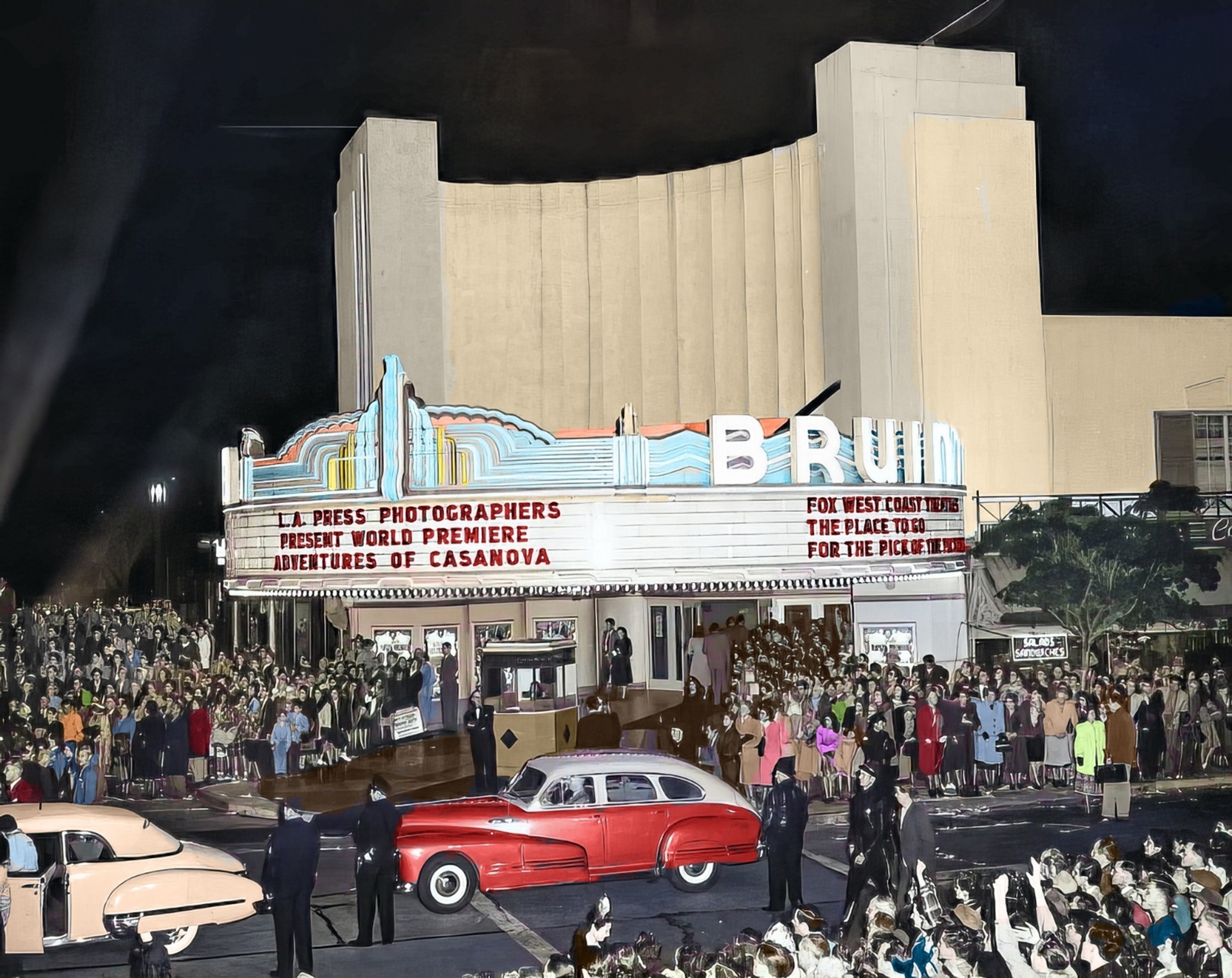 |
|
| (1948)* – Bruin Theater premier of “Adventures of Casanova” getting the Hollywood red carpet treatment. Throngs of movie fans surround the theater, eager to catch a glimpse of their favorite stars. Image enhancement and colorization by Richard Holoff |
Historical Notes The theater was taken over by Mann Theatres chain in 1973 and was equipped to screen 70mm movies in 1978. Regency Theatres replaced Mann Theatres as the movie operator on April 1, 2010. Click HERE for contemporary view. |
* * * * * |
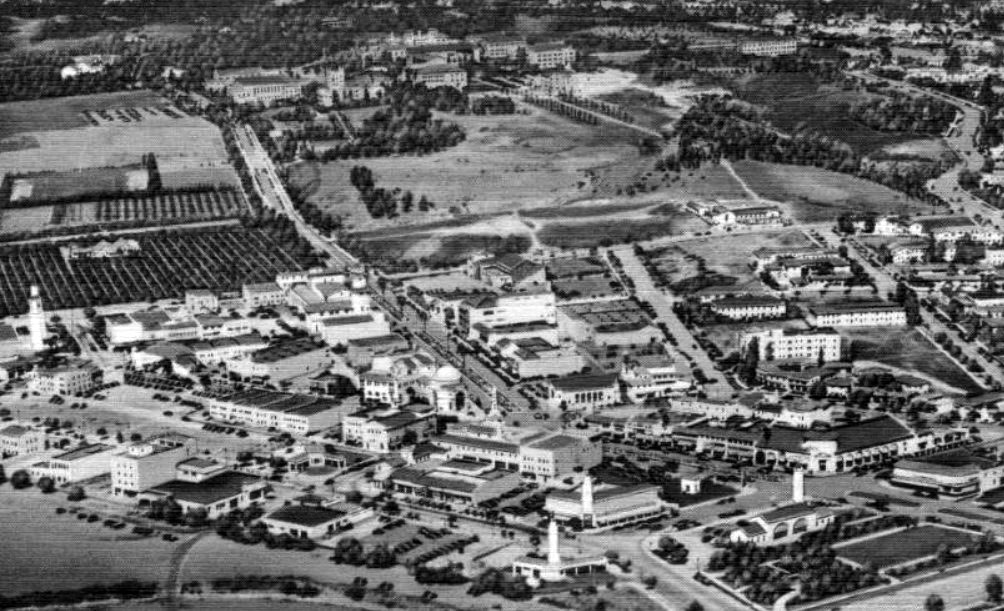 |
|
| (1939)* – Postcard view of Westwood Village showing the University of California (UCLA) in the background. |
Historical Notes TBack of postcard reads: Westwood is a district 13 miles west of downtown Los Angeles, and includes the campus of the University of California, Los Angeles (UCLA), a residential neighborhood, and Westwood Village, a shopping district. Clustered around its central thoroughfare of Westwood Boulevard, the shopping district serves the affluent neighborhoods of Bel Air and Westwood to the north, as well as students from UCLA. |
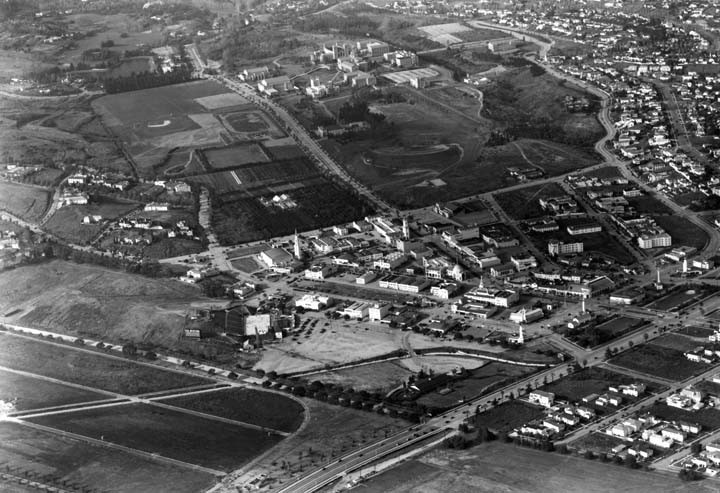 |
|
| (1940)#^ – Aerial view looking northeast showing a built-up Westwood Village. The UCLA campus can be seen in the distance at top of photo. Venteran Avenue runs diagonally from lower-right. Sepulveda Boulevard is at lower-left (out of view). |
.jpg) |
|
| (1937)* – View looking north on Sepulveda Boulevard from Wilshire Boulevard in Westwood, showing the pepper trees as they appeared at sundown. This section of the boulevard was also known as Pepper Tree Lane. Click HERE for contemporary view. |
 |
|
| (1940s)* - View of Desmond's Department Store, located at 1001 Westwood Boulevard. Several people can be seen walking across Weyburn Avenue, and the white tower of the Fox Theater, later Village Theater, is visible in the background on the right. |
Historical Notes The first Desmond's Department Store was opened on Olvera Street in 1862. In 1921, Ralph R. Huesman purchased the store from the Desmond family and led the expansion of the retailer to several locations throughout the Southern California market.* Today, a CVS Pharmacy occupies the old Desmond's Store. Click HERE to see contemporary view. |
 |
|
| (1940)^ – View looking south on Westwood Boulevard from Weyburn Avenue showing Desmond's Department Store, Bank of America, and Myer Siegal. Photo by Dick Whittington |
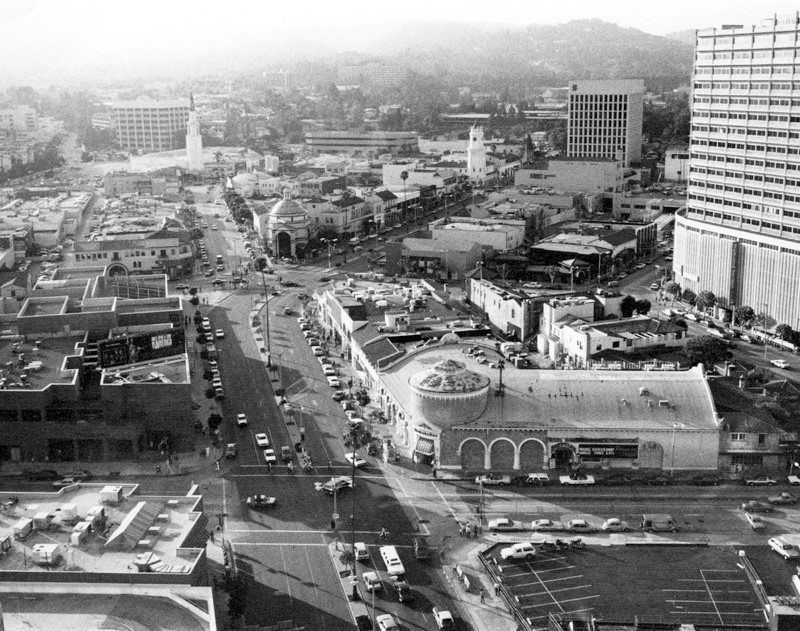 |
|
| (1954)* - Aerial view looking north on Westwood Boulevard from just south of Wilshire Boulevard. The Bank of America (Janss Dome) can be seen at center-top. Also seen are the towers of Fox Theatre and the Holmby Building. |
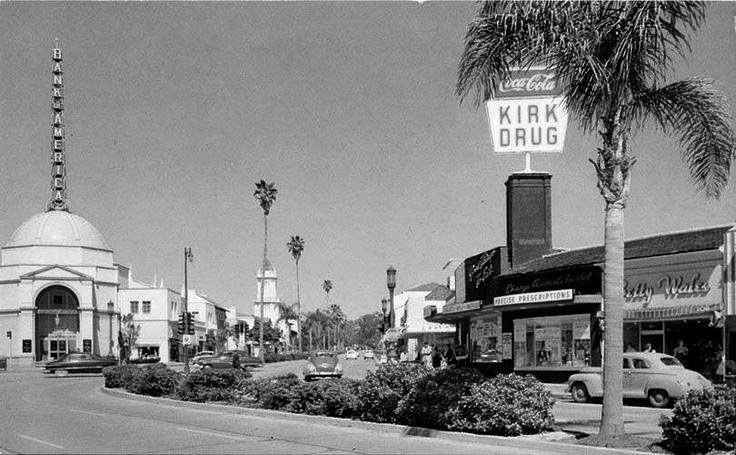 |
|
| (1950s)^ – View looking northeast showing where Westwood Boulevard meets Kinross Avenue. The striking Bank of America building (today Yamato Restaurant) with its soaring tower is on the left with Kirk Drug Store on the right. The Bette Wales store specializing in ladies sportswear is on the far right. |
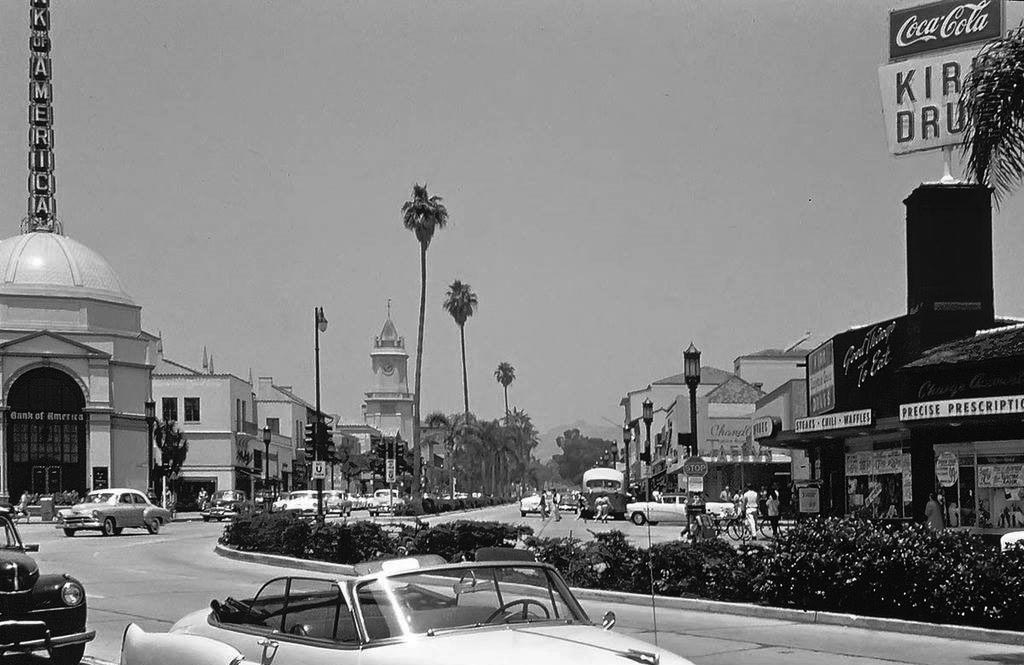 |
|
| (ca. 1956)*#* - Another view looking northeast on Kinross Avenue from Westwood Boulevard with an early 1950s Cadillac convertible in the foreground. |
Then and Now
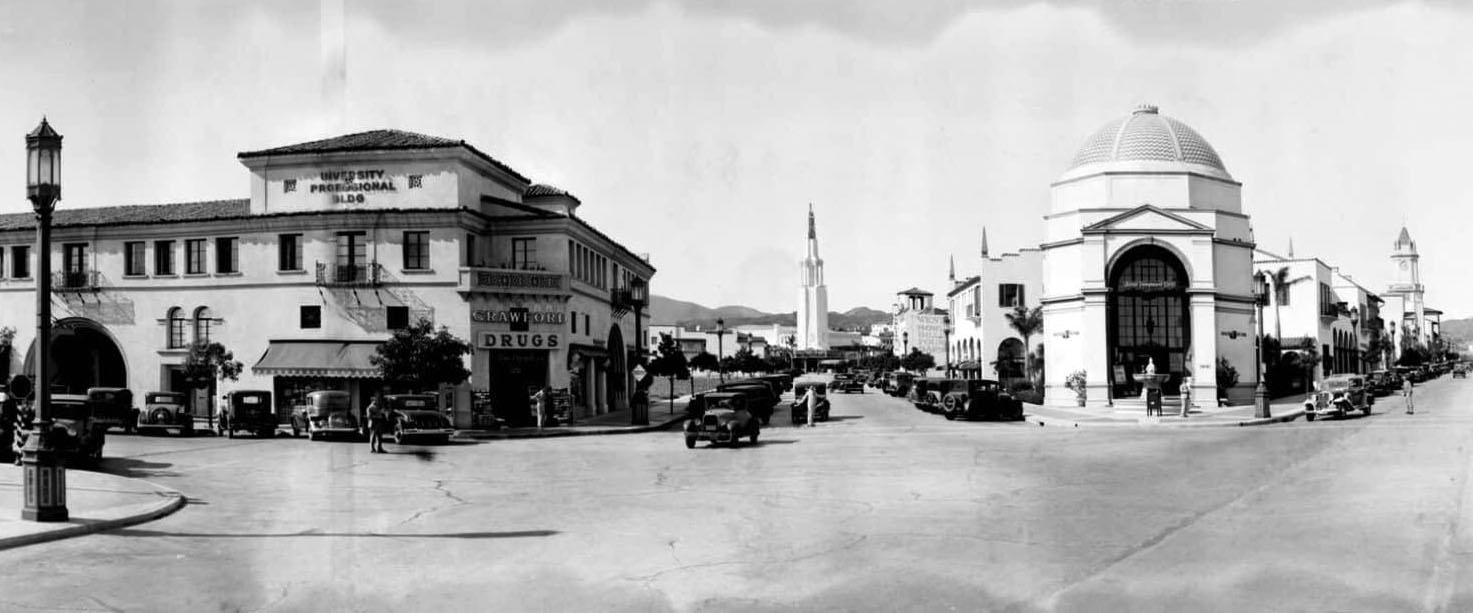 |
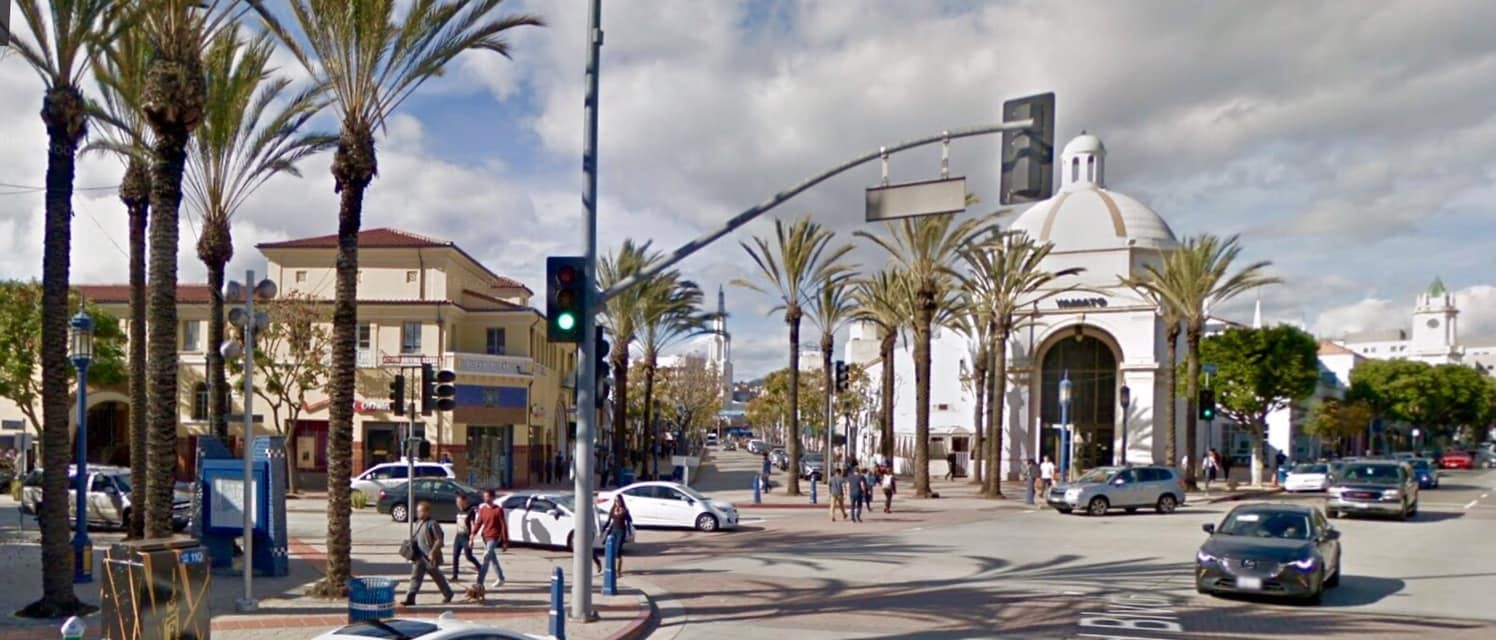 |
|
| (1932 vs. 2021)^ - Westwood Village |
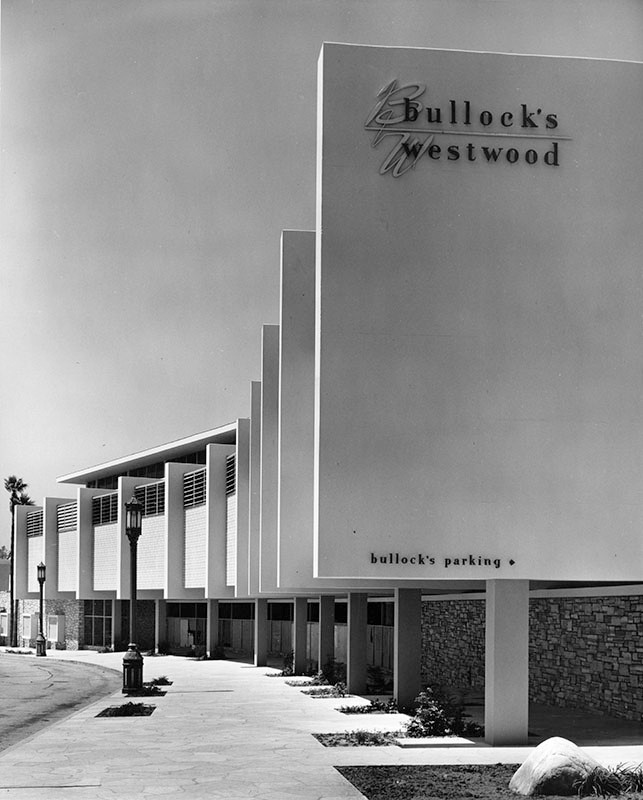 |
|
| (1951)* - Exterior view of the recently completed Bullock's Westwood, located at 10861 Weyburn Avenue in Westwood Village. Photograph dated September 5, 1951. |
Historical Notes The new Westwood Bullock’s replaced the original Bullock's store that was of Spanish style architecture and served the community from 1932 until 1951. The store contained three-levels and included unique four-level parking. |
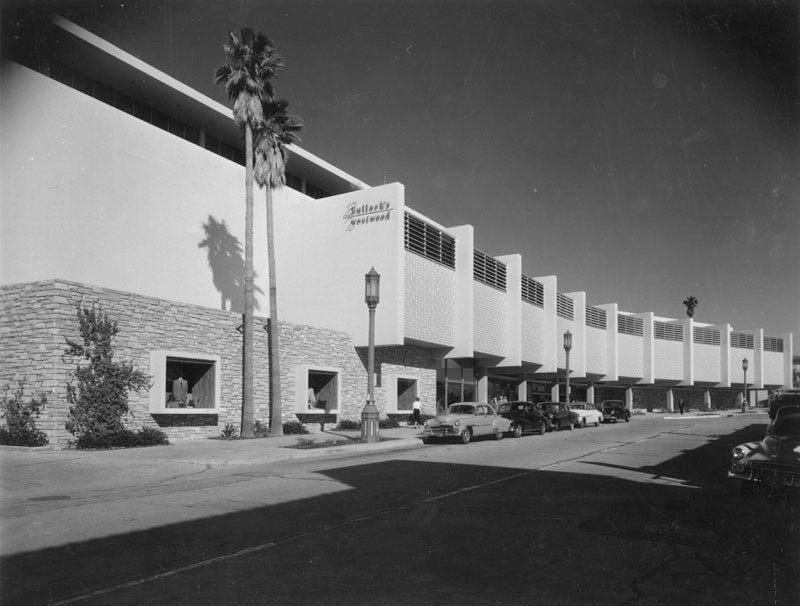 |
|
| (ca. 1953)* – View showing the Bullock's Westwood store with cars parked by the curb in front. |
Historical Notes The new Westwood Bullock's store, designed by Welton Becket, opened in 1952. It lasted for over forty years as a Bullock's, becoming a Macy's store in 1996. But three years later it was closed. |
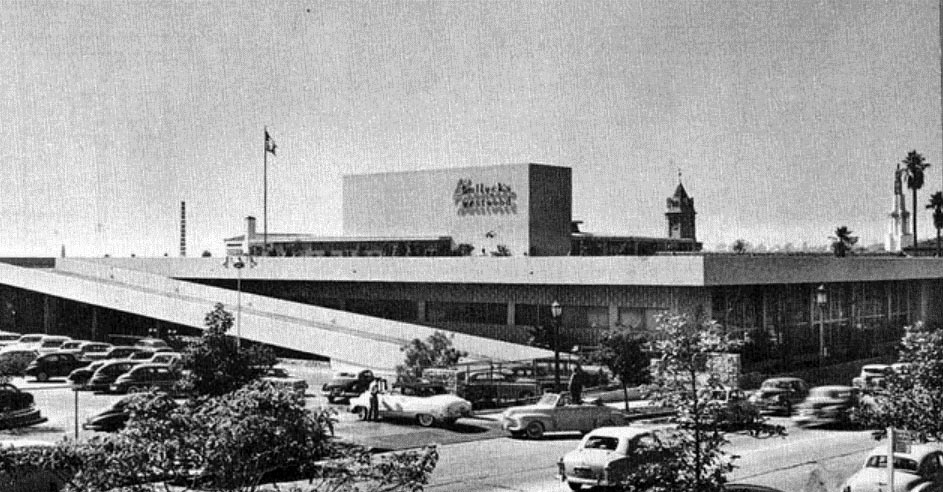 |
|
| (ca. 1952)^ - View of Bullock's Westwood from Le Conte Avenue showing part of its four-level parking. The tower of the Holmby Building can be seen in the background. |
Historical Notes In 2001 the building was remodeled to become an EXPO Design Center. A City Target opened in the space in 2012, and in 2015, a Ralphs Grocery Store (largest in Southern California) opened on the middle level. Click HERE to see contemporary view. |
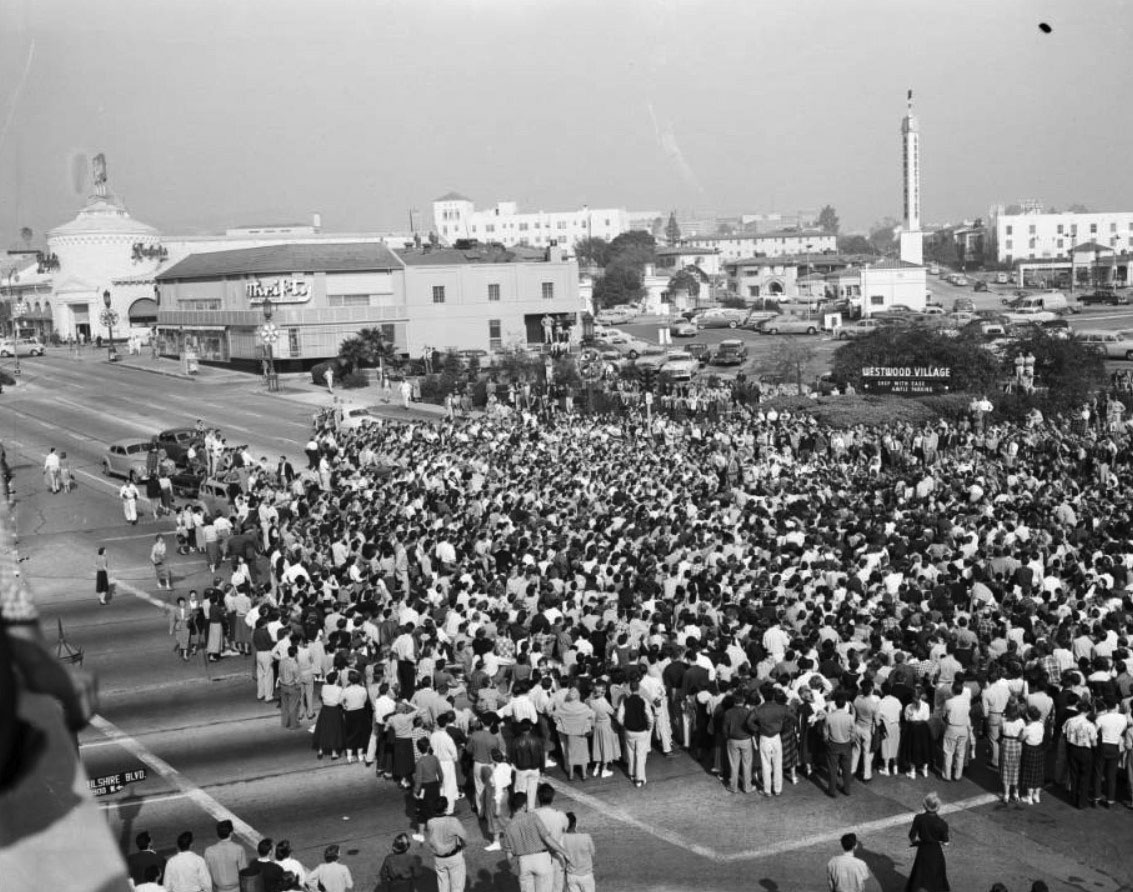 |
|
| (1953)^– View showing a Victory rally in Westwood Village, at the intersection of Wilshire and Westwood boulevards. |
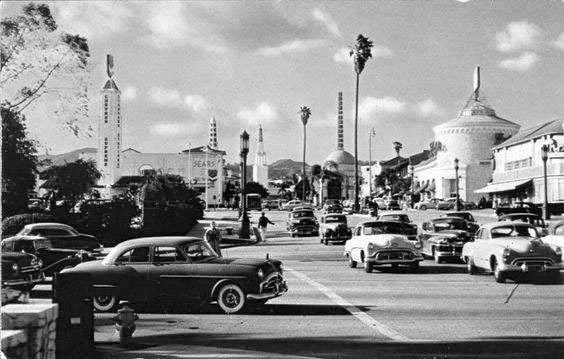 |
|
| (ca. 1956)^^# – View looking northward across Wilshire Boulevard into Westwood Village. |
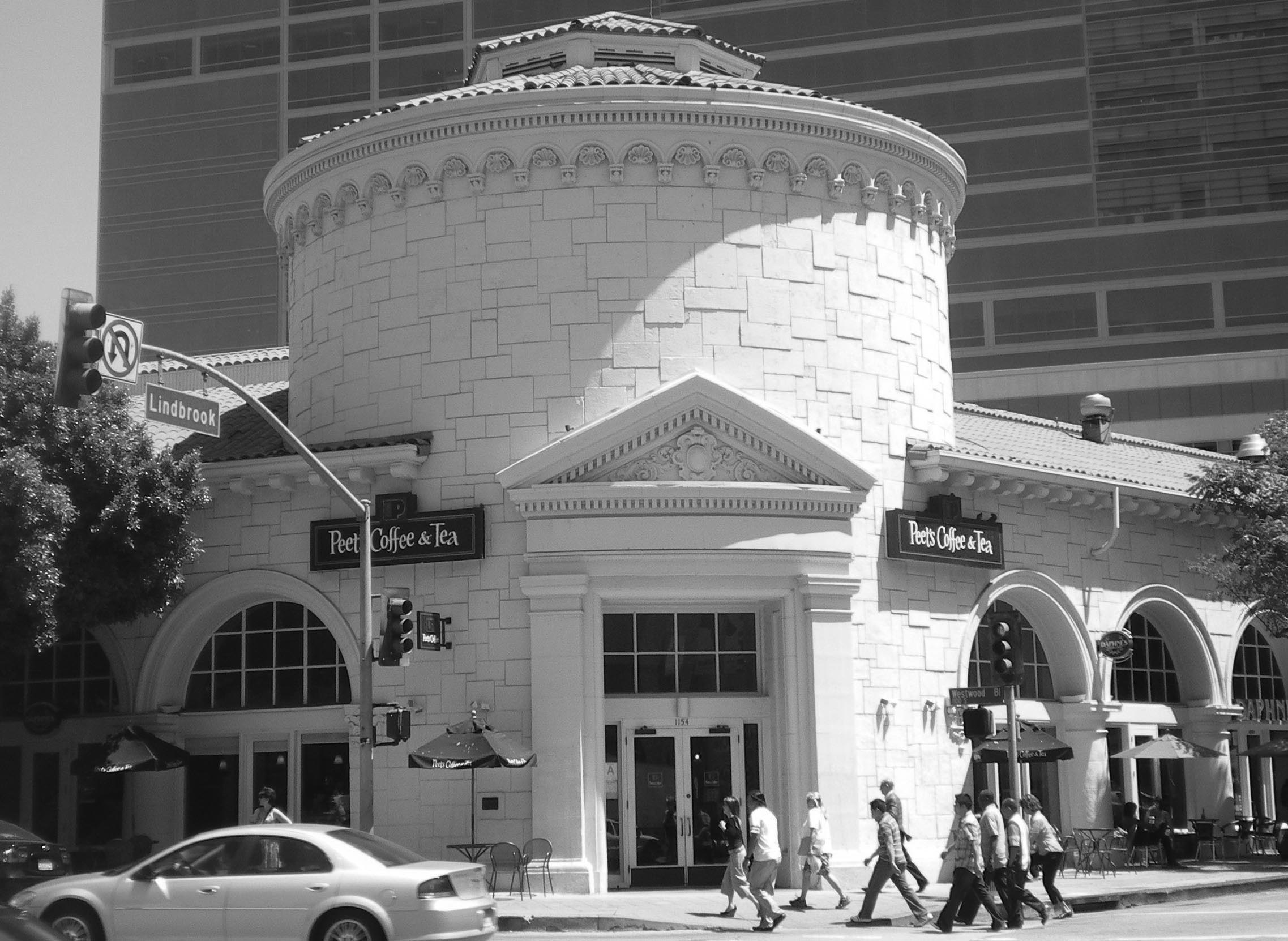 |
|
| (2008)*^ - View showing the Ralphs Grocery Store building as it appears today, with Peet's Coffee & Tea now occupying the corner. Ralphs moved further north into the old Bullock's Westwood structure on Le Conte Ave. |
Historical Notes Built in 1929, Ralphs Grocery Store was one of the original six buildings in the Westwood Village development. The building was noted for its cylindrical rotunda capped by a low saucer dome, with a pediment over the entrance and arcaded wings extending north and east. It was photographed by Ansel Adams in 1940, declared a Historic-Cultural Monument in 1988, and listed on the National Register of Historic Places in 1992.*^ |
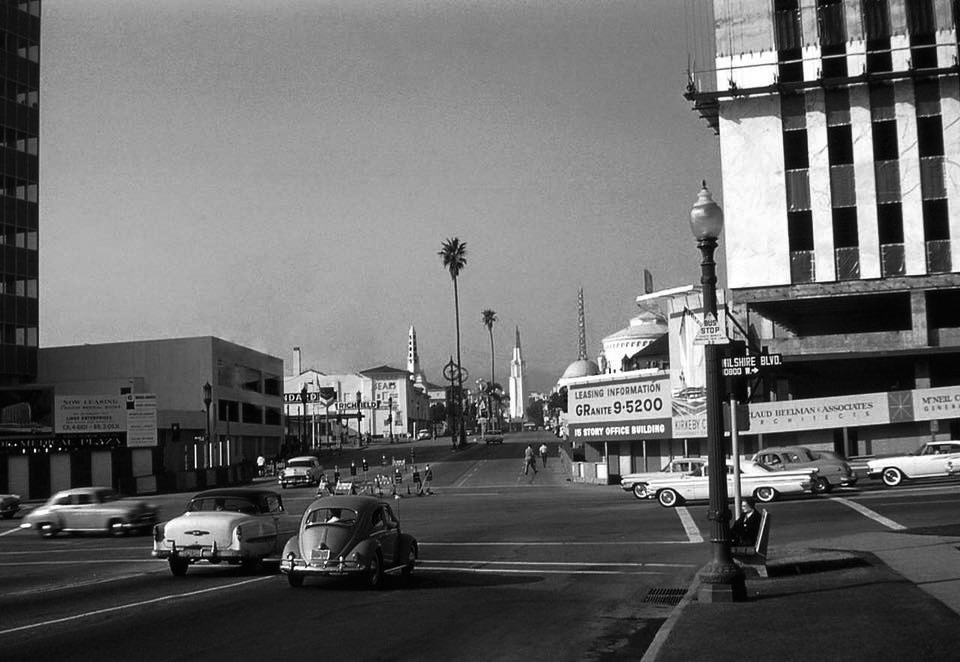 |
|
| (1961)* - View looking north on Westwood Boulevard at Wilshire with the Art Deco tower of the Fox Theatre in the distance. Two new high-rise office buildings are under construction on the N/E and N/W corners. Photo: Vintage Los Angeles. |
Historical Notes The altering of the area's skyline began here with construction of the two hi-rises on the north corners---the Linde Medical Center (currently the Westwood Medical Plaza) and Occidental Petroleum Center (recently purchased by UCLA). Today the Hammer Museum is located at right, on the N/E corner of Wilshire and Westwood Blvd. |
National Theatre
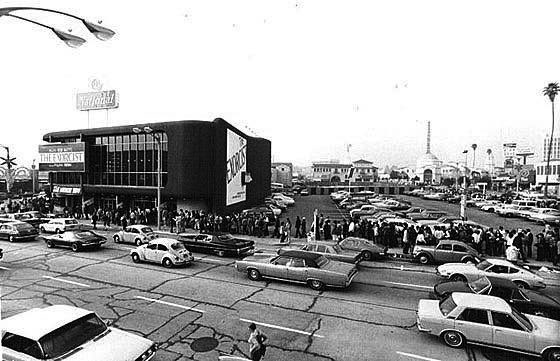 |
|
| (1973)* – View looking north across Lindrook Drive showing long lines in front of the National Theatre, located on the NE corner of Lindbrook Drive and Gayley Ave. In the distance, past the theater parking lot, can be seen Janss Dome. |
Historical Notes The debut of the National Theatre was March 27, 1970 with "The Boys in the Band." It was a project of National General Corporation, then the operator of the remnants of the Fox West Coast chain. The location was the northeast corner of Lindbrook and Gayley Ave. |
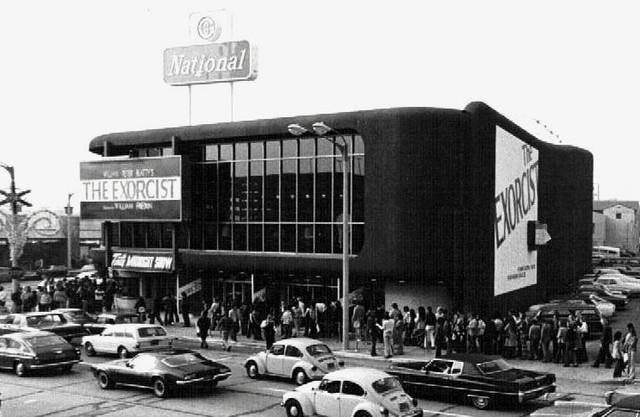 |
|
| (1973)^* – Close-up view of the the National Theatre with people waiting in long lines to see opening of ‘The Exorcist’. |
Historical Notes Starting construction in 1969, the 1,112 seat National Theatre was to be called the Fox Westwood (not to be confused with the classic Fox Westwood Village theatre two blocks away). But by the time the theatre opened to the general public on Friday, March 27, 1970, the National name graced the front of the building. That was because National General had just phased out the Fox name that appeared as part of every one of their theatre names (for years, directory ads always read National General's Fox West Coast theatres).^ |
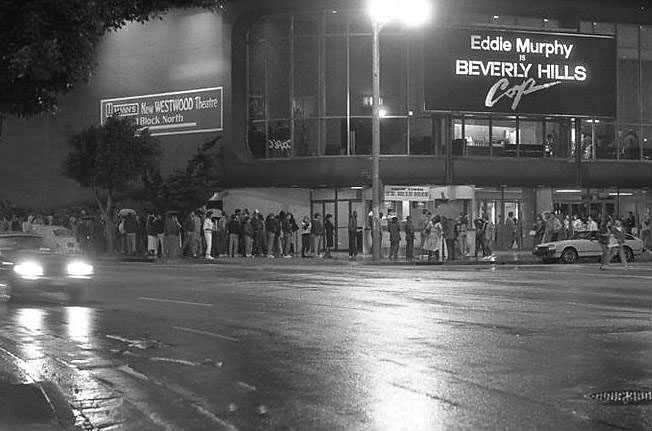 |
|
| (1984)** – Moviegoers line up in front of the National Theatre in Westwood to "Beverly Hills Cop" with Eddie Murphy. Location: 10925 Lindbrook Drive, Westwood. UCLA Image Archive |
Historical Notes For years, the National was an exclusive engagement theatre, with clearance over every other theatre in a three county area (L.A., San Bernardino, Riverside). There were exceptions. After Fiddler on the Roof ended its reserved seat engagement at the Wilshire, the National was added to the selected theatre release, albeit with an exclusive 70mm print. |
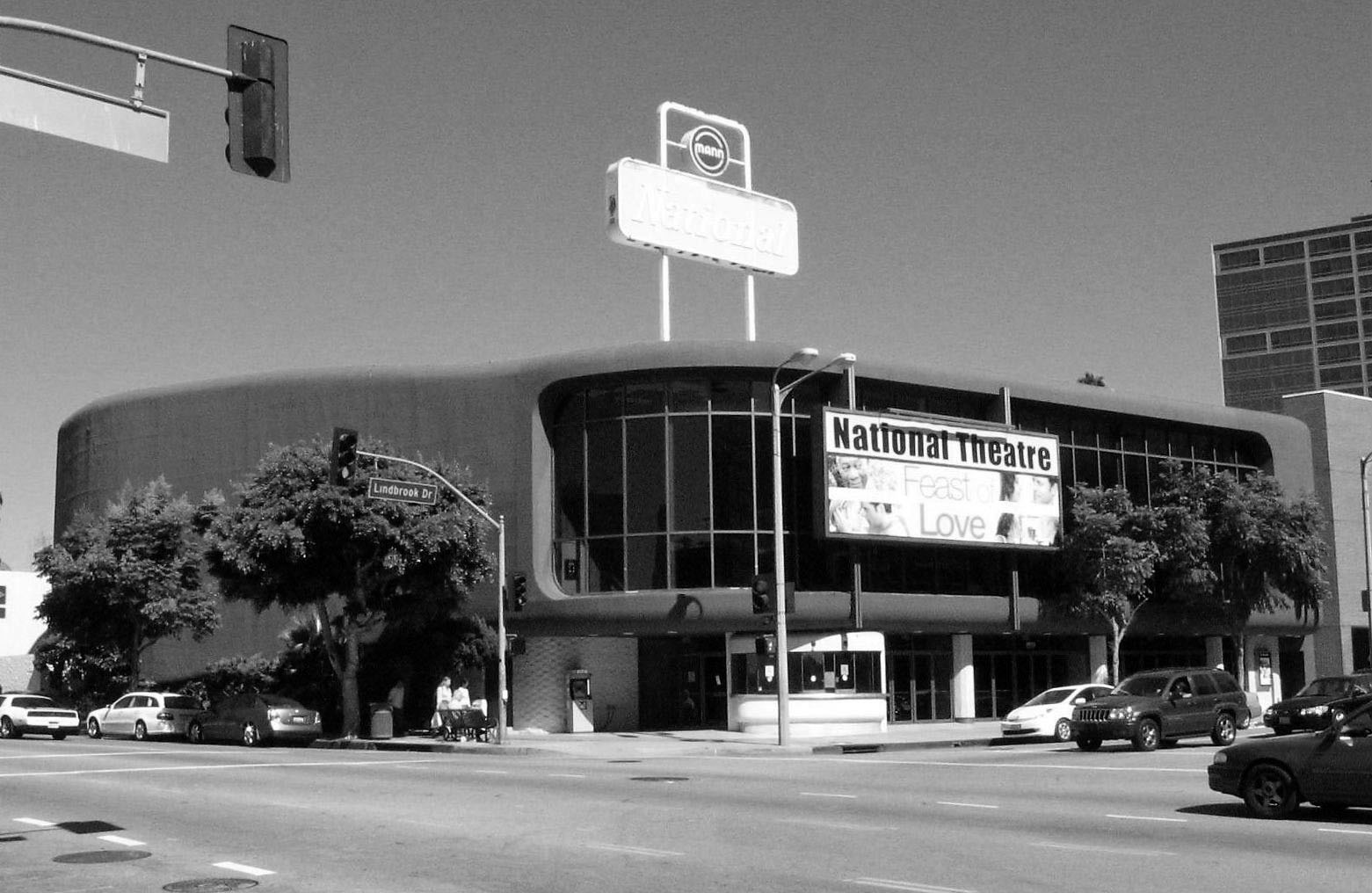 |
|
| (2007)* – View showing the National Theatre, NE corner of Lindbrook and Gayley, in its last year of operations. It was there between 1970 and 2007 before being torn down to make way for an office building. |
Historical Notes Designed by Architect Harold Levitt, the NGC National Theatre was one of the last single screen giants to be erected. Its 1970s futuristic-style exterior belied a large upstairs lobby (which was replete with chandeliers) and an enormous orange-colored auditorium (which boasted a massive screen 56ft wide and 26ft high). All seating was on a single sloping floor. It was equipped with Norelco DP-75 projectors which were capable of screening 35mm & 70mm films. One interesting feature of the theatre was its marquee. It mounted on two tracks, which allowed it to be lowered all the way to the ground for easy changing. Mann Theatres closed the theater on April 19, 2007. It was re-opened on May 11, 2007, by an independent operator, but closed again on October 7, 2007.* |
Ships Coffee Shop
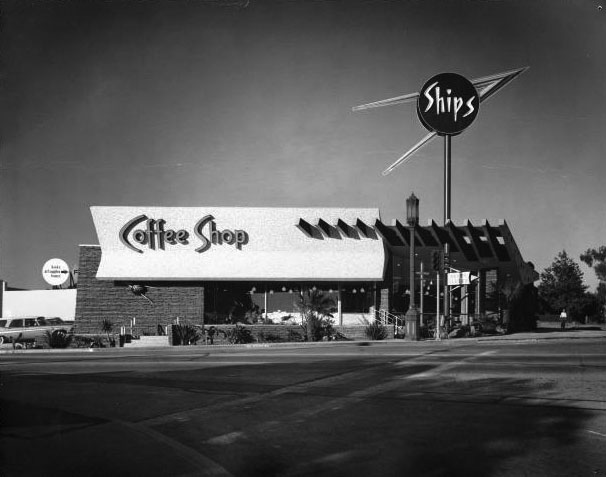 |
|
| (ca. 1963)+# – View showing Ships Coffee Shop located on the northeast corner of Wilshire Boulevard and Glendon Avenue in Westwood. Ships' iconic Modern architecture is classified Googies Architecture. |
Historical Notes There were three Ships locations opened by resterauteur Emmett Shipman and his father Matt Shipman, at Westwood, Culver City and La Cienega (near Olympic). They were open 24 hours, 365 days a year, never closing. The first Ships Coffee Shop opened in Culver City (1956). Architect Martin Stern, Jr. designed that building and the second Ships (seen above), which was built in Westwood in 1958. There was a third Ships built near La Cienega and Olympic (1968). Fans of Googies Architecture considered the Westwood location a fine example of the futuristic style, with its hovering angular roof canopy and glass walls that seemed to defy the rules of gravity. It was a huge hit with UCLA students. ^+^ |
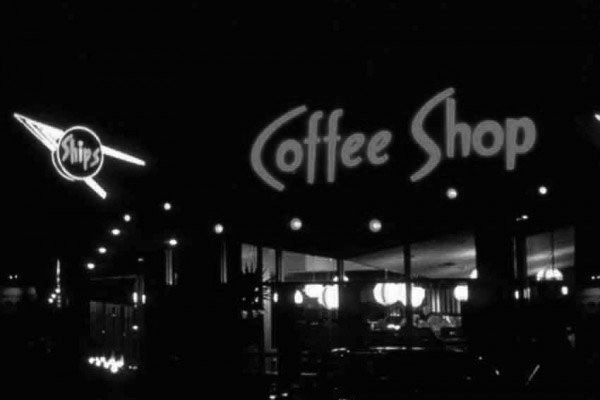 |
|
| (1963)*^* – Night view showing Ships Coffee Shop located at 10877 Wilshire Boulevard. Photo by George Mann |
Historical Notes With their boomerang-shaped roofs and futuristic neon signs, Ships Coffee Shops were impossible to miss. Inside, the small chain dished out American favorites, but the diners’ exteriors were otherworldly; they looked like UFOs! |
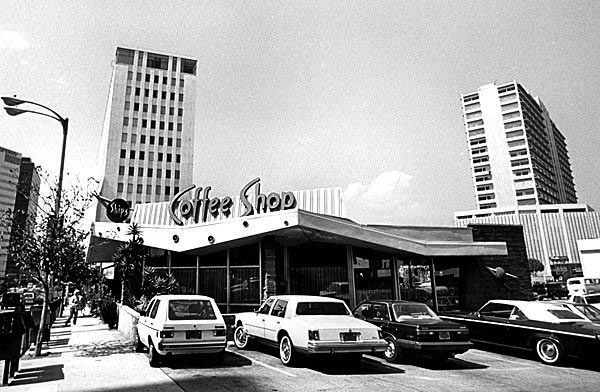 |
|
| (ca. 1984)#+ – Sidewalk view looking west on Wilshire Boulevard showing Ships Coffee Shop and parking lot. The tall building on the left is the Occidental Petroleum Center, currently Union Bank, Hammer Museum, and the Billy Wilder Theatre. LA Times |
Historical Notes Both locals and tourists loved Ships. The three restaurants served 50 million customers from 1956 to 1996. Because there was a toaster on every table, Ships always smelled of burnt toast. Preparing your own toast of choice was the main event. *^* |
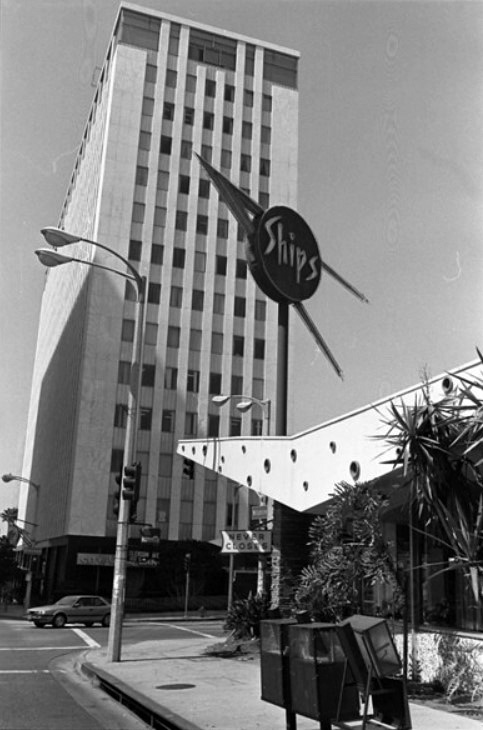 |
|
| (1984)^.^ – Ships, Westwood shortly before it was demolished, with the Occidental Petroleum Center in the background. |
Historical Notes The Ships Coffee Shop in Westwood closed on September 20th 1984 and was demolished the following day, to make way for a 20 story office building. *^* |
Monty's Steakkhouse
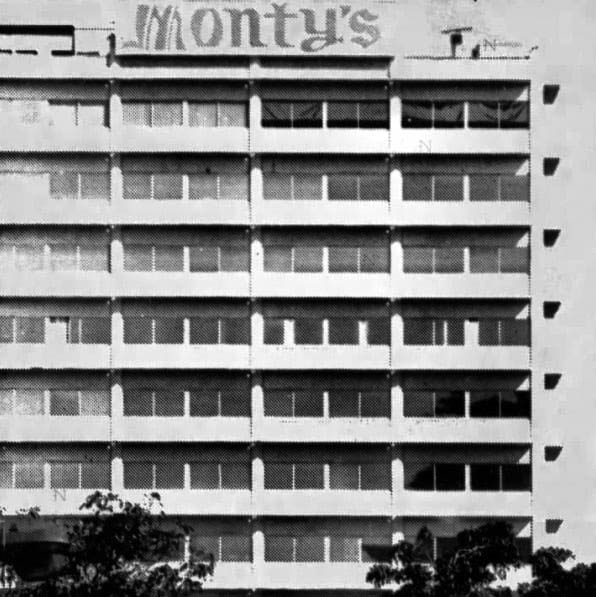 |
|
| (1987)^ - Monty's Steakhouse, located on the top floor of the Westwood Center Building at 1100 Glendon Avenue. |
Historical Notes There was a Monty’s at the top of an office building, high above Westwood, with a wonderful view of UCLA and the hills of Bel Air beyond. Monty’s Steakhouse, the Westwood fixture set atop the Westwood Center building at 1100 Glendon Ave. It had been entrenched in the penthouse since 1969 (the structure dates from ’65). During its reign, its neon sign became a landmark and its dark interior saw lots of interesting events, including Snoop Doggy Dogg’s acquittal party. It was also the spot for scores of recruitment dinners for UCLA athletes, including the infamous meal that led to basketball coach Jim Harrick’s dismissal in November 1996.* Monty's Steakhouse was closed in 1999 just before the building it was housed in (Westwood Center Building) was renovated. |
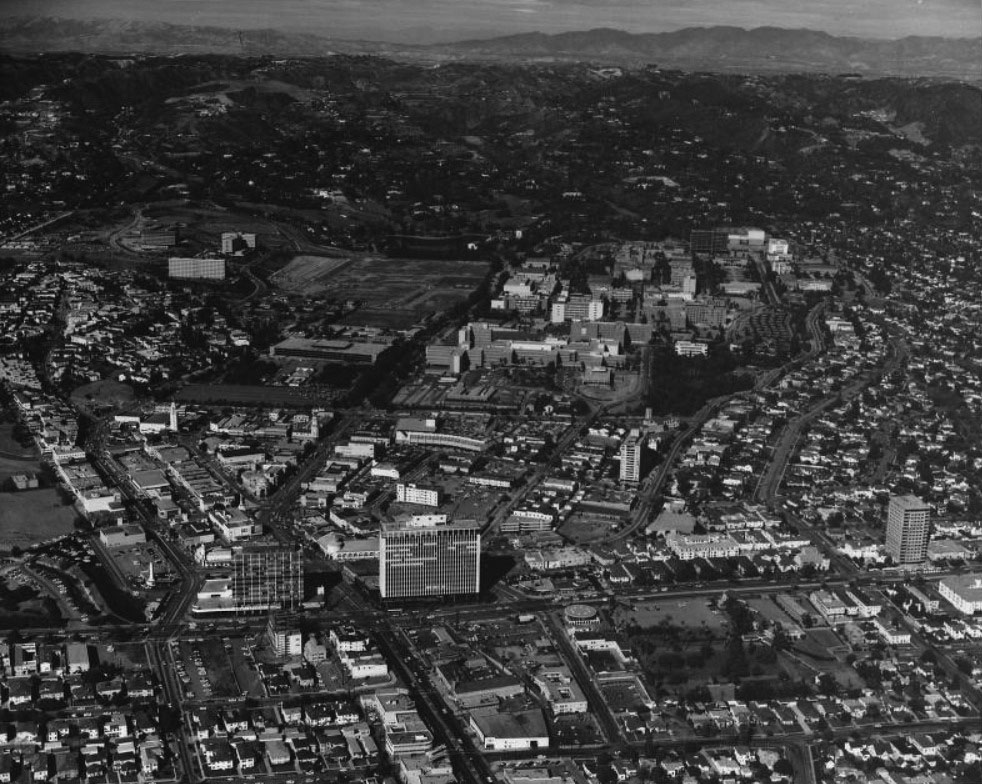 |
|
| (1966)^^ – Aerial view looking north showing the two new high-rises at the intersection of Wilshire and Westwood boulevards (lower center-left) with Westwood Village and the UCLA campus seen further back. |
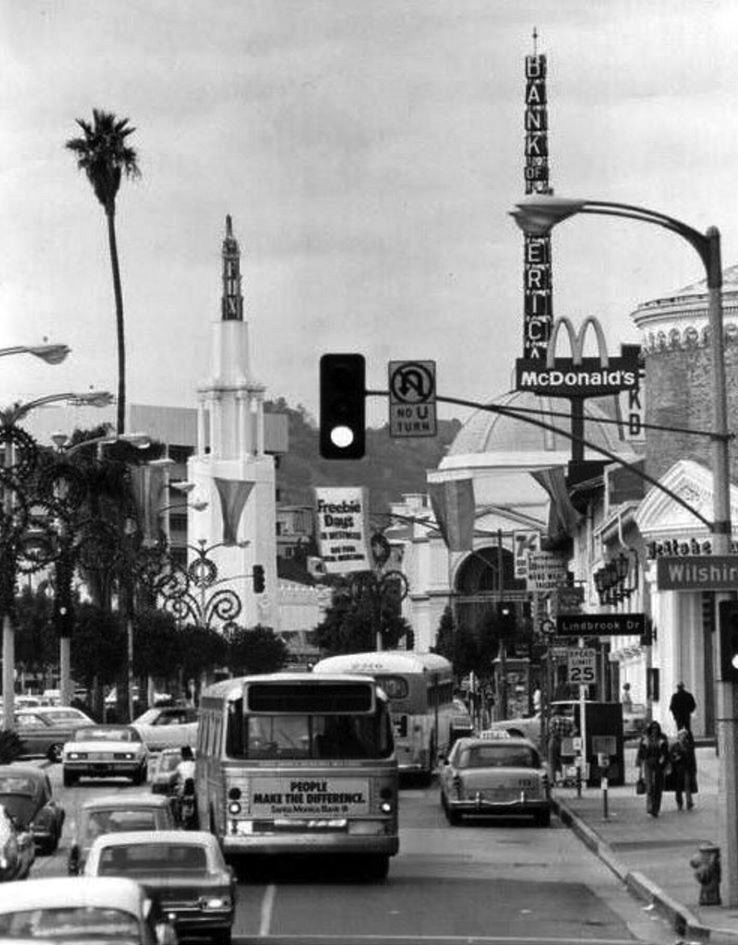 |
|
| (1970's)^.^ - Westwood Village. Photo courtesy Bill Koegler |
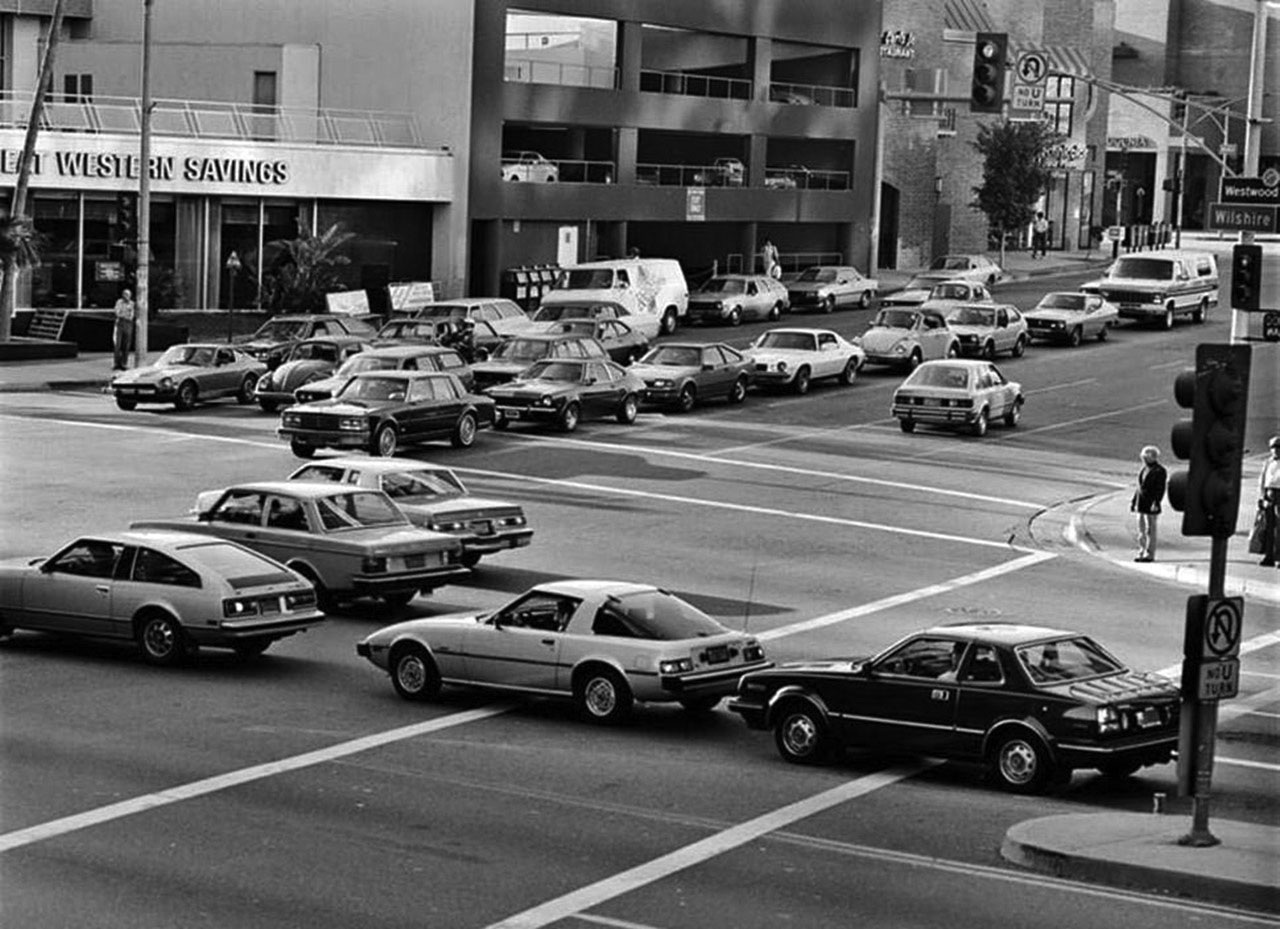 |
|
| (1980s)* – Wilshire and Westwood boulevards – Gateway to Westwood Village. No SUV's seen here. Click HERE for contemporary view. |
* * * * * |
Please Support Our CauseWater and Power Associates, Inc. is a non-profit, public service organization dedicated to preserving historical records and photos. Your generosity allows us to continue to disseminate knowledge of the rich and diverse multicultural history of the greater Los Angeles area; to serve as a resource of historical information; and to assist in the preservation of the city's historic records.
|
More Historical Early Views
Newest Additions
Early LA Buildings and City Views
History of Water and Electricity in Los Angeles
* * * * * |
References and Credits
* LA Public Library Image Archive
#*Huntington Digital Library Archive
#^California State Library Image Archive
^# Skyscraperpage - Noirish Los Angels: Rancho San Jose de Buenos Ayres; Westwood-Life Magazine; Janss Steps; Westwood Observation Tower
#+Pinterest: Eldon Davis and Googie Architecture
^*^Alumni.ucla.edu: UCLA History - A Bridge to the Future; UCLA History Timeline
**^The Sports IQ: John Wooden's Legacy
**#Facebook.com: Garden of Allah Novels, Martin Turnbull
***ESPN: NCAA Tournament - The Top 75 Moments
*^*LA Magazine: Ships Coffee Shop
*^^Facebook.com - Vintage L.A.: Westwood Boulevard
^^*Facebook.com - Bizzare Los Angeles
^^#Facebook.com - Matrin Turnbull
^^^Flickr.com: Michael Ryerson
^x^Facebook.com
#^^Flickr.com
*#^Historylosangeles.blogspot.com: Ice Skating in Westwood
^#*Campus Destinations: UCLA Kerckhoff Hall
^#^Oldhomesoflosangeles.blogspot.com: Arthur Letts Holmby House
^+^Los Angeles Conservancy: Ships Coffee Shop
^.^Westwood: Photos Then and Now
*^*Facebook.com - City of Angels: Westwood Village, ca.1937
*#*Facebook.com - Classic Hollywood/Los Angeles/SFV: Lew Alcindor; UCLA vs. Huston; Le Conte and Westwood
*^ Wikipedia: Janss Investment Company; Westwood; Westwood Village; UCLA; History of UCLA; Kenny Washington Holmby Hall; FOX Theatre, Westwood Village; Janss Investment Company Building; William G. Kerckhoff; Glorya Kaufman; Janss Dome; Marymount High School; Martin Luther King, Jr.; Kareem Abdul-Jabbar; Westwood Ralphs Market
< Back
Menu
- Home
- Mission
- Museum
- Major Efforts
- Recent Newsletters
- Historical Op Ed Pieces
- Board Officers and Directors
- Mulholland/McCarthy Service Awards
- Positions on Owens Valley and the City of Los Angeles Issues
- Legislative Positions on
Water Issues
- Legislative Positions on
Energy Issues
- Membership
- Contact Us
- Search Index